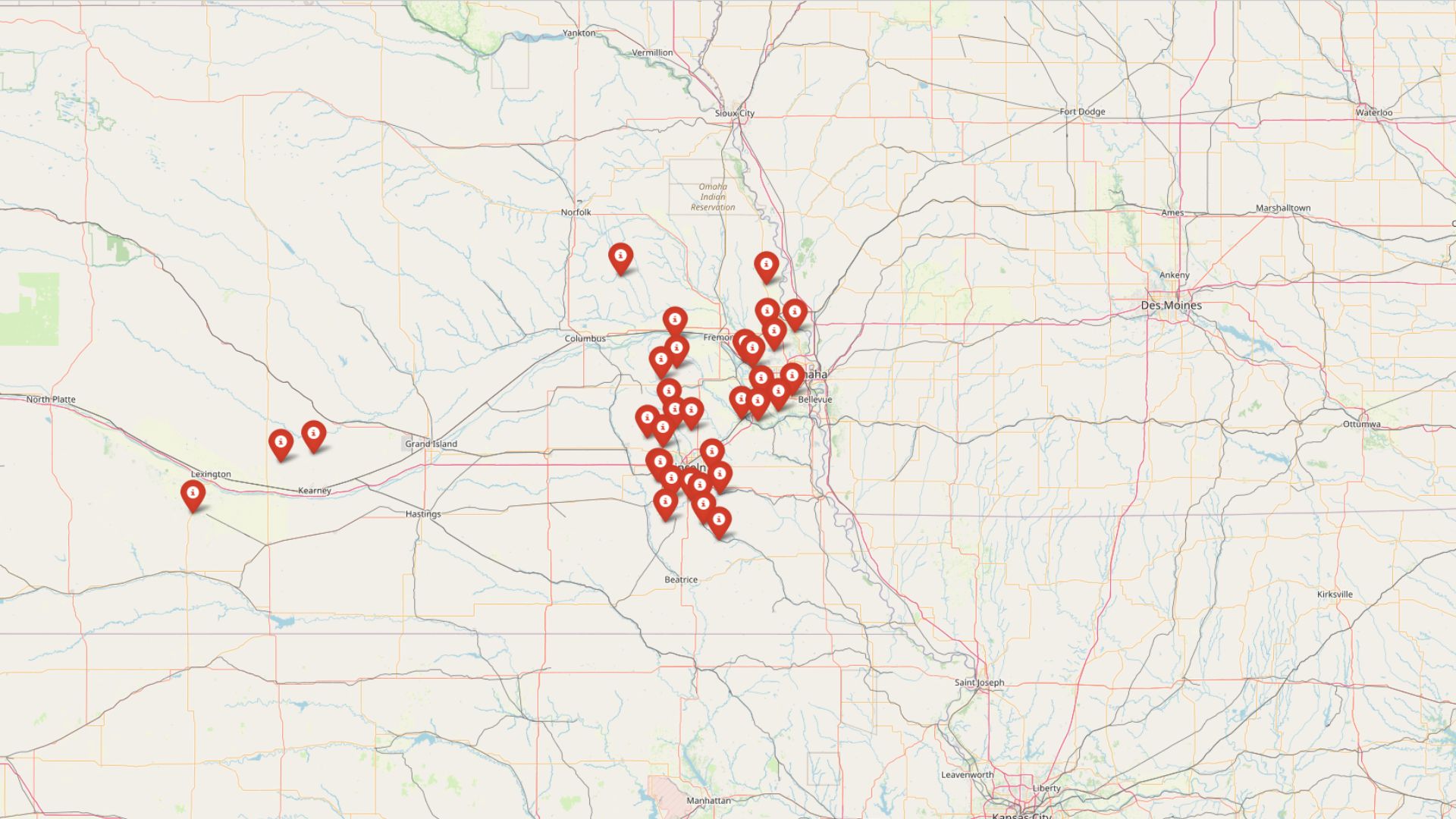
Using the latest Zillow Home Value Index data from 2025, we’ve identified the 30 most expensive towns in Kansas based on current median home prices. These communities represent Kansas’s most desirable residential areas, where property values have grown substantially over the past decade and a half.
From exclusive lakefront enclaves to upscale suburban communities, each town on this list shows distinct patterns of growth and appeal. Whether you’re considering a move, evaluating investment opportunities, or simply curious about Kansas real estate trends, this analysis reveals where the state’s highest home values are concentrated and what drives their premium pricing.
30. Gardner – 104% Home Price Increase Since 2010
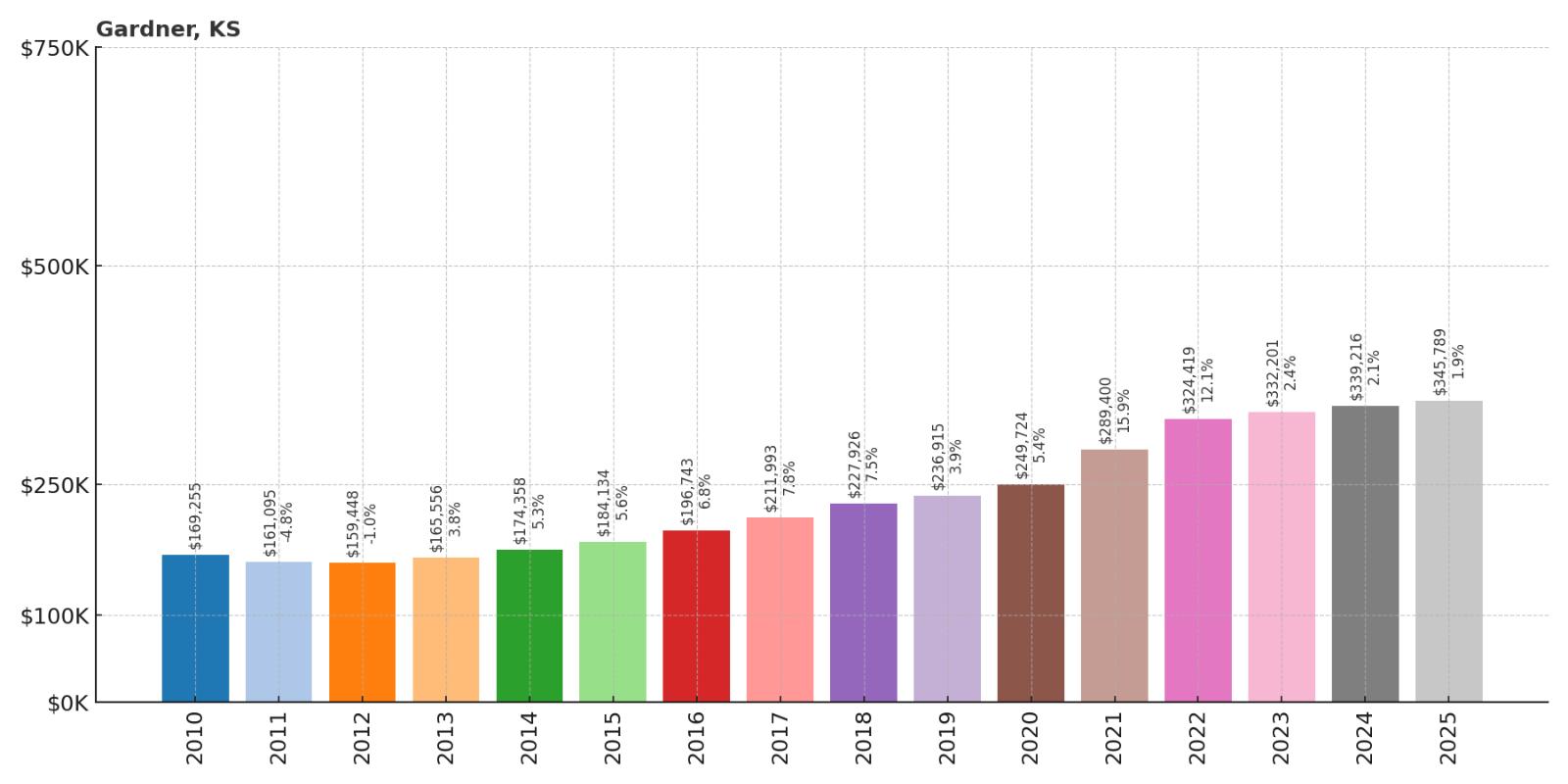
- 2010: $169,255
- 2011: $161,095
- 2012: $159,448
- 2013: $165,556
- 2014: $174,358
- 2015: $184,134
- 2016: $196,743
- 2017: $211,993
- 2018: $227,926
- 2019: $236,915
- 2020: $249,724
- 2021: $289,400
- 2022: $324,419
- 2023: $332,201
- 2024: $339,216
- 2025: $345,789
Gardner has doubled its home values since 2010, with particularly strong gains after 2020. The town experienced early setbacks in 2011 and 2012 but recovered steadily through the decade. Current median home prices reached $345,789 in 2025, reflecting consistent buyer interest in this Johnson County community.
Why Gardner?
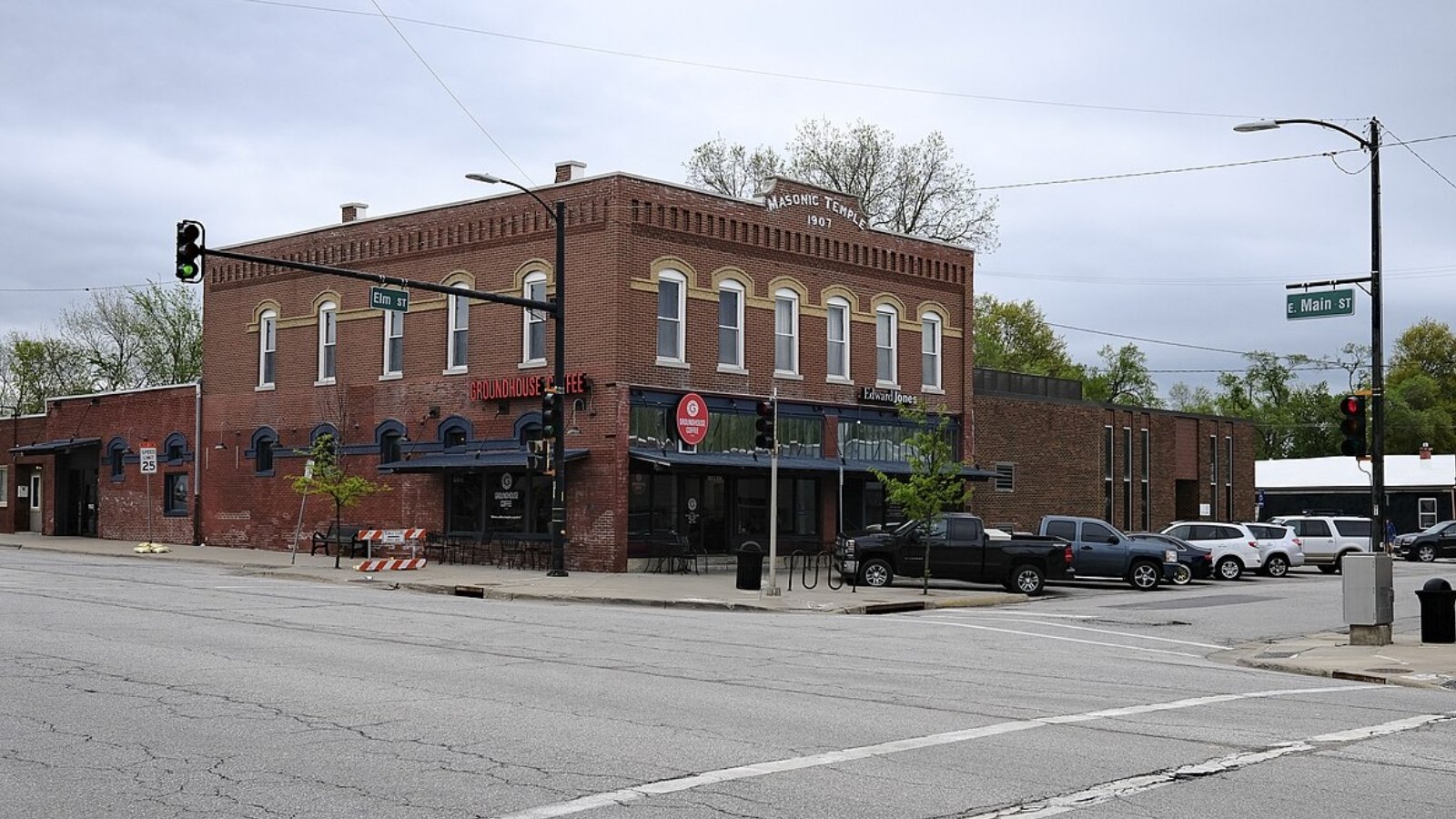
Why are people willing to pay so much to live here? What’s special about it?
Gardner offers families excellent schools through the Gardner-Edgerton School District and easy access to Kansas City employment centers. The community maintains a small-town feel while providing modern amenities and new housing developments. Residents appreciate the balance of rural charm with suburban conveniences, plus lower property taxes compared to many Johnson County neighbors.
Located along major transportation corridors, Gardner allows commuters to reach downtown Kansas City within 45 minutes. The town’s planned growth and family-friendly atmosphere make it particularly attractive to young professionals and growing families seeking affordable luxury compared to pricier Johnson County options.
How Gardner Rose to Prominence
Gardner began as an agricultural community in the 1850s, named after early settler Herbert Gardner. The town remained primarily rural until the late 20th century when Kansas City’s suburban expansion reached Johnson County’s southern areas. Gardner’s incorporation in 1957 positioned it to manage growth while preserving community character.
The town’s strategic location near Interstate 35 and Highway 56 made it attractive for residential development starting in the 1990s. Gardner capitalized on this by planning sustainable growth through quality schools and infrastructure improvements. The Gardner-Edgerton school district’s strong reputation became a major draw for families, fueling housing demand and price appreciation.
Tidbits
- Sunflower Army Ammunition Plant Legacy – Gardner sits near the former Sunflower Army Ammunition Plant, one of the largest munitions facilities during World War II, which influenced the area’s post-war development patterns.
- Celebration Park – The town’s 150-acre Celebration Park features walking trails, sports complexes, and a popular disc golf course that draws visitors from across the metro area.
- Annual Sunflower Festival – Gardner hosts one of Kansas’s premier sunflower festivals each September, celebrating both its agricultural heritage and community spirit with live music and local vendors.
29. McLouth – 177% Home Price Increase Since 2010
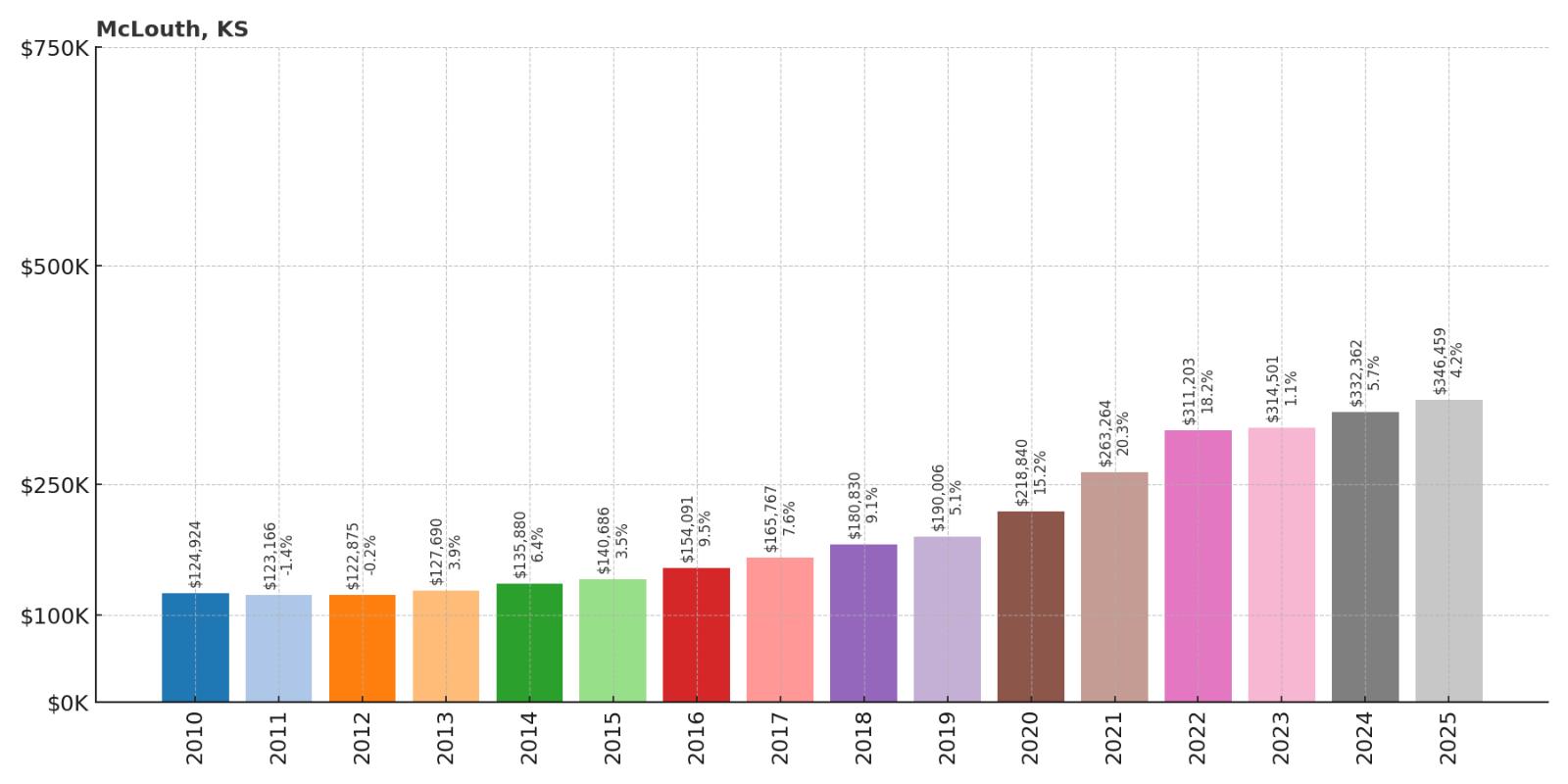
- 2010: $124,924
- 2011: $123,166
- 2012: $122,875
- 2013: $127,690
- 2014: $135,880
- 2015: $140,686
- 2016: $154,091
- 2017: $165,767
- 2018: $180,830
- 2019: $190,006
- 2020: $218,840
- 2021: $263,264
- 2022: $311,203
- 2023: $314,501
- 2024: $332,362
- 2025: $346,459
McLouth shows the second-highest percentage growth on this list, nearly tripling in value since 2010. The small Jefferson County town saw modest gains through 2019 before accelerating dramatically during the pandemic years. Home values jumped from $190,006 in 2019 to $346,459 by 2025, representing exceptional appreciation for rural Kansas.
Why McLouth?
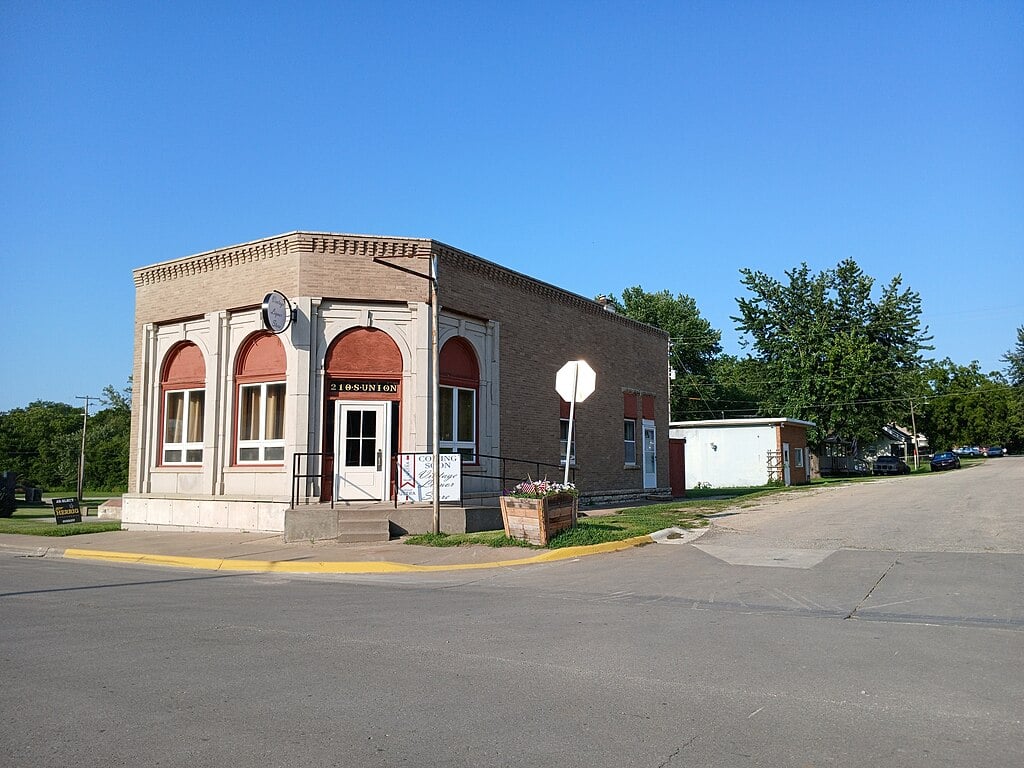
Why are people willing to pay so much to live here? What’s special about it?
McLouth appeals to buyers seeking rural tranquility within commuting distance of Kansas City and Lawrence. The town offers large lots, privacy, and significantly lower living costs than urban areas. Many residents work remotely or commute to nearby employment centers while enjoying small-town community benefits.
The area’s natural beauty includes rolling hills, mature trees, and agricultural landscapes that create a peaceful living environment. McLouth’s location provides easy access to outdoor recreation along the Kansas River while maintaining the tight-knit community atmosphere that many families desire.
How McLouth Rose to Prominence
McLouth was established in 1866 along the Leavenworth, Lawrence & Galveston Railroad, serving as a shipping point for local agricultural products. The town was named after a railroad official and grew slowly as a farming community throughout the early 20th century. For decades, McLouth remained a quiet agricultural center with stable but modest property values.
The town’s recent housing boom reflects broader trends of urban-to-rural migration accelerated by remote work capabilities. McLouth’s affordable land prices and rural character attracted buyers priced out of Johnson County markets, creating demand that significantly exceeded supply. This dynamic drove the dramatic price increases seen after 2019.
3 Interesting Tidbits
- Railroad Heritage – McLouth’s original railroad depot still stands as a reminder of its transportation origins, though passenger service ended in the mid-20th century.
- Annual Threshing Bee – The town hosts a vintage threshing demonstration each summer, celebrating its agricultural heritage with antique farm equipment displays.
- Delaware River Access – McLouth provides access to Delaware River recreation, including fishing and kayaking opportunities popular with outdoor enthusiasts.
28. Baldwin City – 127% Home Price Increase Since 2010
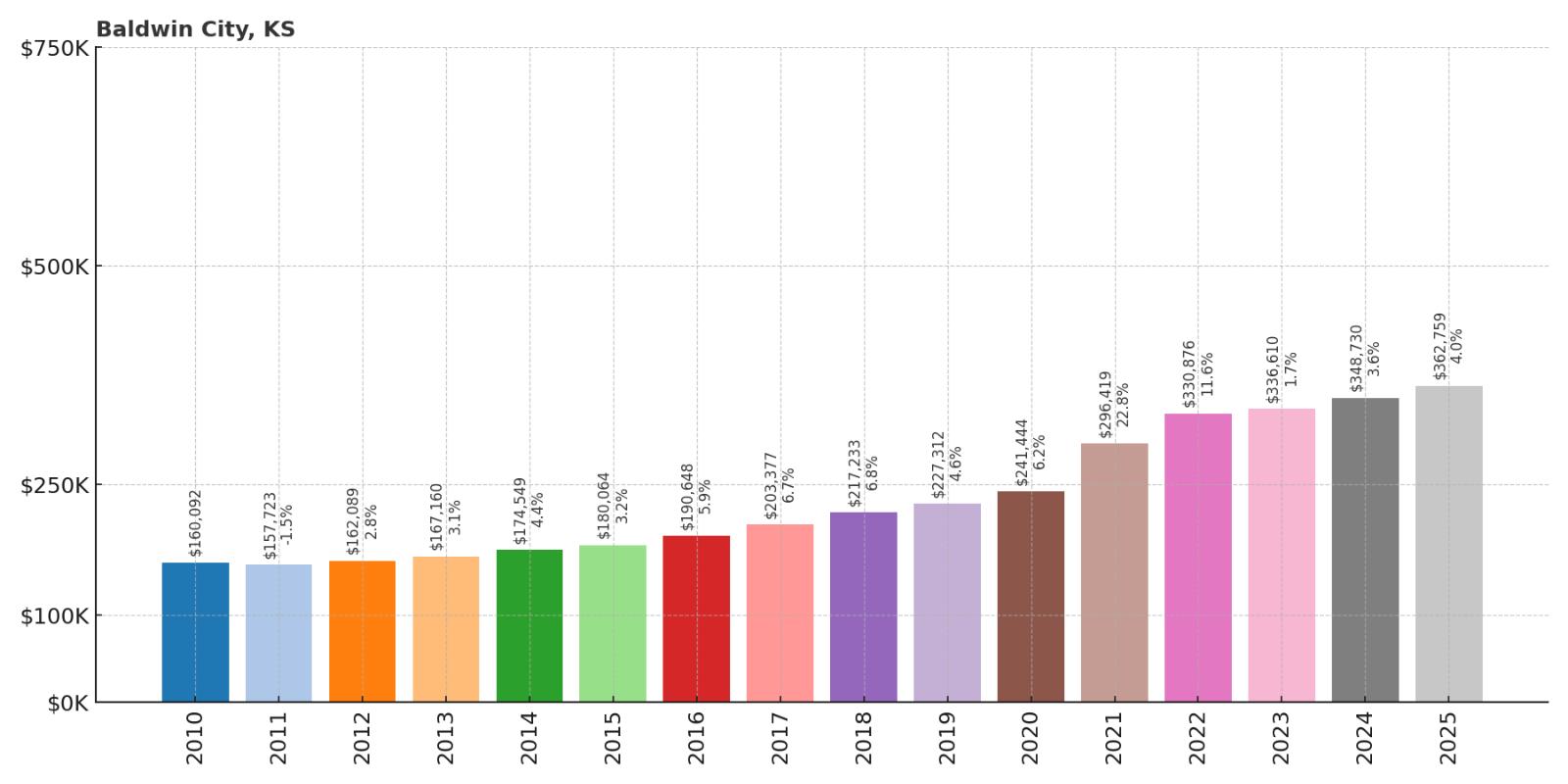
- 2010: $160,092
- 2011: $157,723
- 2012: $162,089
- 2013: $167,160
- 2014: $174,549
- 2015: $180,064
- 2016: $190,648
- 2017: $203,377
- 2018: $217,233
- 2019: $227,312
- 2020: $241,444
- 2021: $296,419
- 2022: $330,876
- 2023: $336,610
- 2024: $348,730
- 2025: $362,759
Baldwin City has shown steady appreciation throughout the 15-year period, more than doubling in value to reach $362,759 in 2025. The Douglas County town experienced consistent growth with a significant acceleration after 2020. The college town’s stable economy and educational institutions contribute to sustained housing demand.
Why Baldwin City?
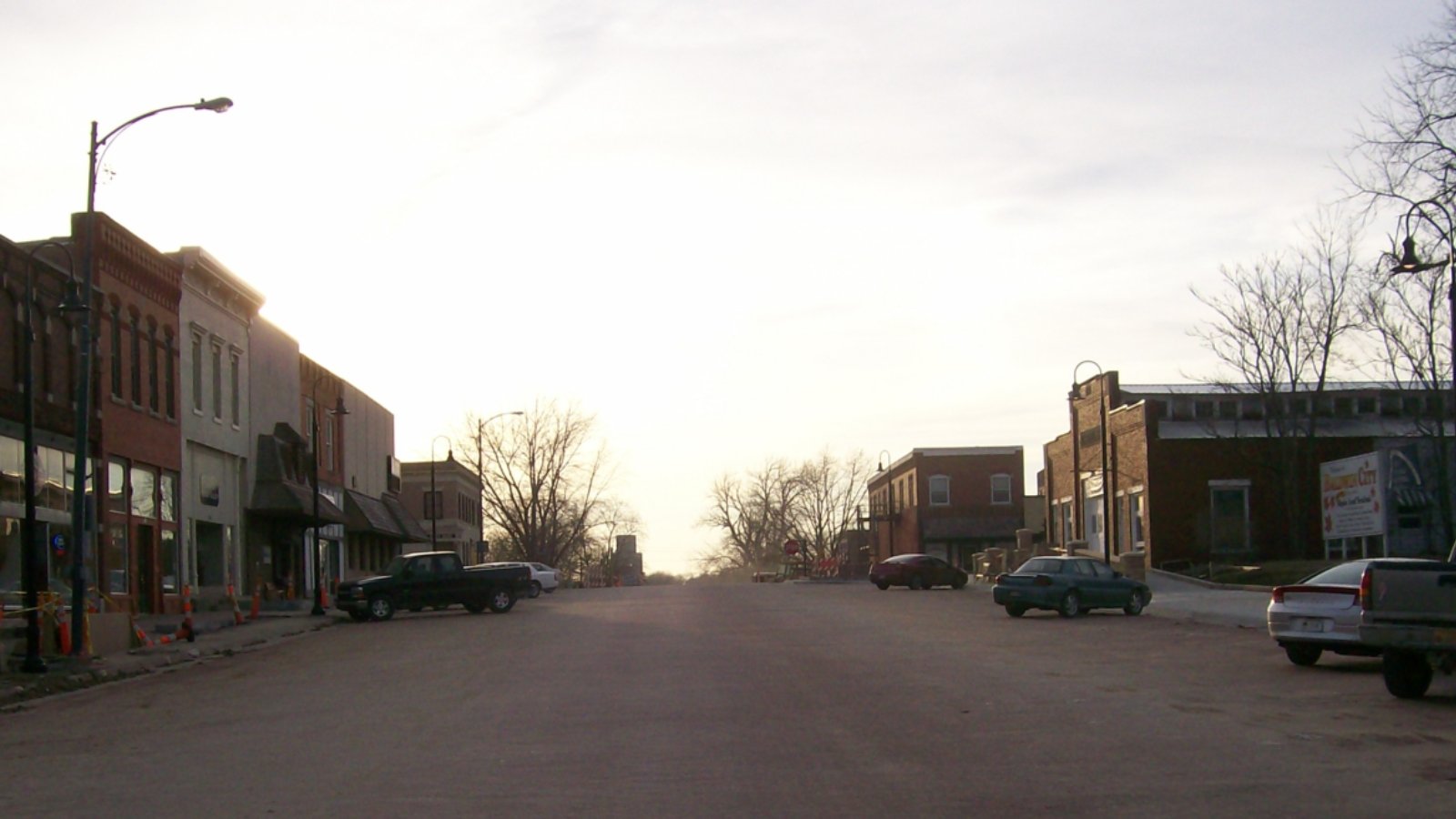
Why are people willing to pay so much to live here? What’s special about it?
Baldwin City combines small-town charm with educational excellence through Baker University, Kansas’s oldest four-year university. The college brings cultural events, athletic programs, and economic stability to the community. Families value the safe environment, quality schools, and historic downtown district.
The town’s location between Kansas City and Lawrence provides access to metropolitan amenities while maintaining affordable living costs. Baldwin City offers historic homes, tree-lined streets, and community festivals that create strong neighborhood bonds and civic pride among residents.
How Baldwin City Rose to Prominence
Founded in 1858 by abolitionists, Baldwin City played a significant role in the pre-Civil War “Bleeding Kansas” period. The town was named after John Baldwin, a Civil War-era leader who helped establish Baker University in 1858. The university became the community’s anchor institution, providing economic stability and cultural enrichment for over 160 years.
Baldwin City’s growth accelerated with the expansion of the Kansas City metropolitan area in recent decades. The town’s historic character, combined with Baker University’s presence, attracted residents seeking small-town values with educational and cultural opportunities. This unique combination drove steady housing demand and price appreciation.
3 Interesting Tidbits
- Midland Railway – Baldwin City operates a historic steam train that runs weekend excursions, making it a popular tourist destination and unique community amenity.
- Maple Leaf Festival – The town’s annual fall festival attracts over 100,000 visitors, celebrating autumn with crafts, food, and entertainment that boosts local economic activity.
- Old Castle Museum – Baker University’s historic Old Castle building, constructed in 1858, serves as a museum and symbol of the town’s educational heritage.
27. Paola – 151% Home Price Increase Since 2010
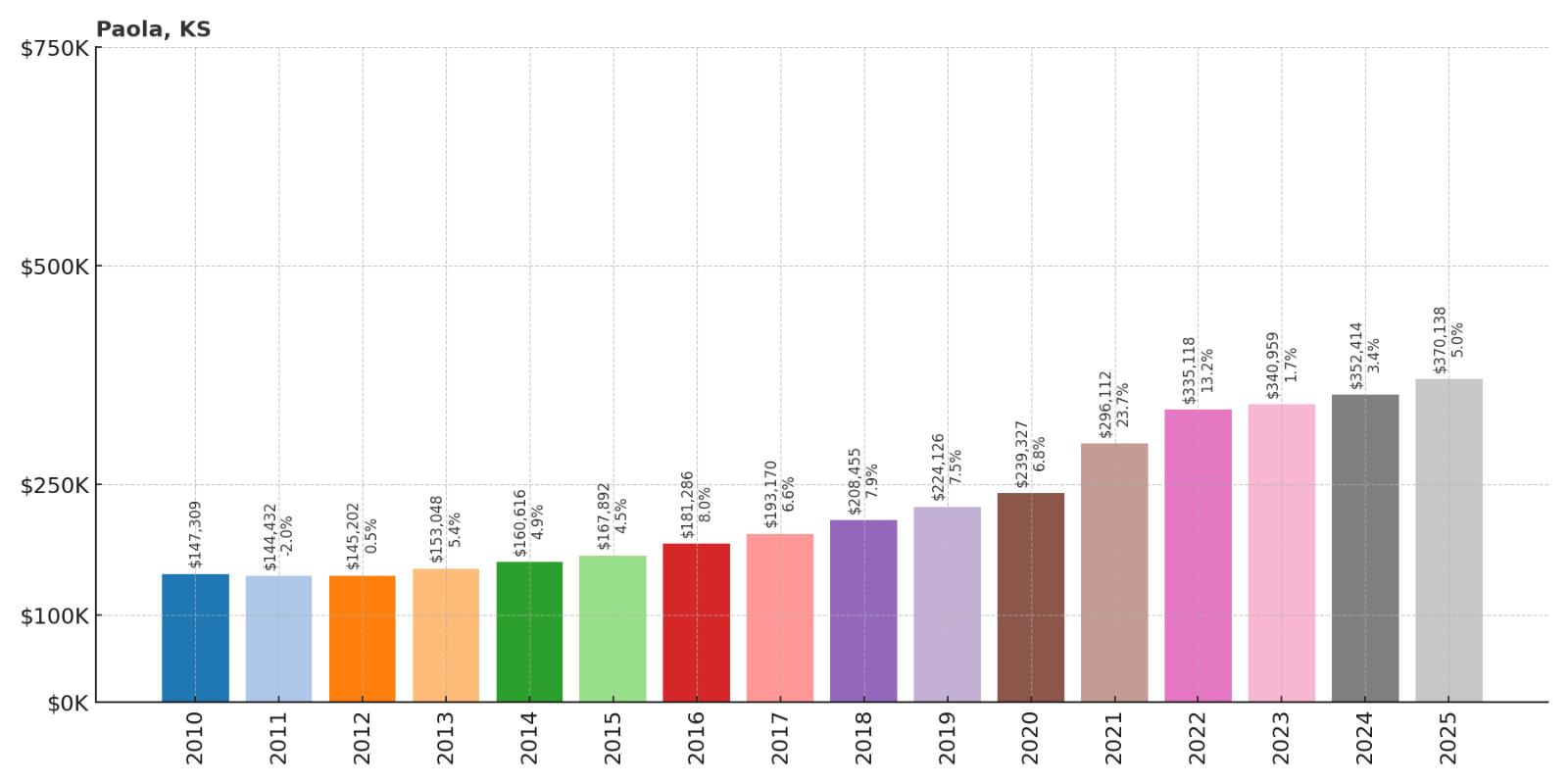
- 2010: $147,309
- 2011: $144,432
- 2012: $145,202
- 2013: $153,048
- 2014: $160,616
- 2015: $167,892
- 2016: $181,286
- 2017: $193,170
- 2018: $208,455
- 2019: $224,126
- 2020: $239,327
- 2021: $296,112
- 2022: $335,118
- 2023: $340,959
- 2024: $352,414
- 2025: $370,138
Paola has experienced strong growth, increasing 151% since 2010 to reach $370,138 in 2025. The Miami County seat showed consistent appreciation through the decade, with notable acceleration after 2020. As the county’s largest city, Paola benefits from both government employment and regional commerce.
Why Paola?
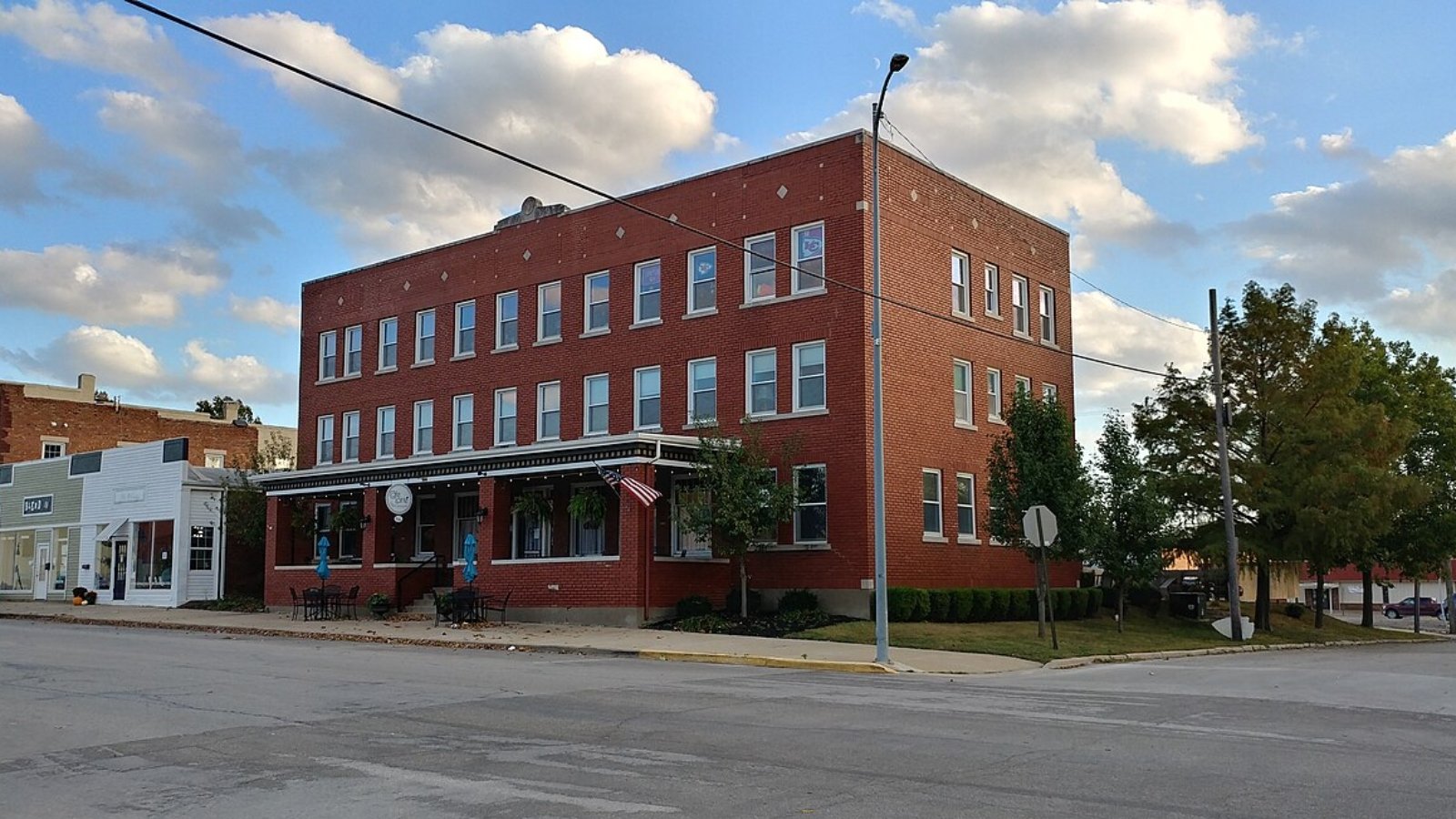
Why are people willing to pay so much to live here? What’s special about it?
Paola serves as Miami County’s governmental and commercial hub, providing stable employment and essential services. The town offers excellent schools, historic downtown shopping, and recreational opportunities at nearby Hillsdale Lake. Residents appreciate the balance of small-town community with county seat amenities.
The town’s strategic location along Highway 169 provides easy access to Kansas City employment while maintaining rural character and affordable living costs. Paola’s growing industrial base and government services create economic stability that supports steady housing demand and value appreciation.
How Paola Rose to Prominence
Paola was founded in 1855 and named after Peoria chief Baptiste Peoria, reflecting the area’s Native American heritage. The town became Miami County’s seat in 1859, establishing its role as a regional administrative center. Early growth centered on agriculture and railroad transportation, with the Missouri Pacific Railroad connecting Paola to broader markets.
Modern growth began in the 1970s as Kansas City’s metropolitan expansion reached Miami County. Paola capitalized on its county seat status and transportation access to attract both residents and businesses. The town’s proximity to Hillsdale Lake and state recreational areas added to its appeal for families seeking outdoor recreation opportunities.
3 Interesting Tidbits
- Hillsdale Lake – Paola sits near 4,500-acre Hillsdale Lake, offering boating, fishing, and camping opportunities that enhance the area’s recreational appeal.
- Historic Courthouse – The 1898 Miami County Courthouse anchors downtown Paola and represents the town’s longstanding role as a governmental center.
- Root Fest – Paola’s annual Root Fest celebrates the area’s agricultural heritage with live music, local vendors, and community activities that strengthen civic bonds.
26. Tonganoxie – 152% Home Price Increase Since 2010
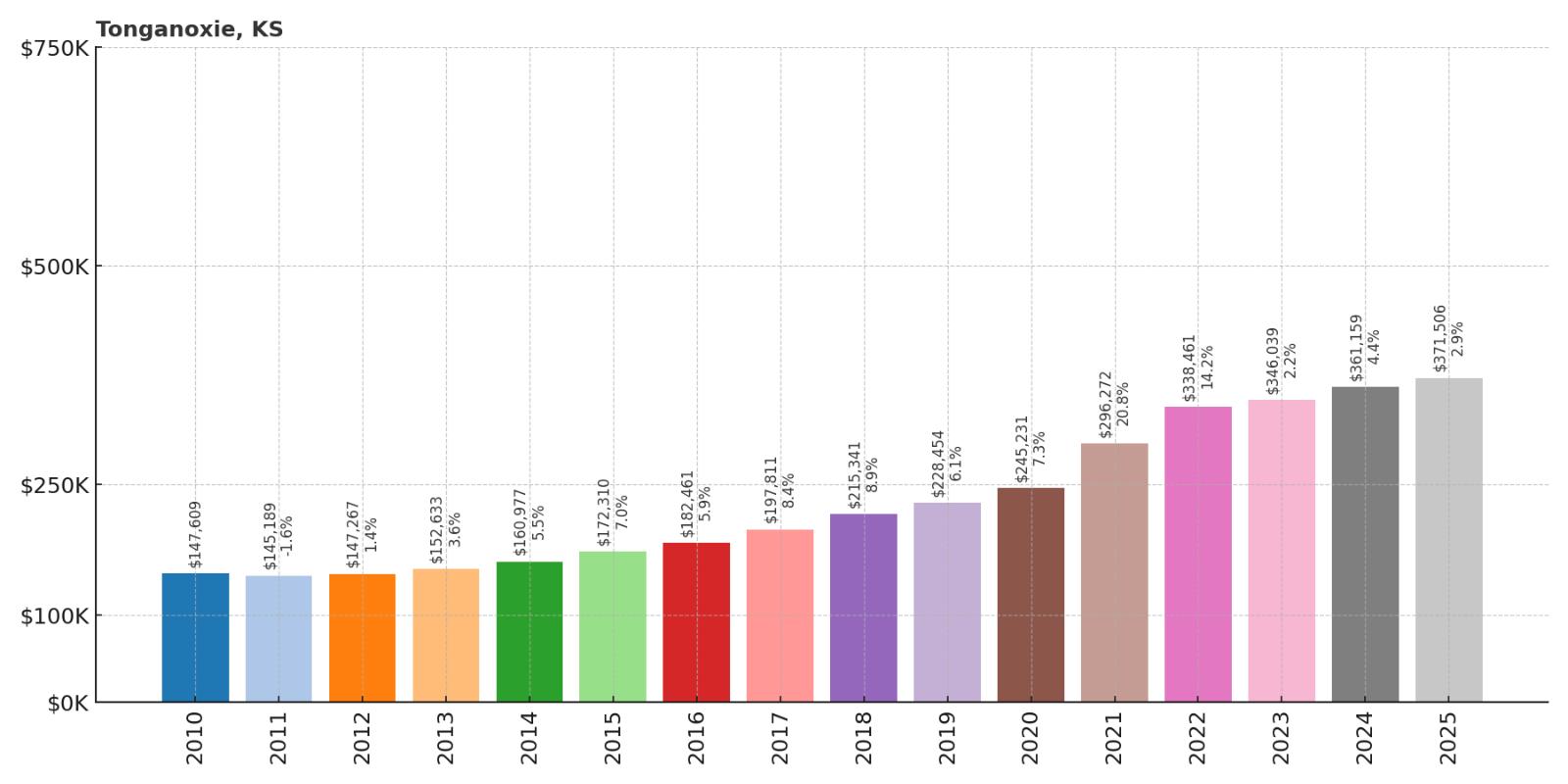
- 2010: $147,609
- 2011: $145,189
- 2012: $147,267
- 2013: $152,633
- 2014: $160,977
- 2015: $172,310
- 2016: $182,461
- 2017: $197,811
- 2018: $215,341
- 2019: $228,454
- 2020: $245,231
- 2021: $296,272
- 2022: $338,461
- 2023: $346,039
- 2024: $361,159
- 2025: $371,506
Tonganoxie has demonstrated strong and steady growth, increasing 152% since 2010 to reach $371,506 in 2025. The Leavenworth County town maintained consistent appreciation throughout the period, with particularly strong gains after 2020. The community’s proximity to Kansas City and quality schools drive continued demand.
Why Tonganoxie?

Why are people willing to pay so much to live here? What’s special about it?
Tonganoxie offers an ideal combination of small-town community and metropolitan access for Kansas City commuters. The town features excellent schools, safe neighborhoods, and family-friendly amenities including parks and recreational facilities. Residents value the community’s commitment to controlled growth and maintaining quality of life.
The area provides spacious lots and newer housing developments while preserving rural character and agricultural landscapes. Tonganoxie’s location along Highway 24 offers direct access to Leavenworth, Kansas City, and Lawrence, making it attractive for professionals working throughout the region.
How Tonganoxie Rose to Prominence
Tonganoxie was established in the 1860s along the Leavenworth, Lawrence & Galveston Railroad and named after Delaware Chief Tonganoxie. The town served as an agricultural shipping point and remained primarily rural throughout most of its history. Early settlers were drawn by fertile soil and transportation access.
Modern development accelerated in the 1990s as Kansas City’s suburban expansion reached Leavenworth County. Tonganoxie positioned itself as a desirable suburban community by investing in schools, infrastructure, and controlled residential development. The town’s strategic planning preserved its small-town character while accommodating growth from Kansas City area families.
3 Interesting Tidbits
- Delaware Heritage – The town name honors Chief Tonganoxie of the Delaware tribe, reflecting the area’s Native American history before European settlement.
- Chieftain Park – Tonganoxie’s main recreational facility includes baseball fields, playgrounds, and walking trails popular with families throughout Leavenworth County.
- Days of Old Festival – The annual summer festival celebrates local history with period costumes, crafts demonstrations, and community entertainment that draws visitors from neighboring communities.
25. Lecompton – 186% Home Price Increase Since 2010
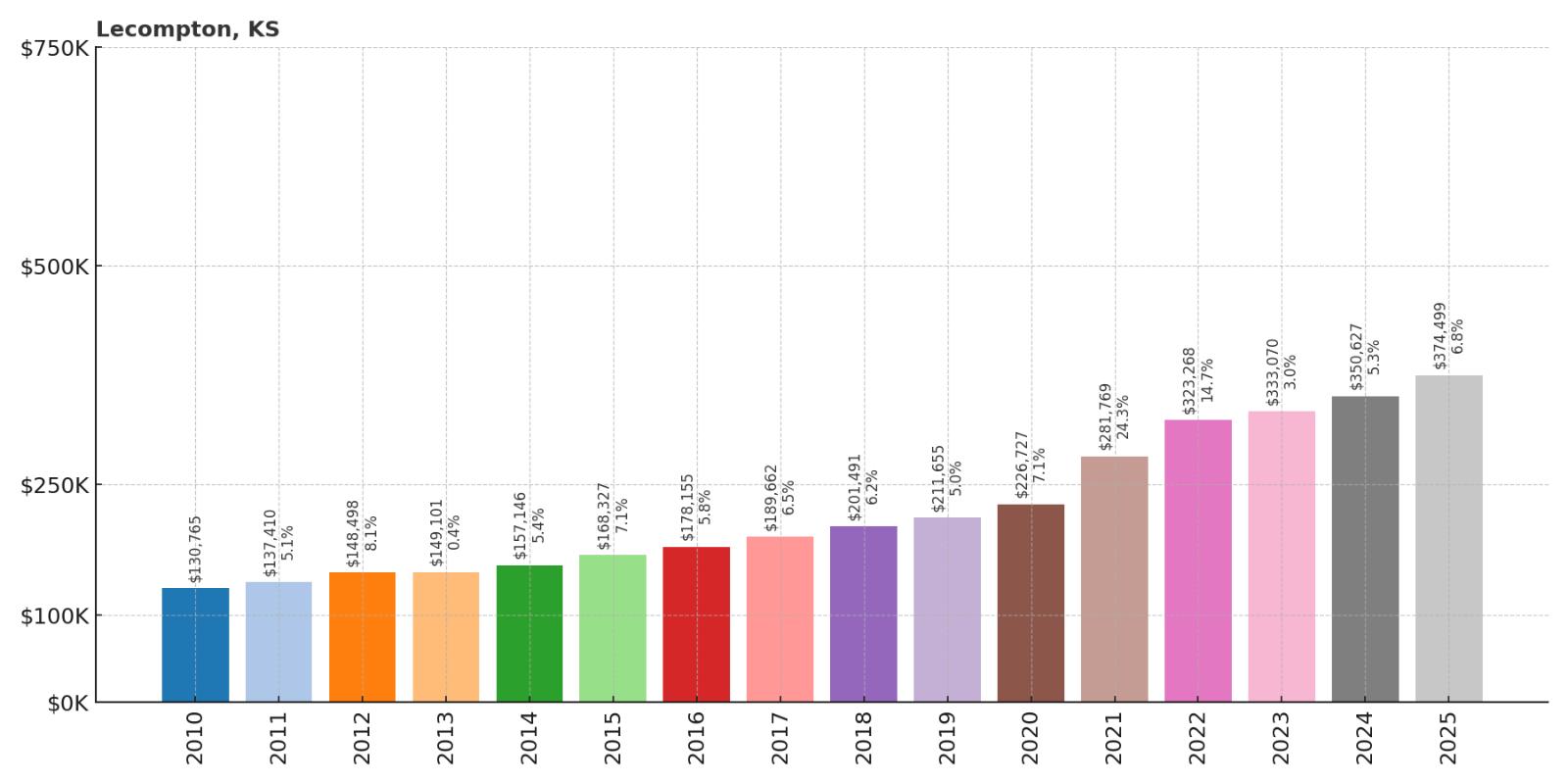
- 2010: $130,765
- 2011: $137,410
- 2012: $148,498
- 2013: $149,101
- 2014: $157,146
- 2015: $168,327
- 2016: $178,155
- 2017: $189,662
- 2018: $201,491
- 2019: $211,655
- 2020: $226,727
- 2021: $281,769
- 2022: $323,268
- 2023: $333,070
- 2024: $350,627
- 2025: $374,499
Lecompton shows dramatic growth with an 186% increase since 2010, reaching $374,499 in 2025. The Douglas County town maintained steady appreciation throughout the period, with significant acceleration after 2020. This historic community benefits from proximity to Lawrence and Kansas City while offering unique historical significance.
Why Lecompton?
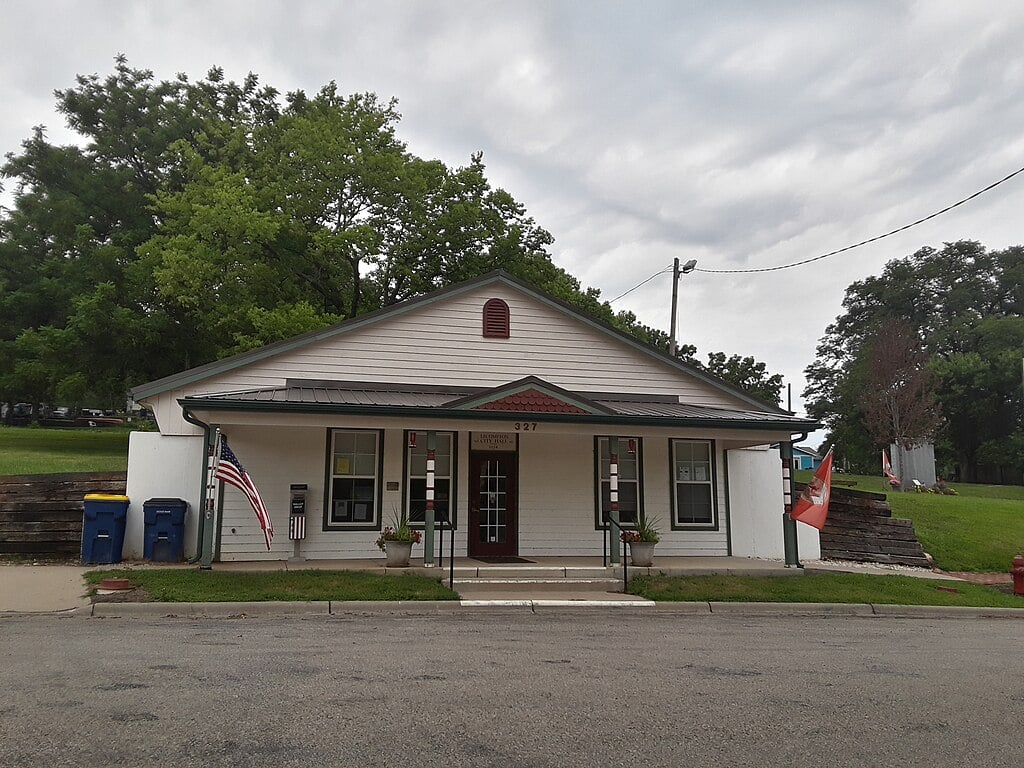
Why are people willing to pay so much to live here? What’s special about it?
Lecompton offers residents a unique combination of American history and modern convenience near Lawrence and Kansas City. The town’s rich Civil War-era heritage, including the territorial capitol building, creates a distinctive community identity. Families are drawn to the excellent schools and safe, small-town environment.
The area provides affordable housing compared to Lawrence while maintaining easy access to the University of Kansas and metropolitan employment opportunities. Lecompton’s location along the Kansas River offers recreational opportunities and scenic beauty that enhance property values and quality of life.
How Lecompton Rose to Prominence
Lecompton served as the territorial capital of Kansas from 1855 to 1861, playing a crucial role in the pre-Civil War conflict over slavery. The town was named after Samuel LeCompte, chief justice of the territorial supreme court. During its brief period as capital, Lecompton was at the center of national political attention regarding Kansas statehood.
After losing capital status to Topeka, Lecompton remained a small agricultural community for over a century. Recent growth reflects its proximity to Lawrence and the Kansas City metropolitan area, as residents seek historic charm combined with modern amenities. The town’s preserved 19th-century buildings and museums attract both residents and tourists.
3 Interesting Tidbits
- Territorial Capitol Museum – The original territorial capitol building now serves as a museum dedicated to Kansas’s pre-statehood period and the national slavery debate.
- Constitution Hall – This historic building where the Lecompton Constitution was drafted remains a significant landmark in American Civil War history.
- Kansas River Access – Lecompton provides excellent access to Kansas River recreation, including fishing, kayaking, and nature observation along scenic riverbanks.
24. Andale – 81% Home Price Increase Since 2010
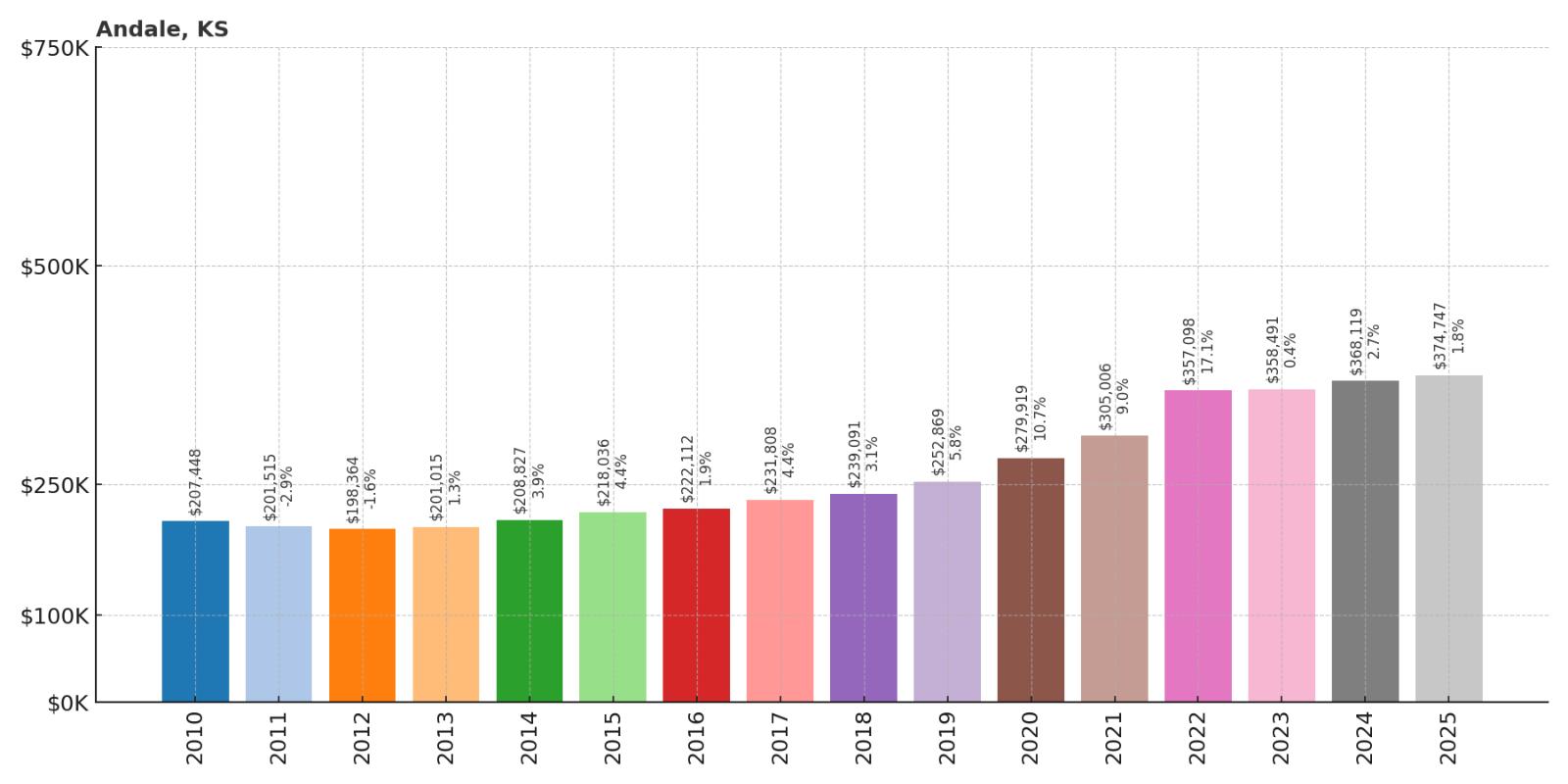
- 2010: $207,448
- 2011: $201,515
- 2012: $198,364
- 2013: $201,015
- 2014: $208,827
- 2015: $218,036
- 2016: $222,112
- 2017: $231,808
- 2018: $239,091
- 2019: $252,869
- 2020: $279,919
- 2021: $305,006
- 2022: $357,098
- 2023: $358,491
- 2024: $368,119
- 2025: $374,747
Andale shows solid growth with an 81% increase since 2010, reaching $374,747 in 2025. The Sedgwick County town started from a higher base price than many communities and maintained steady appreciation. The community benefits from proximity to Wichita while offering small-town living with modern amenities.
Why Andale?
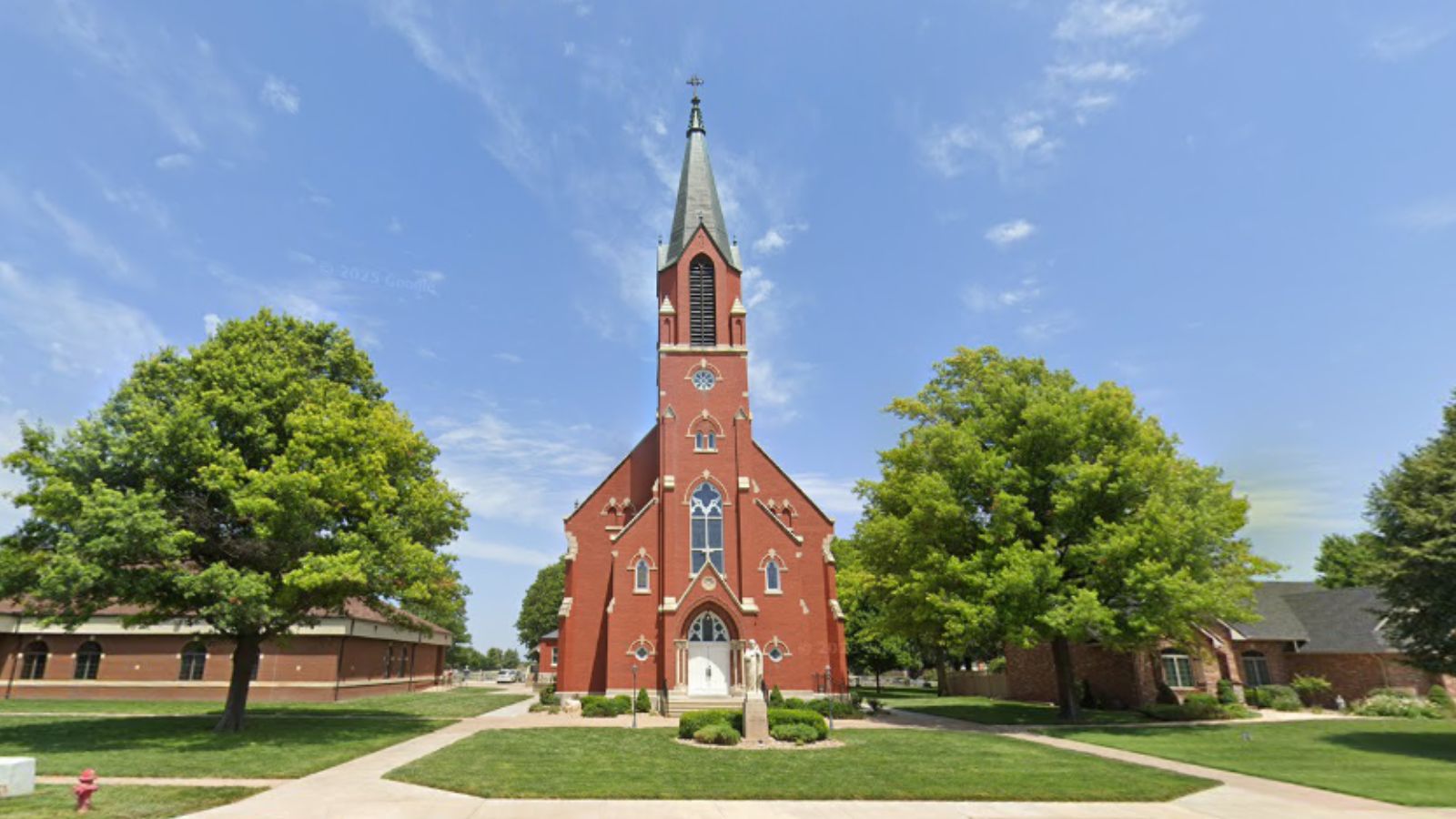
Why are people willing to pay so much to live here? What’s special about it?
Andale appeals to families seeking excellent schools and safe neighborhoods within commuting distance of Wichita employment. The town offers a strong sense of community, quality recreational facilities, and modern housing developments. Residents appreciate the blend of small-town values with suburban conveniences.
The area provides larger lots and newer homes compared to urban alternatives while maintaining easy access to Wichita’s amenities and employment opportunities. Andale’s commitment to planned growth and infrastructure investment creates an attractive environment for families and professionals.
How Andale Rose to Prominence
Andale was founded in the late 1800s as an agricultural community in Sedgwick County. The town remained small and rural throughout most of its history, serving local farming operations and maintaining a close-knit community atmosphere. Early growth was modest and centered on agricultural support services.
Modern development began in the 1980s as Wichita’s suburban expansion reached surrounding communities. Andale positioned itself as a family-friendly alternative to urban living, investing in schools and recreational facilities. The town’s strategic location and quality amenities attracted families seeking suburban comfort with small-town character.
3 Interesting Tidbits
- Andale High School Athletics – The school’s athletic programs, particularly football, have achieved state-level recognition and help build strong community identity and pride.
- Harvey County Line – Andale straddles the Sedgwick-Harvey county line, providing residents access to amenities and services from both counties.
- Community Center – The town’s modern community center serves as a hub for recreation, events, and civic activities that strengthen neighborhood bonds.
23. Saint George – 85% Home Price Increase Since 2010
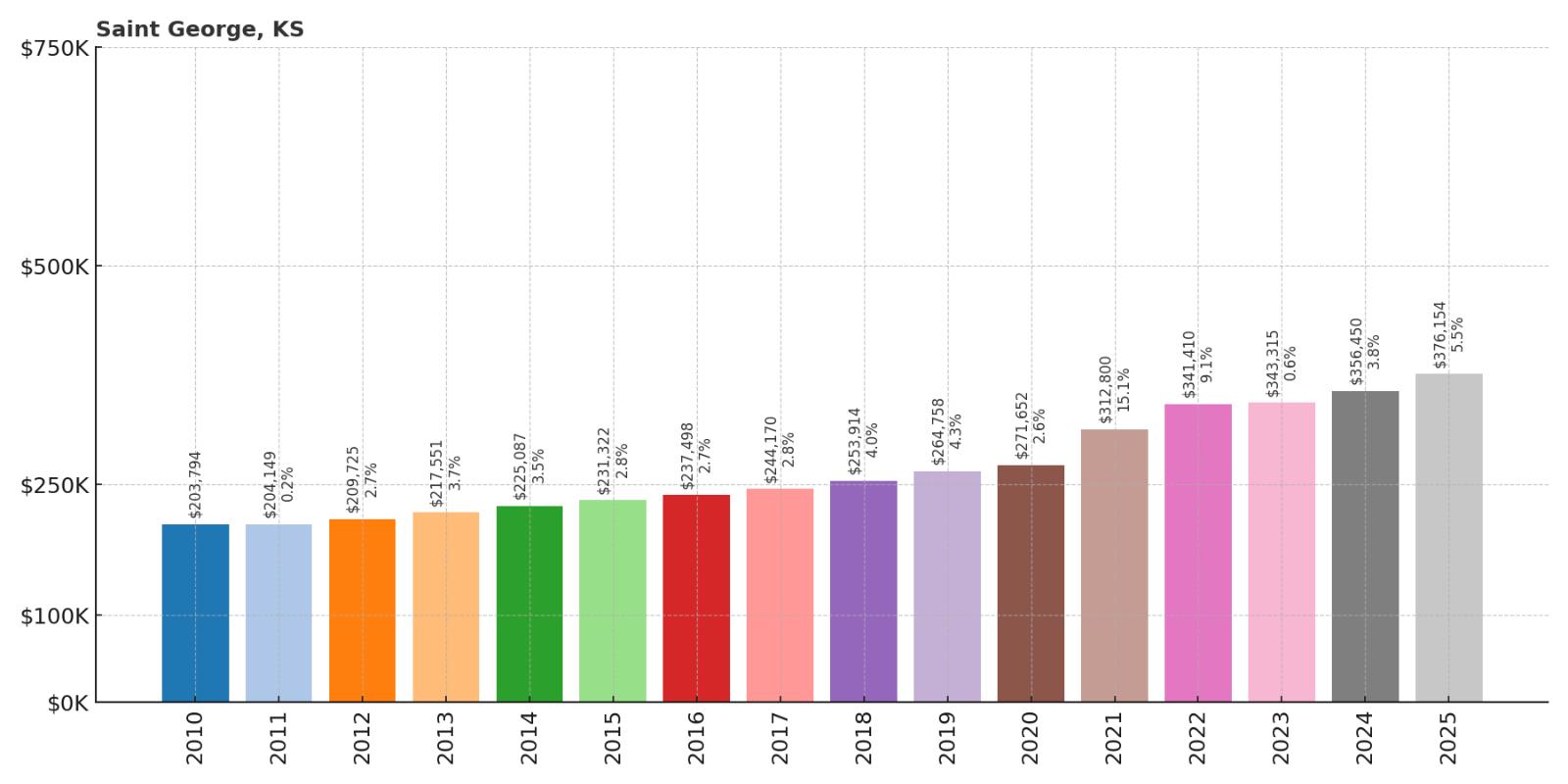
- 2010: $203,794
- 2011: $204,149
- 2012: $209,725
- 2013: $217,551
- 2014: $225,087
- 2015: $231,322
- 2016: $237,498
- 2017: $244,170
- 2018: $253,914
- 2019: $264,758
- 2020: $271,652
- 2021: $312,800
- 2022: $341,410
- 2023: $343,315
- 2024: $356,450
- 2025: $376,154
Saint George demonstrates consistent growth with an 85% increase since 2010, reaching $376,154 in 2025. The Pottawatomie County town maintained steady appreciation throughout the period with acceleration after 2020. The community benefits from proximity to Manhattan and Topeka while offering rural tranquility.
Why Saint George?

Why are people willing to pay so much to live here? What’s special about it?
Saint George offers residents peaceful rural living within commuting distance of Manhattan and Kansas State University. The town provides excellent schools, safe neighborhoods, and a strong agricultural heritage that appeals to families seeking community values. Many residents appreciate the slower pace of life and outdoor recreation opportunities.
The area’s location in the Flint Hills region offers scenic beauty and recreational access while maintaining reasonable commutes to employment centers. Saint George’s small size creates a close-knit community where neighbors know each other and civic engagement remains high.
How Saint George Rose to Prominence
Saint George was established in the 1870s as a rural farming community in Pottawatomie County. The town was named after an early settler and remained primarily agricultural throughout most of its history. Early growth centered on grain production and livestock operations that utilized the fertile Flint Hills soils.
Recent development reflects the expansion of the Manhattan metropolitan area and Kansas State University’s influence on regional housing demand. Saint George’s rural character and proximity to educational and employment opportunities in Manhattan have attracted families seeking small-town living with access to university amenities and cultural opportunities.
3 Interesting Tidbits
- Flint Hills Location – Saint George sits in the scenic Flint Hills region, offering residents access to native prairie landscapes and outdoor recreation opportunities.
- Rock Creek Lake – The nearby lake provides fishing, boating, and camping opportunities popular with residents and visitors from throughout the region.
- Agricultural Heritage – The town maintains strong ties to agriculture, with many residents involved in farming or ranching operations in the surrounding Flint Hills.
22. Berryton – 121% Home Price Increase Since 2010
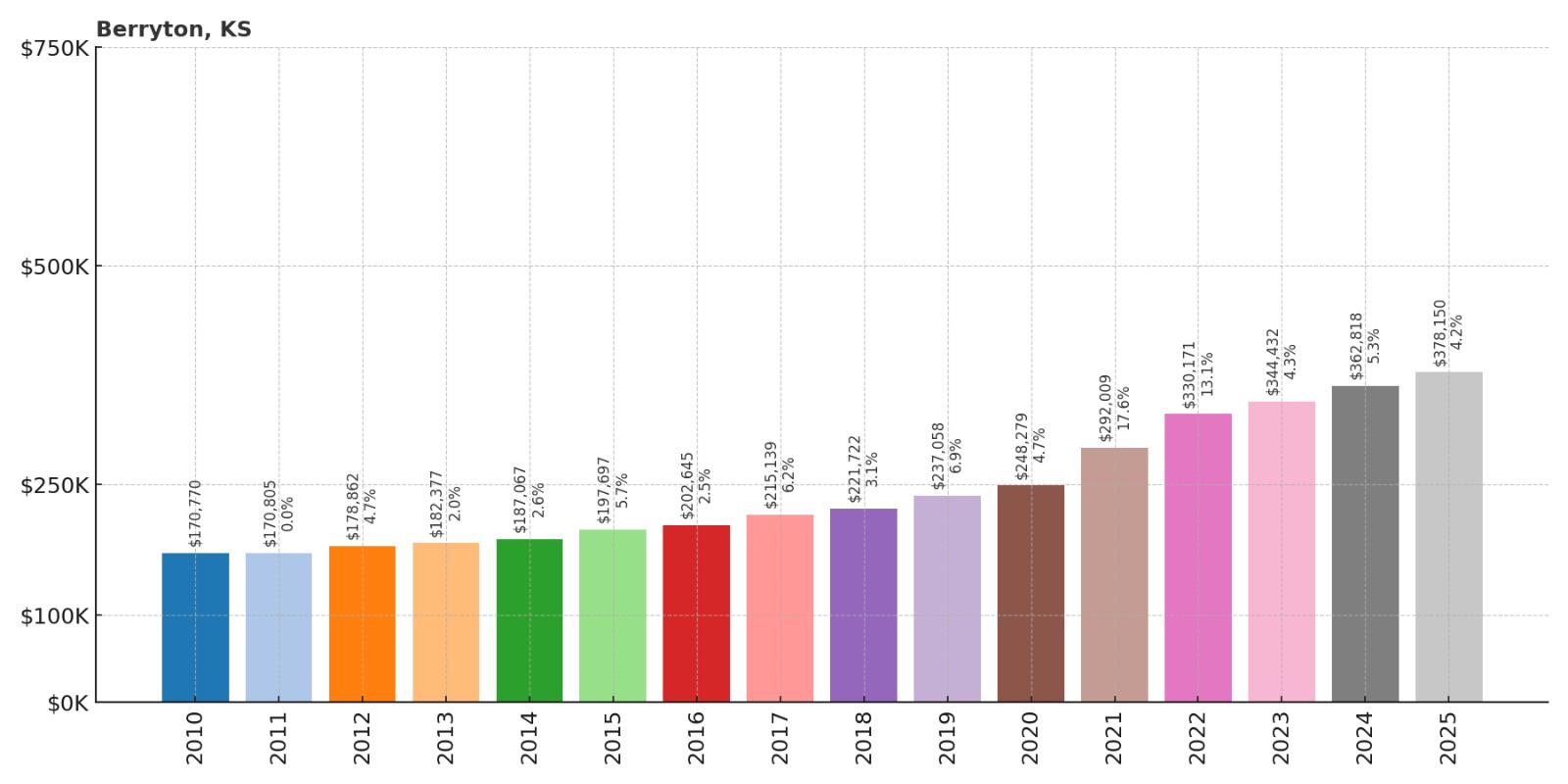
- 2010: $170,770
- 2011: $170,805
- 2012: $178,862
- 2013: $182,377
- 2014: $187,067
- 2015: $197,697
- 2016: $202,645
- 2017: $215,139
- 2018: $221,722
- 2019: $237,058
- 2020: $248,279
- 2021: $292,009
- 2022: $330,171
- 2023: $344,432
- 2024: $362,818
- 2025: $378,150
Berryton shows strong appreciation with a 121% increase since 2010, reaching $378,150 in 2025. The Shawnee County community maintained steady growth throughout the period, with notable acceleration after 2020. This suburban area benefits from proximity to Topeka while offering more spacious residential options.
Why Berryton?
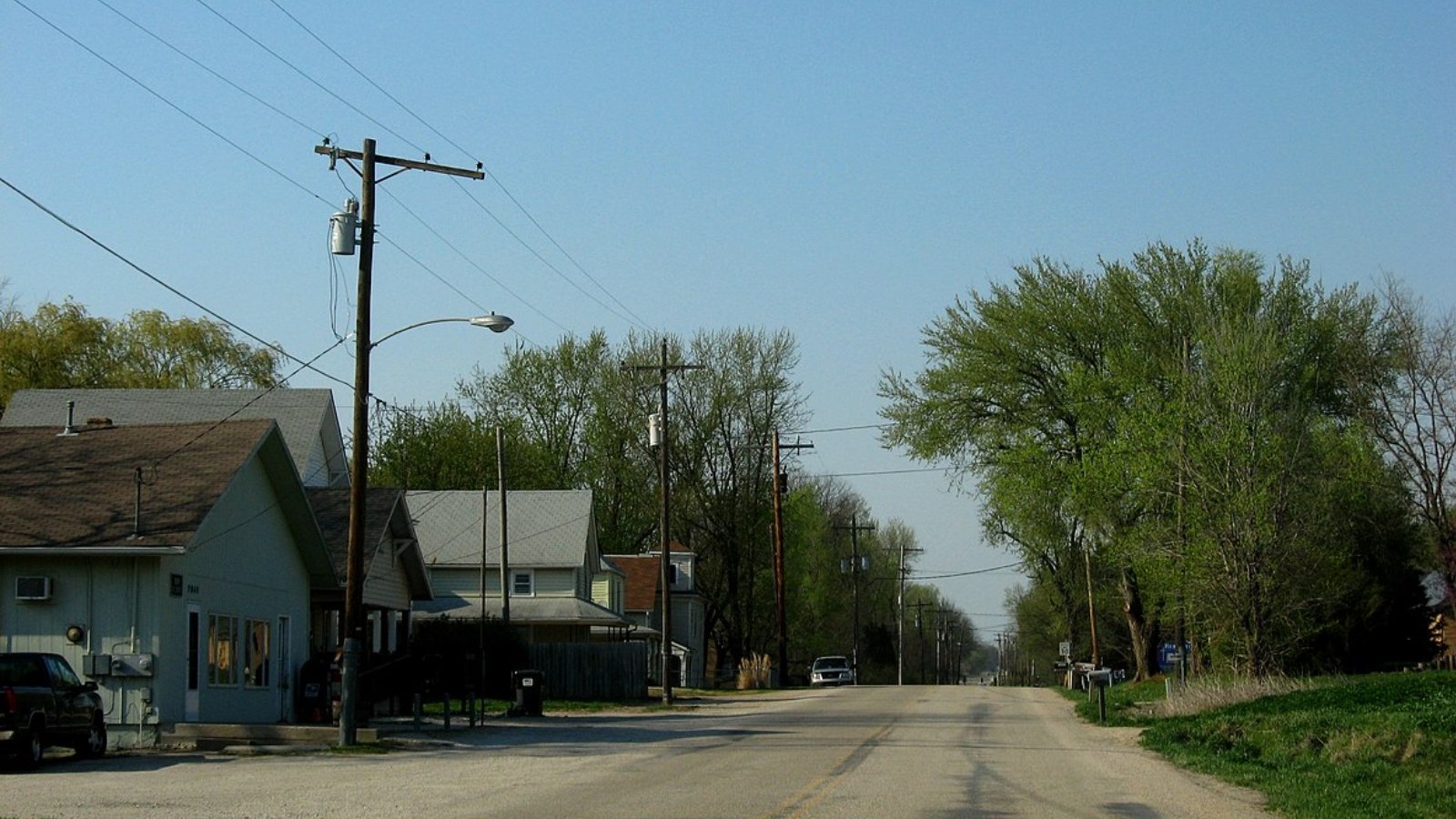
Why are people willing to pay so much to live here? What’s special about it?
Berryton offers residents suburban convenience with rural character just minutes from Topeka’s employment and cultural opportunities. The area features larger lots, newer homes, and excellent schools that attract families seeking space and quality education. Many residents work in Topeka but prefer the quieter residential environment.
The community provides easy access to recreational opportunities including nearby lakes and parks while maintaining the amenities of suburban living. Berryton’s location allows residents to enjoy small-town atmosphere while accessing the services and employment opportunities of the state capital.
How Berryton Rose to Prominence
Berryton developed as a suburban community south of Topeka in the mid-20th century, serving state government employees and professionals seeking residential alternatives to urban living. The area remained largely rural until suburban expansion from Topeka created demand for residential development in the 1970s and 1980s.
Growth accelerated as Topeka’s metropolitan area expanded and families sought larger lots and newer housing options. Berryton’s unincorporated status allowed flexible development while maintaining lower property taxes. The area’s schools and family-friendly environment attracted residents throughout the Topeka metropolitan region.
3 Interesting Tidbits
- Lake Shawnee Access – Berryton residents enjoy easy access to Lake Shawnee, offering boating, fishing, and swimming opportunities just minutes from home.
- State Government Employment – Many residents work for Kansas state government in nearby Topeka, creating a stable employment base that supports housing demand.
- Unincorporated Status – Berryton remains unincorporated, allowing residents to benefit from county services while maintaining lower property taxes than incorporated cities.
21. Viola – 126% Home Price Increase Since 2010
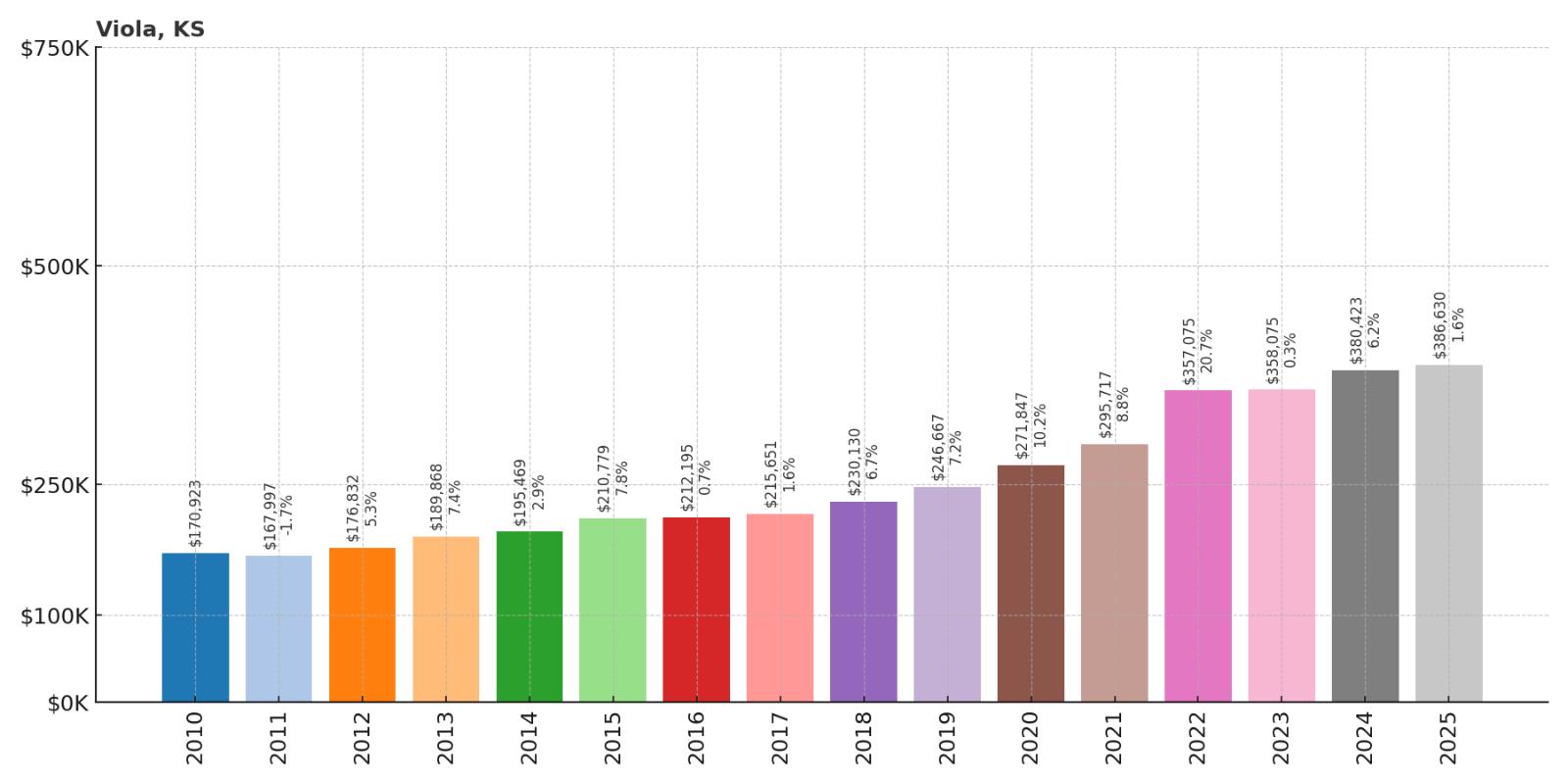
- 2010: $170,923
- 2011: $167,997
- 2012: $176,832
- 2013: $189,868
- 2014: $195,469
- 2015: $210,779
- 2016: $212,195
- 2017: $215,651
- 2018: $230,130
- 2019: $246,667
- 2020: $271,847
- 2021: $295,717
- 2022: $357,075
- 2023: $358,075
- 2024: $380,423
- 2025: $386,630
Viola demonstrates solid growth with a 126% increase since 2010, reaching $386,630 in 2025. The Sedgwick County town showed steady appreciation through 2021, then accelerated significantly in 2022. The rural community appeals to buyers seeking country living within reach of Wichita employment and amenities.
Why Viola?
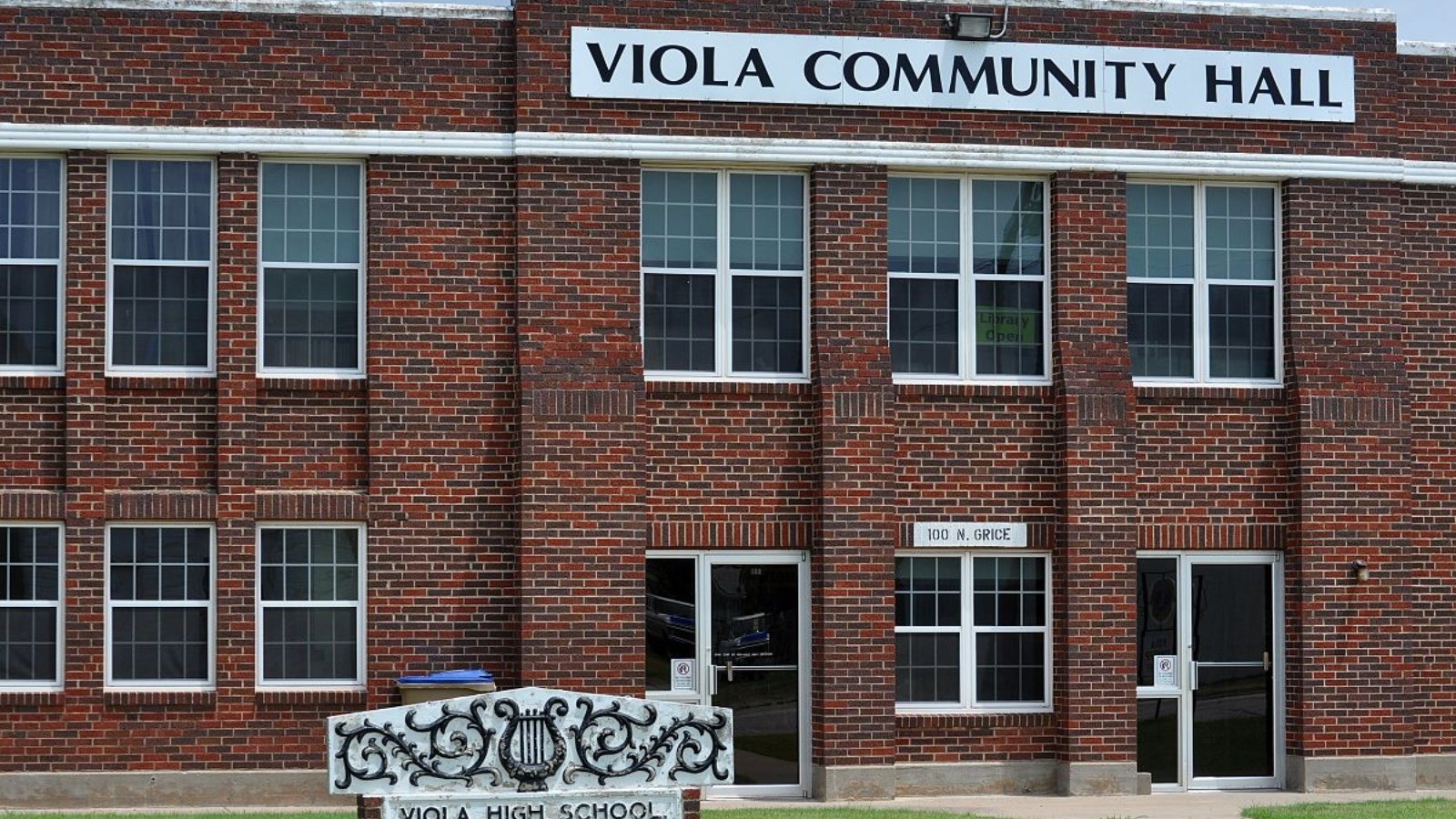
Why are people willing to pay so much to live here? What’s special about it?
Viola offers residents peaceful rural living with quick access to Wichita’s employment and cultural opportunities. The small community provides excellent schools, large lots, and a safe environment that appeals to families. Many residents appreciate the agricultural character and close-knit community atmosphere.
The area’s location allows for country living while maintaining reasonable commutes to urban amenities and jobs. Viola’s rural character includes working farms, open spaces, and slower-paced lifestyle that contrasts favorably with suburban density while providing modern conveniences.
How Viola Rose to Prominence
Viola was established in the late 1800s as a small farming community in southeastern Sedgwick County. The town was named after an early settler’s daughter and remained primarily agricultural throughout most of its history. Early development centered on grain farming and livestock operations typical of the region.
Modern growth began in the 1990s as Wichita’s suburban expansion reached surrounding rural areas. Viola’s agricultural character and proximity to urban amenities attracted families seeking larger properties and rural lifestyle benefits. The community’s small size and rural setting became selling points for buyers escaping urban congestion.
3 Interesting Tidbits
- One-Room Schoolhouse Heritage – Viola’s educational history includes a historic one-room schoolhouse that served the community for decades before modern school consolidation.
- Agricultural Economy – The area remains active in agriculture, with grain farming and cattle operations contributing to the local economy and rural character.
- Community Church – The local church serves as a community gathering place and social center, reflecting the town’s close-knit rural traditions.
20. Easton – 179% Home Price Increase Since 2010
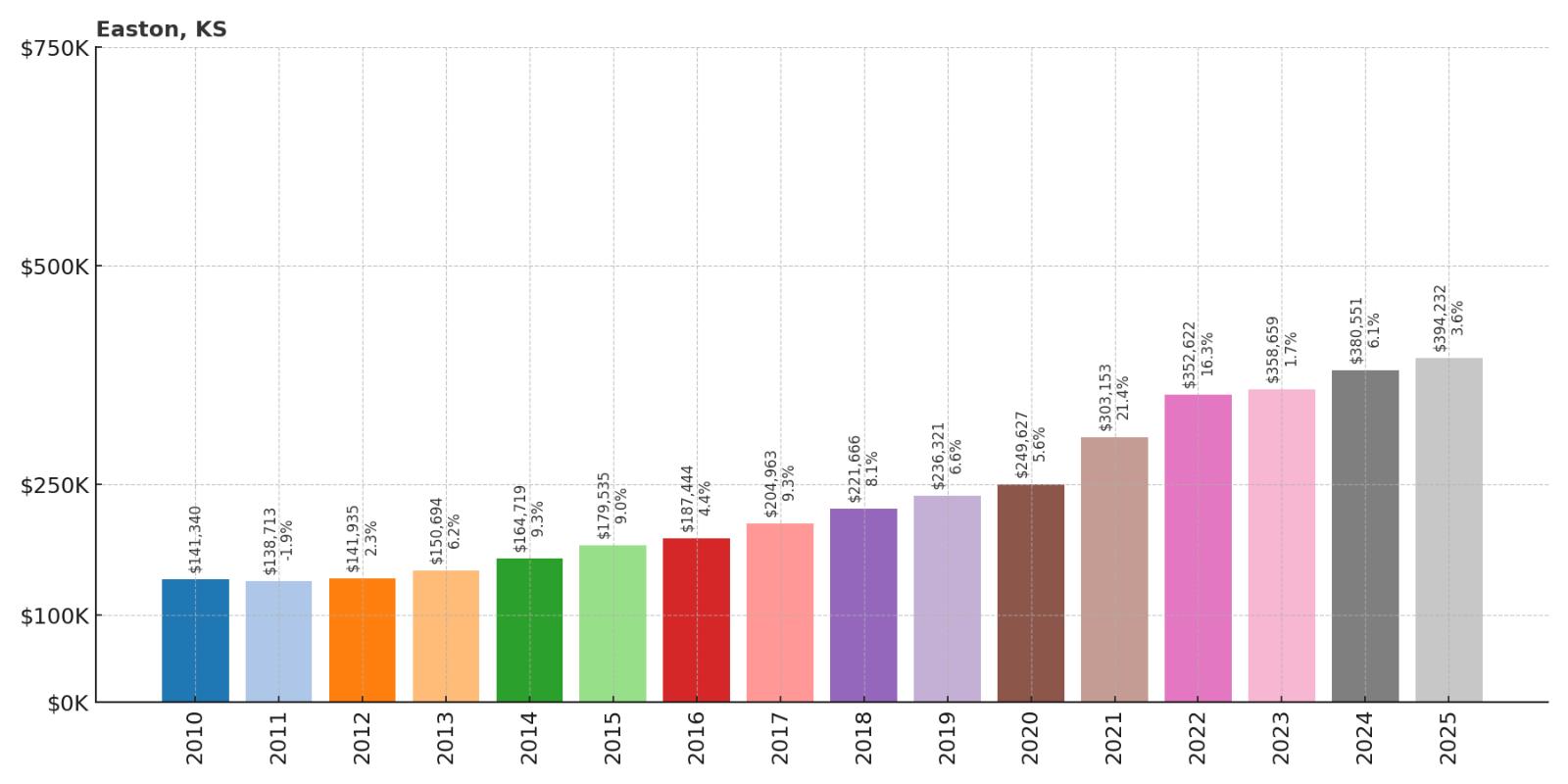
- 2010: $141,340
- 2011: $138,713
- 2012: $141,935
- 2013: $150,694
- 2014: $164,719
- 2015: $179,535
- 2016: $187,444
- 2017: $204,963
- 2018: $221,666
- 2019: $236,321
- 2020: $249,627
- 2021: $303,153
- 2022: $352,622
- 2023: $358,659
- 2024: $380,551
- 2025: $394,232
Easton shows exceptional growth with a 179% increase since 2010, nearly tripling to reach $394,232 in 2025. The Leavenworth County town maintained steady appreciation throughout the period with significant acceleration after 2020. This small community benefits from Kansas City proximity while maintaining rural character.
Why Easton?
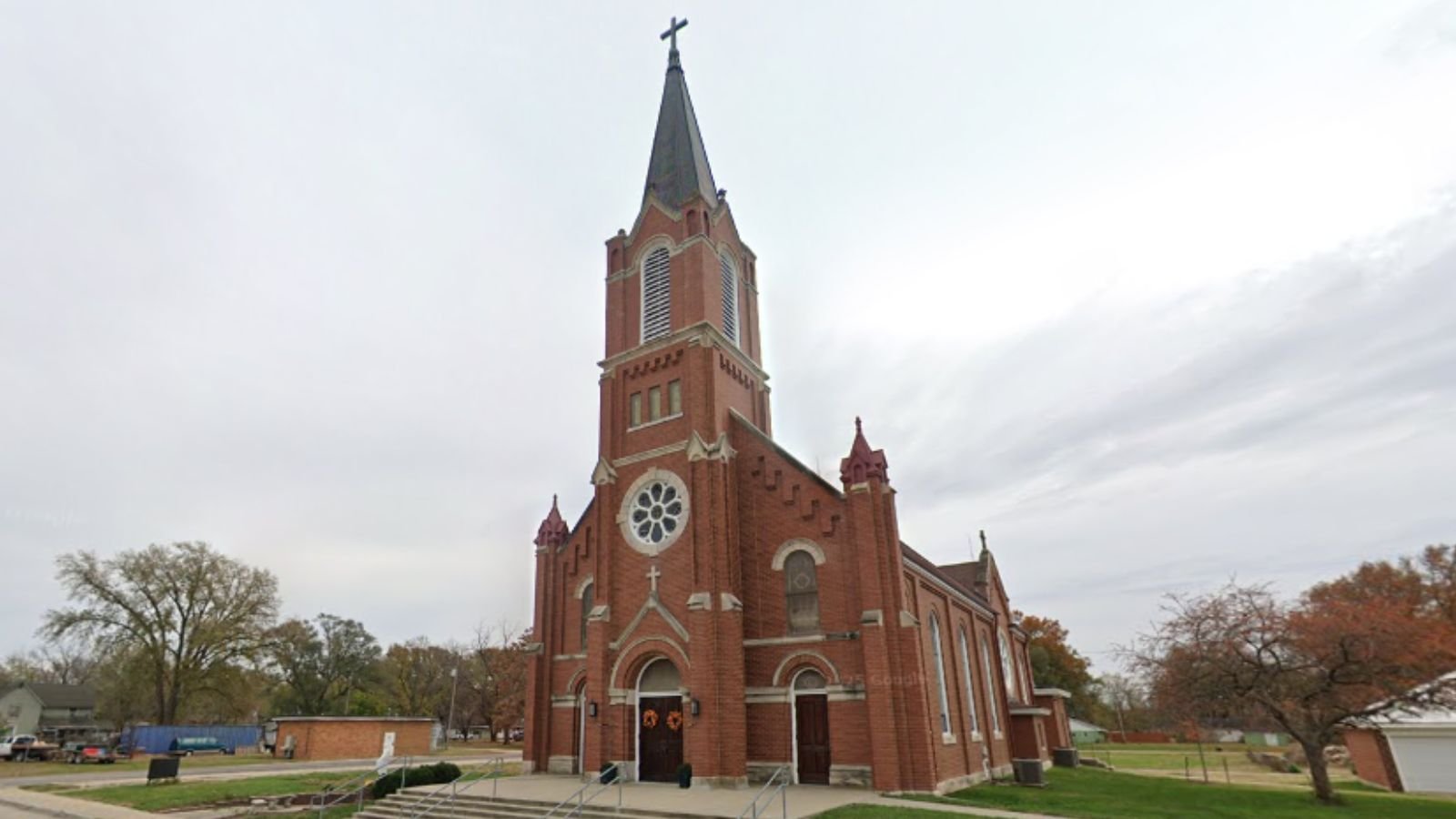
Why are people willing to pay so much to live here? What’s special about it?
Easton appeals to families seeking rural tranquility within commuting distance of Kansas City and Leavenworth employment. The small town offers excellent schools, safe neighborhoods, and community events that create strong social bonds. Residents value the peaceful environment and agricultural landscapes surrounding the community.
The area provides larger properties and country living while maintaining access to metropolitan amenities and job opportunities. Easton’s small size creates a tight-knit community where civic engagement remains high and neighbors maintain strong relationships.
How Easton Rose to Prominence
Easton was founded in the 1860s as a small farming community along the Missouri Pacific Railroad line. The town served as a grain shipping point and remained primarily agricultural throughout most of its history. Early settlers were drawn by fertile soil and transportation access to larger markets.
Recent growth reflects the expansion of Kansas City’s metropolitan influence into rural Leavenworth County. Easton’s rural character and reasonable property prices attracted families priced out of suburban markets while seeking small-town community benefits. The town’s location provides metropolitan access while preserving agricultural heritage and rural lifestyle.
3 Interesting Tidbits
- Railroad Heritage – Easton’s original development centered on the Missouri Pacific Railroad, which provided transportation for agricultural products and passenger service.
- Community Days Festival – The annual summer celebration brings together residents and visitors for local entertainment, crafts, and community fellowship.
- Agricultural Landscape – The town remains surrounded by working farms and agricultural operations that maintain the area’s rural character and economic base.
19. Louisburg – 136% Home Price Increase Since 2010

- 2010: $169,972
- 2011: $167,215
- 2012: $169,354
- 2013: $178,712
- 2014: $186,057
- 2015: $197,234
- 2016: $211,359
- 2017: $223,298
- 2018: $239,105
- 2019: $252,158
- 2020: $269,598
- 2021: $324,415
- 2022: $369,390
- 2023: $376,468
- 2024: $385,488
- 2025: $400,688
Louisburg has shown strong appreciation with a 136% increase since 2010, reaching $400,688 in 2025. The Miami County town maintained steady growth throughout the period with notable acceleration after 2020. The community benefits from excellent schools and proximity to Kansas City while maintaining small-town character.
Why Louisburg?
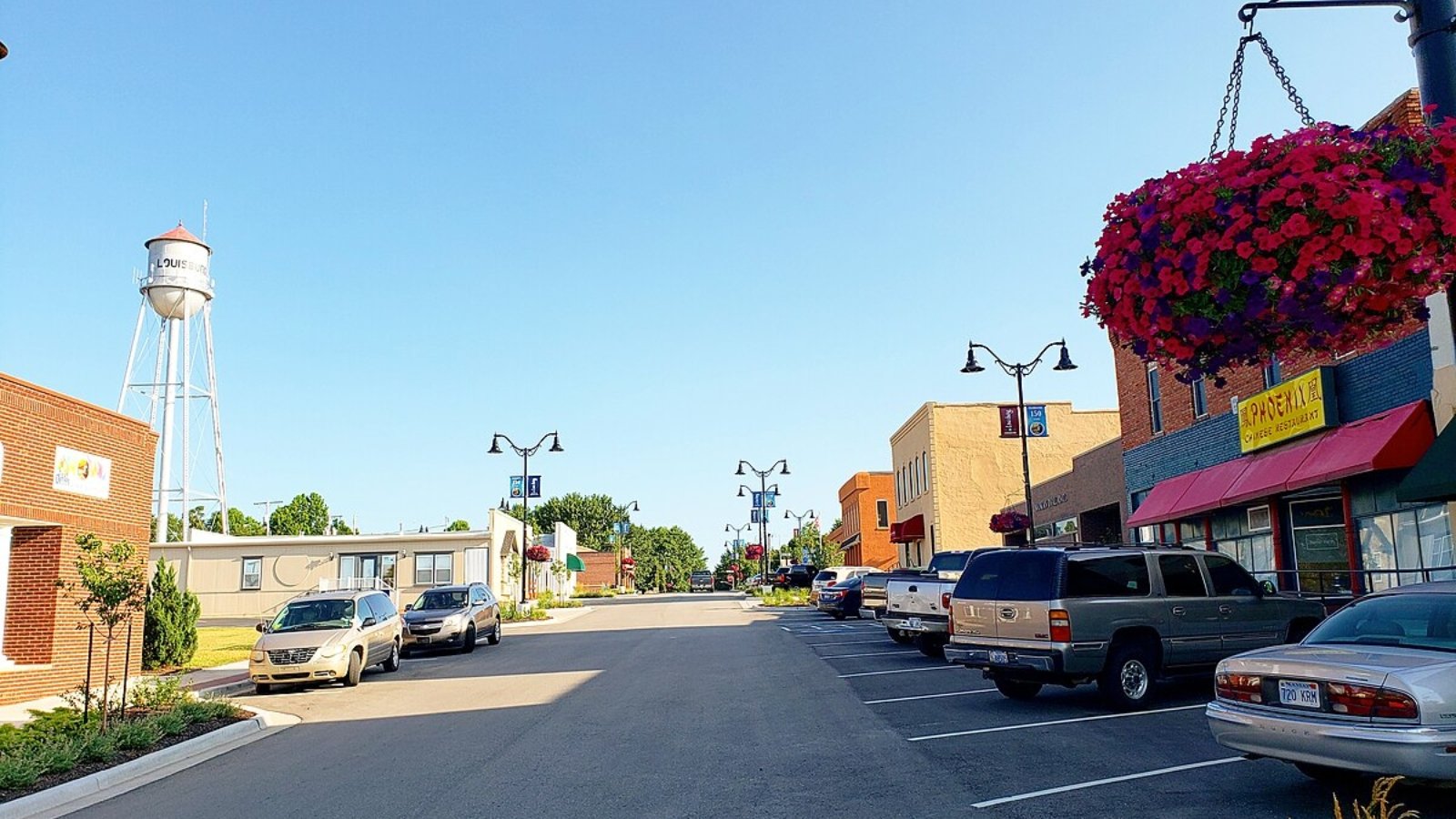
Why are people willing to pay so much to live here? What’s special about it?
Louisburg attracts families with its excellent school system, safe neighborhoods, and community amenities including parks and recreational facilities. The town offers a perfect balance of small-town values with suburban conveniences and easy access to Kansas City employment. Residents appreciate the strong sense of community and civic engagement.
The area provides newer housing developments, quality infrastructure, and planned growth that maintains community character while accommodating families seeking modern amenities. Louisburg’s location offers reasonable commutes to Kansas City while providing small-town benefits and lower living costs.
How Louisburg Rose to Prominence
Louisburg was founded in 1857 and named after Louisburg, North Carolina, reflecting the heritage of early settlers. The town served as a trading center for surrounding agricultural areas and remained primarily rural throughout most of its history. Early growth centered on farming and local commerce.
Modern development accelerated in the 1980s as Kansas City’s metropolitan expansion reached Miami County. Louisburg invested in schools and infrastructure to attract families seeking suburban alternatives. The town’s strategic planning and commitment to quality amenities created a desirable residential community that attracted steady population growth and housing demand.
3 Interesting Tidbits
- Louisburg Sports Complex – The town’s modern sports facilities host regional tournaments and provide extensive recreational opportunities for residents and visitors.
- Powell Observatory – Located nearby, this astronomical observatory offers stargazing opportunities and educational programs that enhance community cultural offerings.
- Cider Days Festival – The annual fall festival celebrates local heritage with apple cider, crafts, and community entertainment that draws visitors throughout the region.
18. Shawnee – 98% Home Price Increase Since 2010
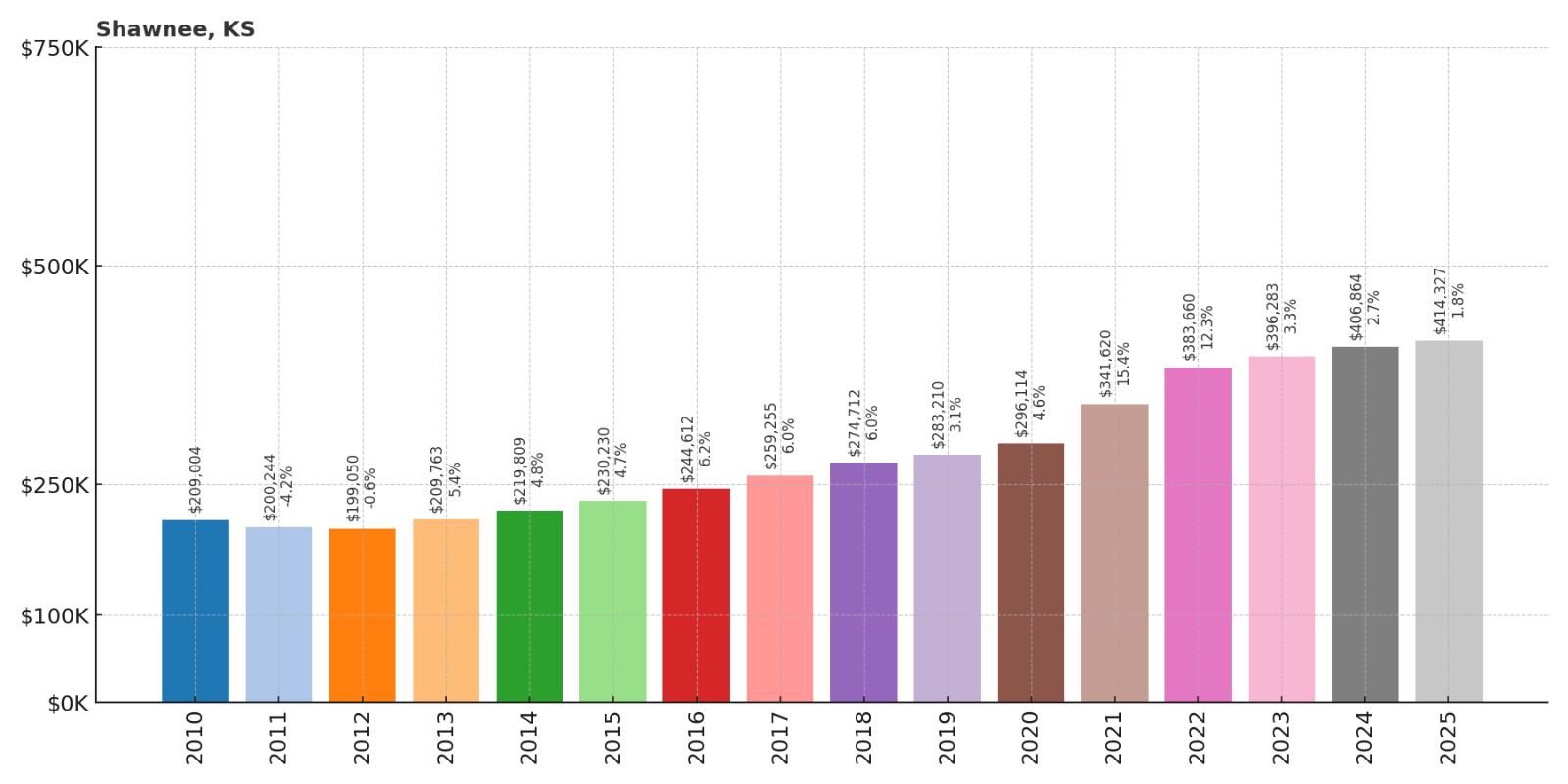
- 2010: $209,004
- 2011: $200,244
- 2012: $199,050
- 2013: $209,763
- 2014: $219,809
- 2015: $230,230
- 2016: $244,612
- 2017: $259,255
- 2018: $274,712
- 2019: $283,210
- 2020: $296,114
- 2021: $341,620
- 2022: $383,660
- 2023: $396,283
- 2024: $406,864
- 2025: $414,327
Shawnee demonstrates solid growth with a 98% increase since 2010, nearly doubling to reach $414,327 in 2025. The Johnson County city maintained steady appreciation throughout the period with acceleration after 2020. As one of Kansas City’s major suburbs, Shawnee offers comprehensive amenities and excellent schools.
Why Shawnee?
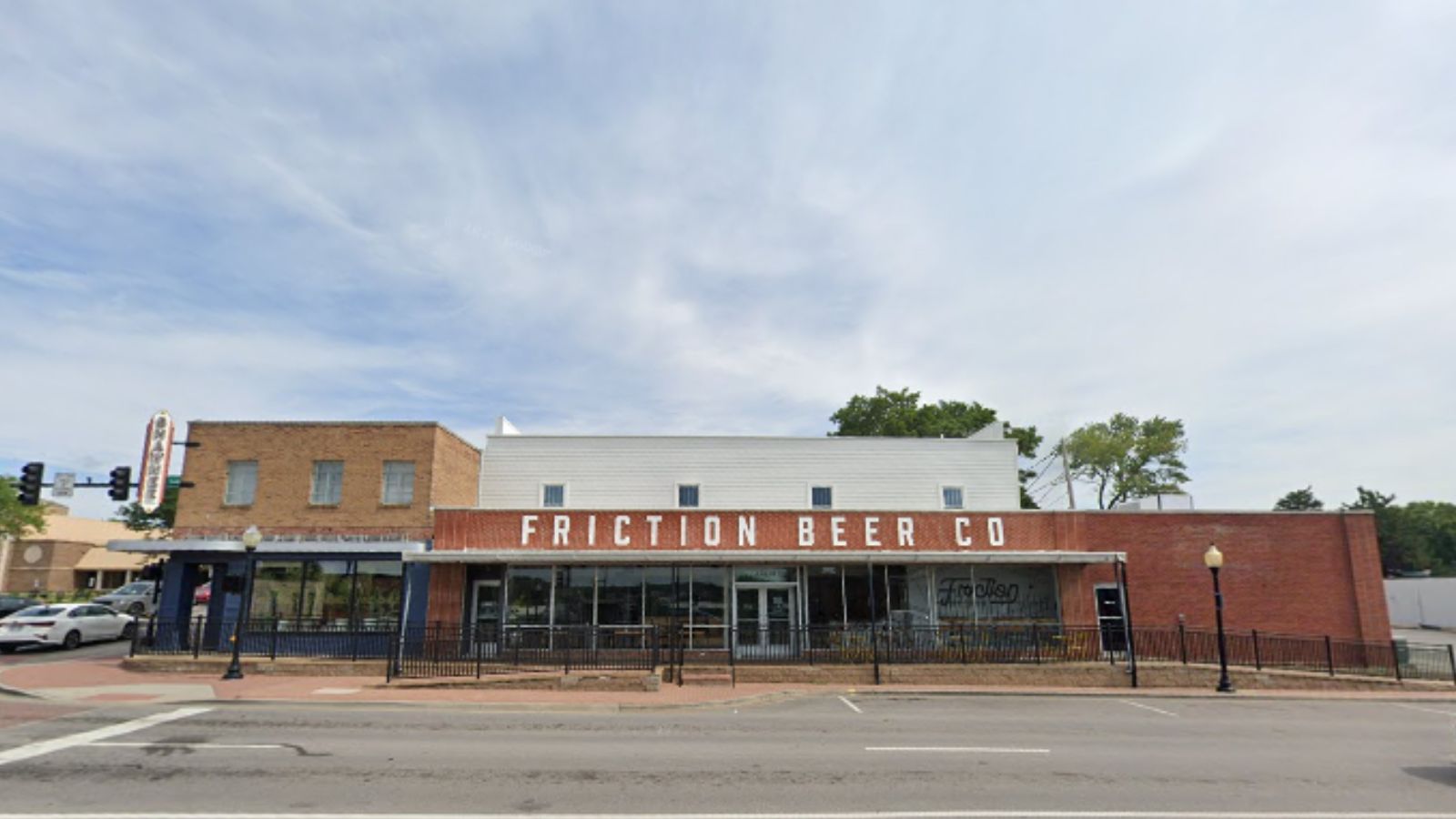
Why are people willing to pay so much to live here? What’s special about it?
Shawnee offers residents excellent schools through the Shawnee Mission School District, comprehensive parks and recreation facilities, and diverse housing options from starter homes to luxury properties. The city provides full municipal services, shopping centers, and restaurants while maintaining family-friendly neighborhoods. Many residents work in Kansas City but prefer Shawnee’s suburban lifestyle.
The community features well-maintained parks, golf courses, and recreational facilities that enhance quality of life and property values. Shawnee’s strategic location provides easy access to Kansas City employment while offering suburban amenities and community events that create strong neighborhood bonds.
How Shawnee Rose to Prominence
Shawnee was incorporated in 1922 and named after the Shawnee tribe that historically inhabited the area. The city grew as part of the post-World War II suburban boom, developing as a bedroom community for Kansas City workers. Planned residential developments and commercial centers established Shawnee as a major Johnson County suburb.
Growth accelerated with the expansion of the Shawnee Mission School District and development of shopping centers and business parks. The city’s strategic planning balanced residential growth with commercial development, creating a diverse economic base and attractive community amenities that continue to drive housing demand.
3 Interesting Tidbits
- Shawnee Mission Park – The city borders this 1,600-acre Johnson County park offering trails, lake access, and extensive recreational facilities popular with residents.
- Historic Downtown – Shawnee maintains a charming historic downtown district with local businesses, restaurants, and community events that preserve small-town character.
- Corporate Headquarters – Several major corporations maintain facilities in Shawnee, providing local employment and contributing to the city’s economic stability.
17. Olathe – 102% Home Price Increase Since 2010

- 2010: $207,689
- 2011: $197,621
- 2012: $197,983
- 2013: $208,286
- 2014: $219,227
- 2015: $230,325
- 2016: $246,019
- 2017: $261,677
- 2018: $276,005
- 2019: $284,283
- 2020: $297,423
- 2021: $344,822
- 2022: $389,037
- 2023: $403,169
- 2024: $414,084
- 2025: $419,795
Olathe shows solid growth with a 102% increase since 2010, doubling to reach $419,795 in 2025. The Johnson County city maintained steady appreciation throughout the period with notable acceleration after 2020. As Johnson County’s largest city, Olathe offers comprehensive amenities, excellent schools, and diverse employment opportunities.
Why Olathe?
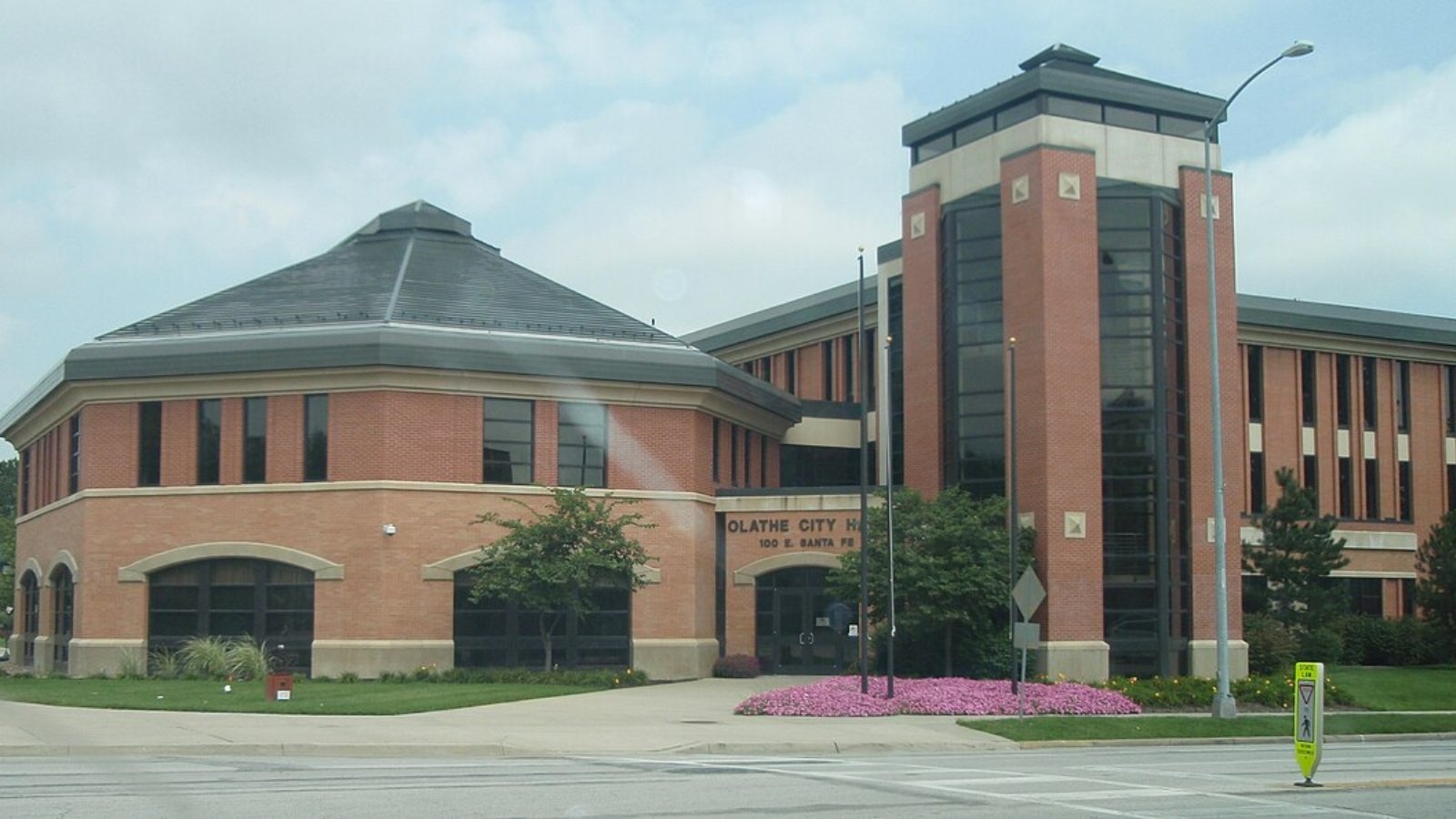
Why are people willing to pay so much to live here? What’s special about it?
Olathe attracts families with top-rated schools, extensive parks and recreation facilities, and diverse housing options from affordable starter homes to luxury properties. The city provides full municipal services, major shopping centers, and employment opportunities in both corporate offices and healthcare facilities. Residents appreciate the blend of suburban amenities with community character.
The area offers excellent transportation access including commuter rail service to downtown Kansas City, making it attractive for professionals throughout the metro area. Olathe’s commitment to planned growth and infrastructure investment maintains high quality of life while accommodating continued population growth.
How Olathe Rose to Prominence
Olathe was founded in 1857 and incorporated in 1873, named after a Shawnee word meaning “beautiful.” The city served as Johnson County’s seat and grew as an agricultural center throughout the early 20th century. Modern development began after World War II with suburban expansion from Kansas City.
Major growth occurred in the 1970s and 1980s with corporate relocations and residential developments. Olathe’s strategic location, excellent schools, and business-friendly policies attracted major employers and families. The city became a regional employment center while maintaining strong residential appeal, creating sustained housing demand and value appreciation.
3 Interesting Tidbits
- Johnson County Government – Olathe serves as the county seat, housing major government facilities and employment that contribute to economic stability.
- MidAmerica Nazarene University – The private university adds cultural and educational opportunities while contributing to the local economy and community character.
- Corporate Campus – Major corporations including Garmin maintain significant facilities in Olathe, providing high-tech employment and economic diversification.
16. Westwood – 120% Home Price Increase Since 2010
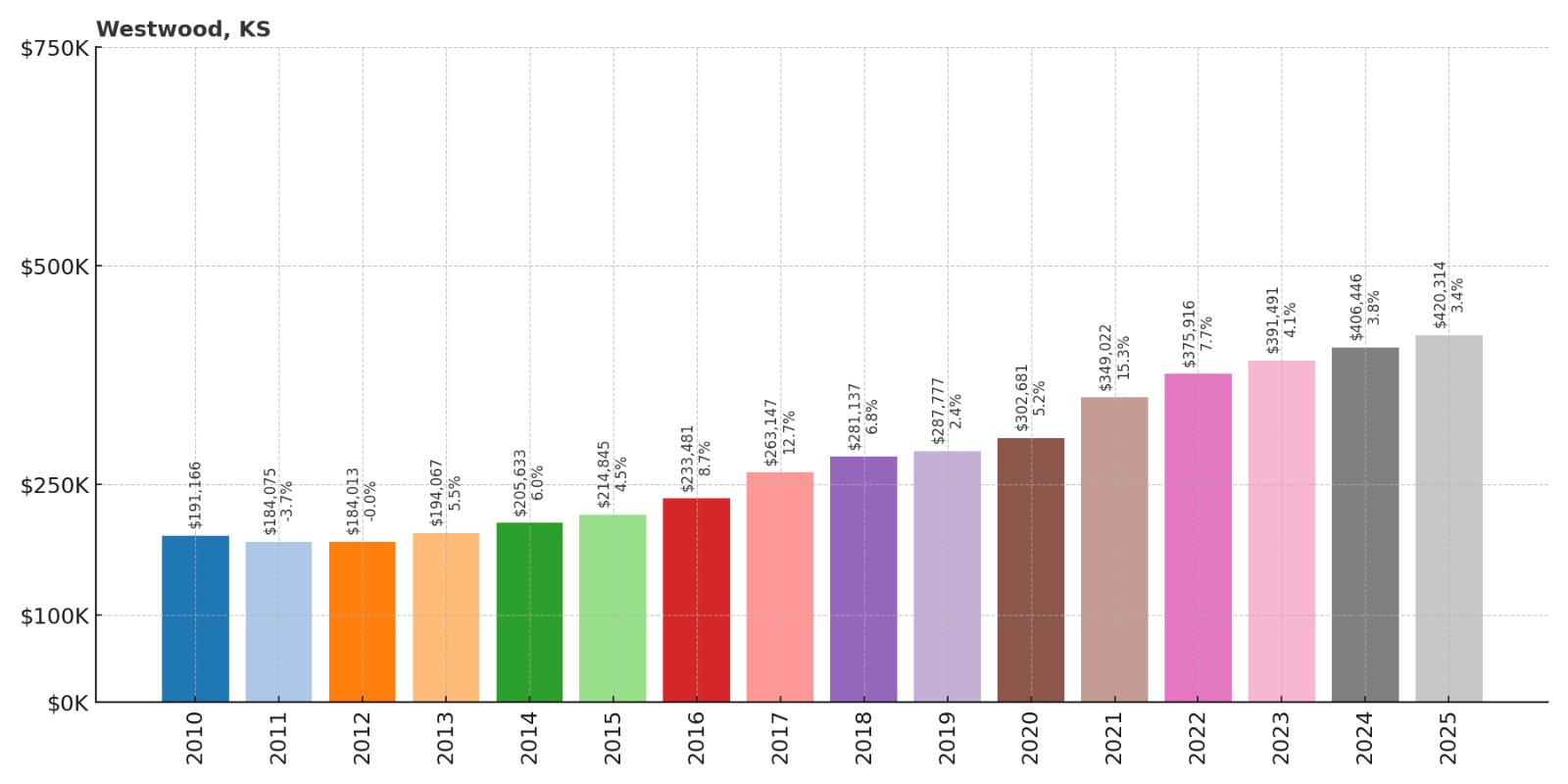
- 2010: $191,166
- 2011: $184,075
- 2012: $184,013
- 2013: $194,067
- 2014: $205,633
- 2015: $214,845
- 2016: $233,481
- 2017: $263,147
- 2018: $281,137
- 2019: $287,777
- 2020: $302,681
- 2021: $349,022
- 2022: $375,916
- 2023: $391,491
- 2024: $406,446
- 2025: $420,314
Westwood demonstrates strong growth with a 120% increase since 2010, more than doubling to reach $420,314 in 2025. The Johnson County city maintained steady appreciation with notable acceleration after 2016 and again after 2020. This small, upscale community offers luxury living with excellent schools and prime location.
Why Westwood?
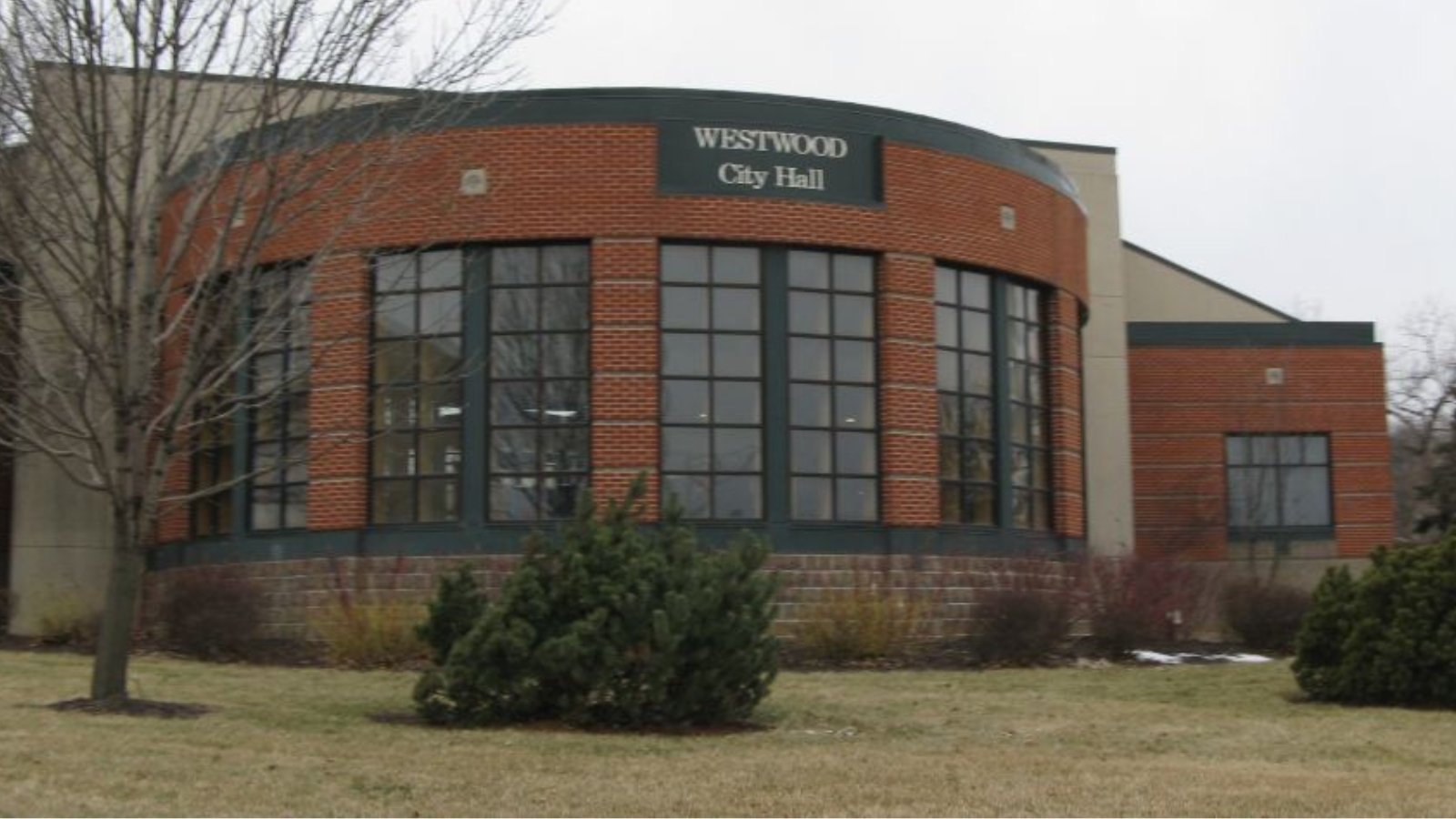
Why are people willing to pay so much to live here? What’s special about it?
Westwood appeals to affluent families seeking an exclusive residential environment with top-rated schools and prime Johnson County location. The small city offers tree-lined streets, upscale homes, and a strong sense of community while providing easy access to Kansas City employment and cultural opportunities. Residents value the prestige and quality associated with Westwood addresses.
The area features excellent municipal services, well-maintained infrastructure, and proximity to major shopping and dining destinations including the Country Club Plaza. Westwood’s compact size creates a close-knit community atmosphere while maintaining the amenities expected in luxury residential areas.
How Westwood Rose to Prominence
Westwood was developed in the 1940s as an upscale residential community in Johnson County, designed to attract affluent families seeking suburban luxury near Kansas City. The city incorporated in 1949 to maintain local control over development and municipal services. Early residents included business executives and professionals working in Kansas City.
The community’s reputation for excellence grew through careful planning, quality construction, and excellent schools. Westwood’s strategic location and commitment to maintaining high standards attracted continued investment and residential demand. The city’s prestige and limited housing supply have consistently supported premium property values.
3 Interesting Tidbits
- Joe D. Dennis Park – The city’s main recreational facility provides residents with tennis courts, playgrounds, and community gathering spaces in a beautifully landscaped setting.
- Architectural Standards – Westwood maintains strict architectural guidelines that preserve the community’s upscale character and property values through consistent design quality.
- Strategic Location – The city’s position between Kansas City and Johnson County’s major employment centers makes it highly desirable for affluent professionals.
15. De Soto – 117% Home Price Increase Since 2010
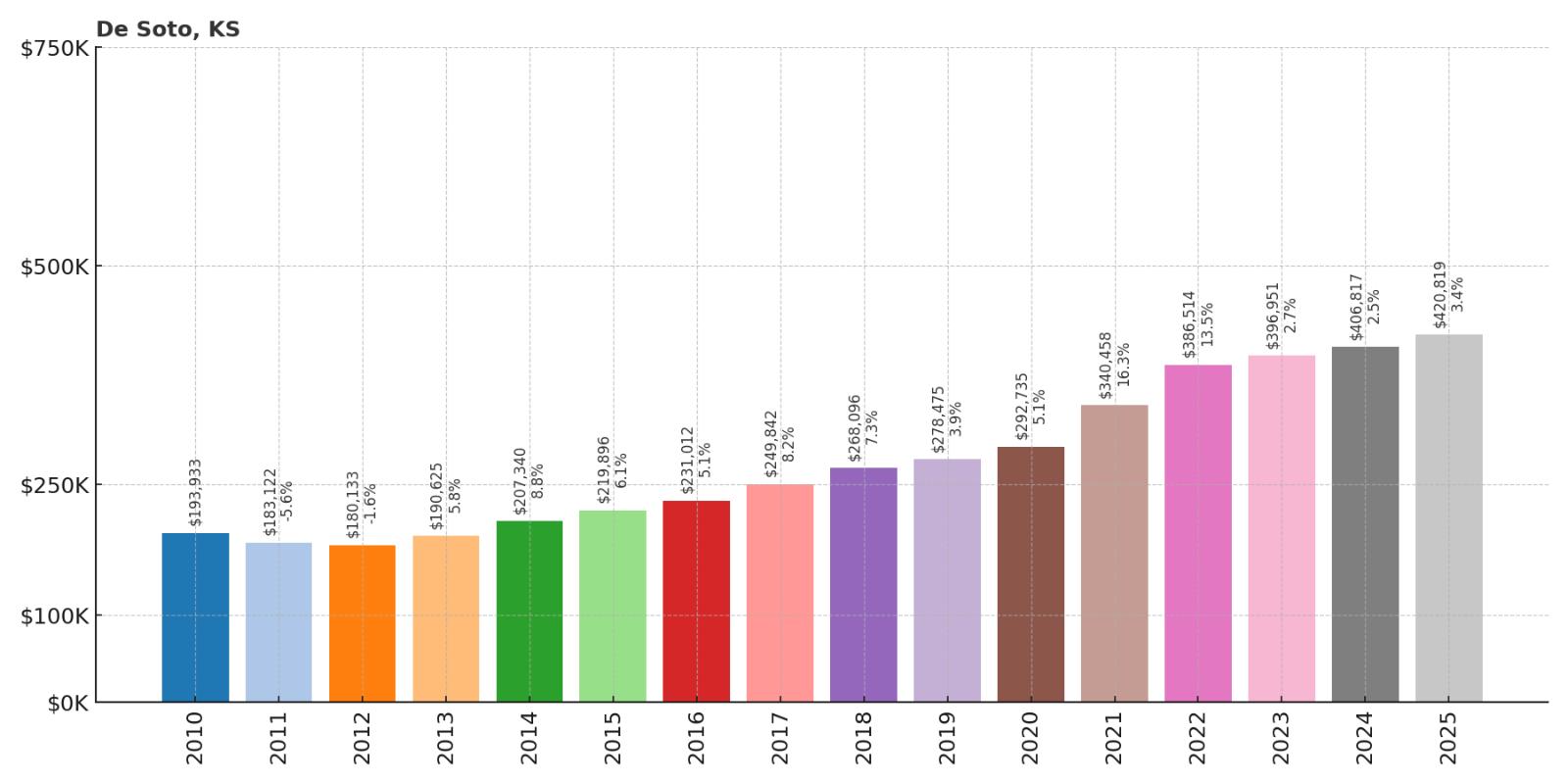
- 2010: $193,933
- 2011: $183,122
- 2012: $180,133
- 2013: $190,625
- 2014: $207,340
- 2015: $219,896
- 2016: $231,012
- 2017: $249,842
- 2018: $268,096
- 2019: $278,475
- 2020: $292,735
- 2021: $340,458
- 2022: $386,514
- 2023: $396,951
- 2024: $406,817
- 2025: $420,819
De Soto shows strong appreciation with a 117% increase since 2010, more than doubling to reach $420,819 in 2025. The Johnson County city experienced some early volatility but recovered to show consistent growth, with notable acceleration after 2020. The community benefits from excellent schools and strategic location between Kansas City and Lawrence.
Why De Soto?

Why are people willing to pay so much to live here? What’s special about it?
De Soto attracts families with excellent schools, safe neighborhoods, and a strong sense of community while providing reasonable access to Kansas City employment. The city offers newer housing developments, quality municipal services, and recreational facilities including parks and sports complexes. Residents appreciate the balance of suburban amenities with small-town character.
The area provides more affordable luxury compared to other Johnson County communities while maintaining quality schools and infrastructure. De Soto’s location offers scenic beauty along the Kansas River while providing modern conveniences and community amenities that support family life.
How De Soto Rose to Prominence
De Soto was established in the 1850s along the Kansas River and named after Spanish explorer Hernando de Soto. The town served as a river crossing point and trading post, growing slowly as an agricultural community throughout the early 20th century. Modern development began with suburban expansion from Kansas City in the 1970s.
Growth accelerated with the development of residential subdivisions and improved transportation access. De Soto’s riverside location and planned growth attracted families seeking suburban living with natural amenities. The city’s investment in schools, parks, and infrastructure created a desirable residential community that continues to attract homebuyers throughout the metro area.
3 Interesting Tidbits
- Kansas River Access – De Soto provides excellent access to Kansas River recreation including fishing, kayaking, and nature observation along scenic riverbanks.
- Mill Creek Streamway Park – The city borders this extensive trail system that connects to regional recreation opportunities and provides residents with outdoor activity options.
- Historical Society Museum – The local museum preserves De Soto’s pioneer heritage and provides educational programs that strengthen community connections to local history.
14. Spring Hill – 121% Home Price Increase Since 2010
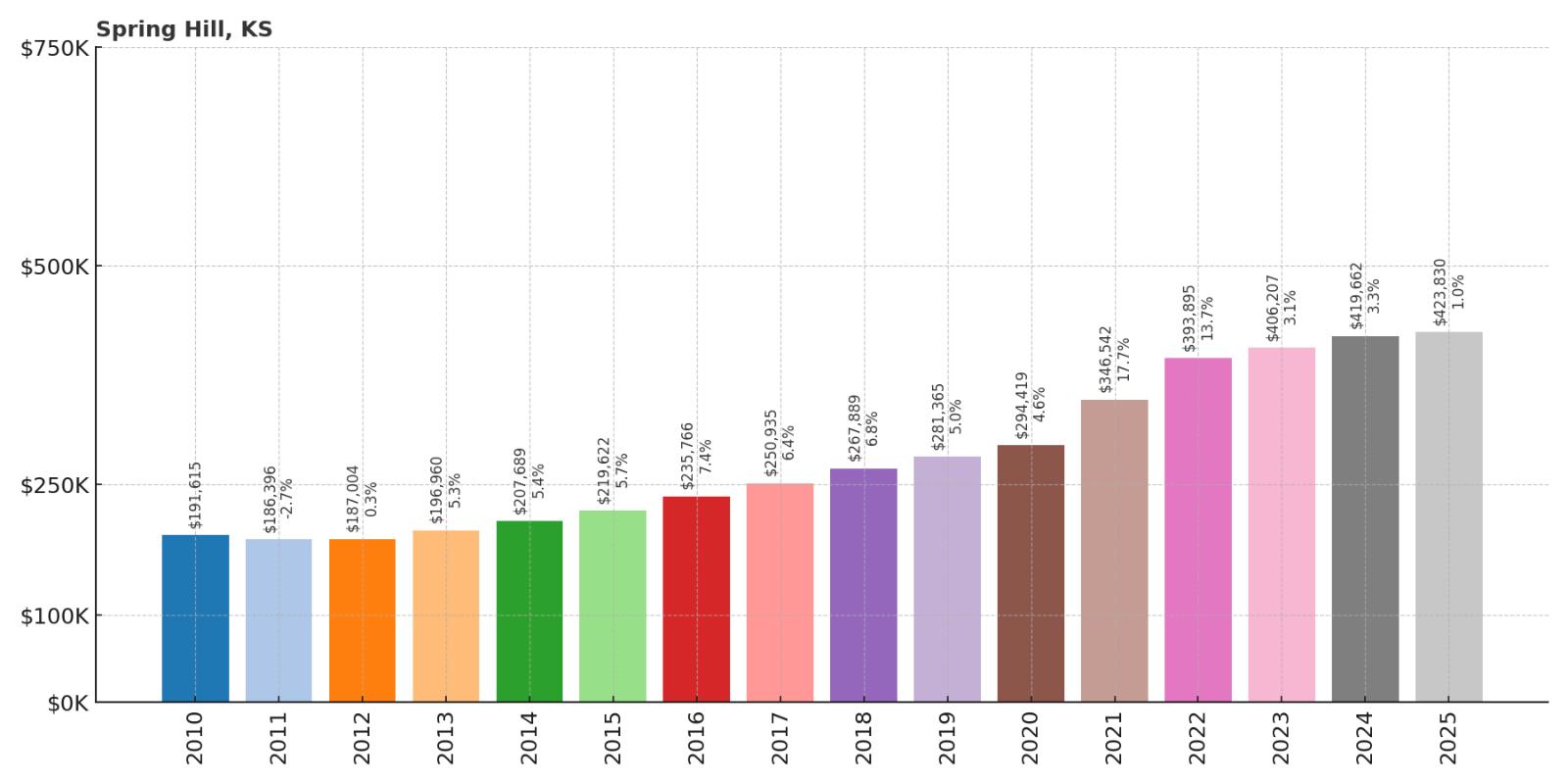
- 2010: $191,615
- 2011: $186,396
- 2012: $187,004
- 2013: $196,960
- 2014: $207,689
- 2015: $219,622
- 2016: $235,766
- 2017: $250,935
- 2018: $267,889
- 2019: $281,365
- 2020: $294,419
- 2021: $346,542
- 2022: $393,895
- 2023: $406,207
- 2024: $419,662
- 2025: $423,830
Spring Hill demonstrates strong growth with a 121% increase since 2010, more than doubling to reach $423,830 in 2025. The Johnson County city maintained steady appreciation throughout the period with notable acceleration after 2020. The community offers excellent schools and family-friendly amenities while maintaining reasonable access to Kansas City employment.
Why Spring Hill?

Why are people willing to pay so much to live here? What’s special about it?
Spring Hill attracts families with top-rated schools, safe neighborhoods, and newer housing developments that offer modern amenities and spacious lots. The city provides excellent recreational facilities, community events, and municipal services while maintaining a small-town atmosphere. Residents appreciate the balance of growth and community character.
The area offers more affordable options compared to other Johnson County communities while providing quality schools and infrastructure. Spring Hill’s planned development and commitment to maintaining high standards create an attractive environment for families seeking suburban living with community benefits.
How Spring Hill Rose to Prominence
Spring Hill was incorporated in 1976, making it one of Johnson County’s newer cities. The community developed as suburban expansion reached southern Johnson County, attracting families seeking newer housing and excellent schools. Early development focused on planned residential communities with quality infrastructure and amenities.
Growth accelerated in the 1990s and 2000s with continued residential development and commercial expansion. Spring Hill’s strategic planning and investment in schools, parks, and municipal services created a desirable community that attracted steady population growth. The city’s relatively recent development allowed for modern infrastructure and planned growth patterns.
3 Interesting Tidbits
- Hillsdale Lake Recreation – Spring Hill provides access to nearby Hillsdale Lake, offering boating, fishing, and camping opportunities that enhance the area’s recreational appeal.
- Planned Community Development – The city’s relatively recent incorporation allowed for comprehensive planning that created well-designed neighborhoods and infrastructure systems.
- Corporate Growth – Spring Hill has attracted several corporate facilities and business developments that provide local employment and economic diversification.
13. Basehor – 105% Home Price Increase Since 2010
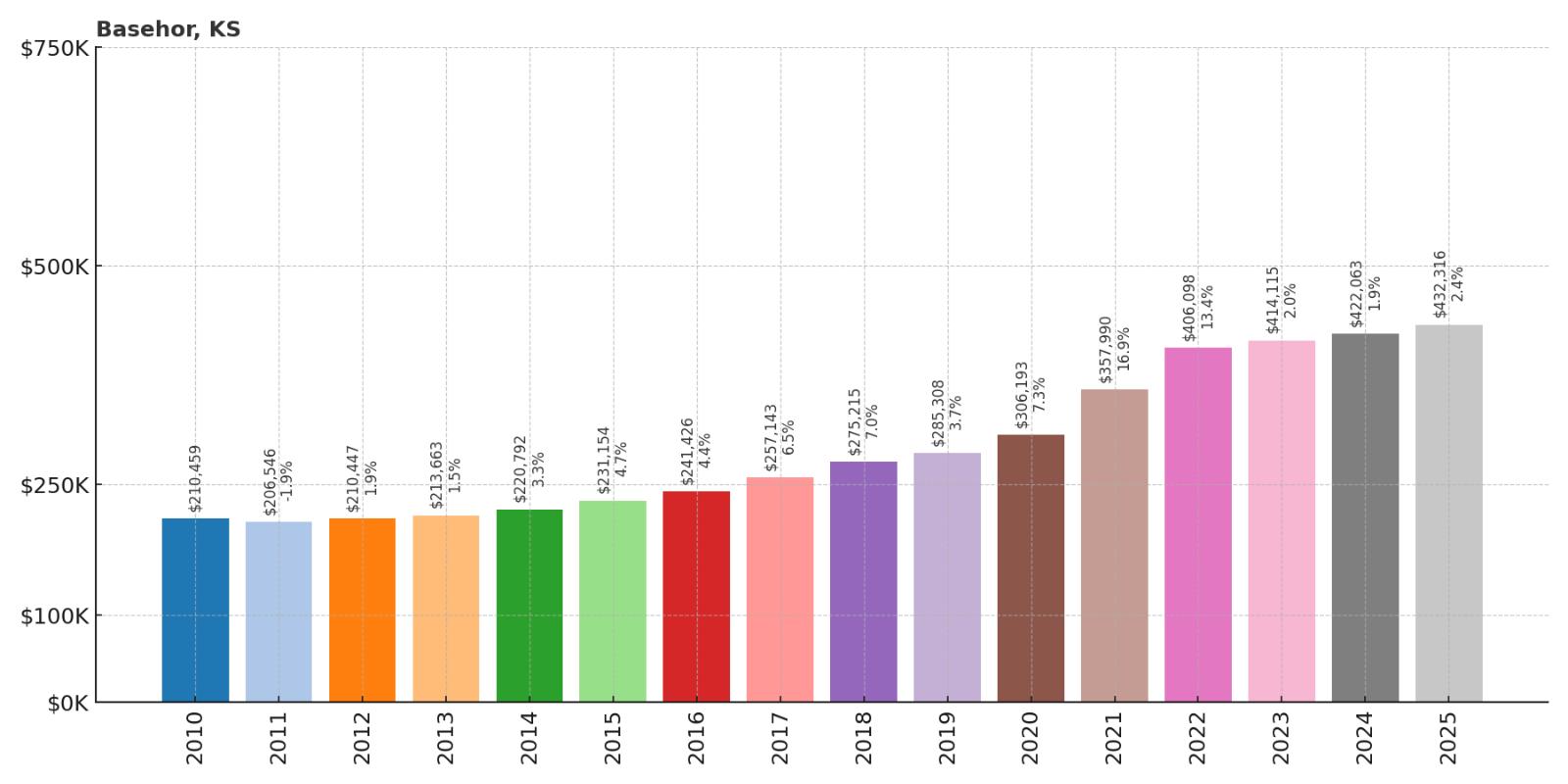
- 2010: $210,459
- 2011: $206,546
- 2012: $210,447
- 2013: $213,663
- 2014: $220,792
- 2015: $231,154
- 2016: $241,426
- 2017: $257,143
- 2018: $275,215
- 2019: $285,308
- 2020: $306,193
- 2021: $357,990
- 2022: $406,098
- 2023: $414,115
- 2024: $422,063
- 2025: $432,316
Basehor shows solid growth with a 105% increase since 2010, more than doubling to reach $432,316 in 2025. The Leavenworth County city maintained steady appreciation throughout the period with acceleration after 2020. The community benefits from excellent schools and strategic location for Kansas City area commuters.
Why Basehor?
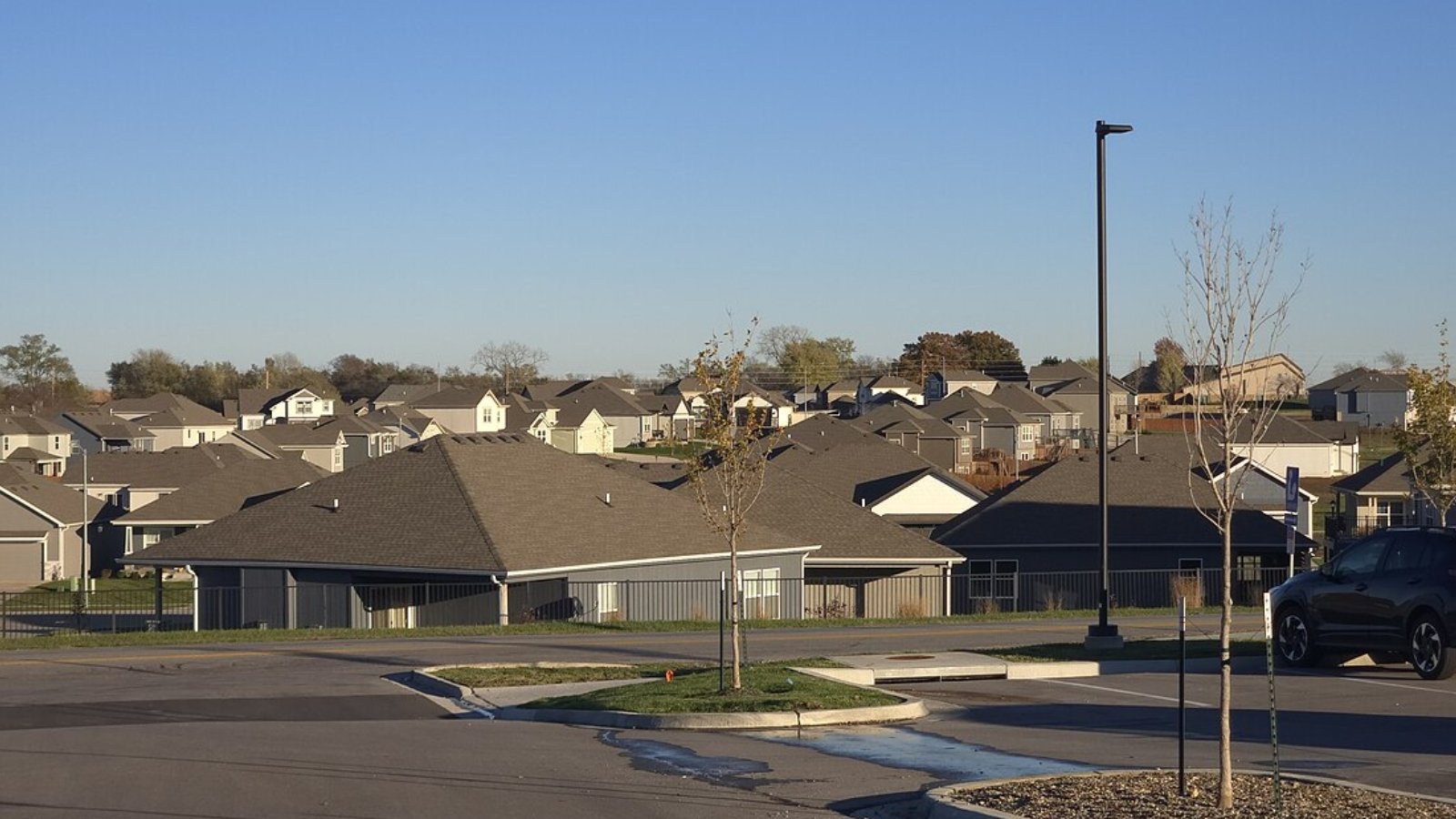
Why are people willing to pay so much to live here? What’s special about it?
Basehor attracts families with excellent schools through the Basehor-Linwood district, safe neighborhoods, and community amenities including parks and recreational facilities. The city offers a small-town atmosphere with suburban conveniences while providing reasonable commutes to Kansas City employment. Residents value the strong community spirit and family-friendly environment.
The area provides newer housing developments and quality infrastructure while maintaining lower costs compared to Johnson County alternatives. Basehor’s location offers both metropolitan access and rural beauty, creating an attractive environment for families seeking balanced lifestyle options.
How Basehor Rose to Prominence
Basehor was founded in the 1890s as a railroad town along the Chicago, Burlington & Quincy Railroad. The community was named after railroad official Ephraim Basehor and served as a shipping point for agricultural products. The town remained small and rural throughout most of its history, serving local farming operations.
Modern growth began in the 1980s as Kansas City’s suburban expansion reached Leavenworth County. Basehor’s strategic location and development opportunities attracted residential growth and families seeking alternatives to more expensive suburban markets. The city’s investment in schools and infrastructure created an attractive community that continues to grow.
3 Interesting Tidbits
- Basehor Historical Museum – The local museum preserves the town’s railroad heritage and pioneer history, providing educational programs and community gatherings.
- Community Park System – Basehor maintains extensive parks and recreational facilities that provide residents with sports fields, playgrounds, and walking trails.
- Railroad Heritage – The town’s original development along the railroad created a linear downtown district that maintains historic character while accommodating modern businesses.
12. Linwood – 164% Home Price Increase Since 2010
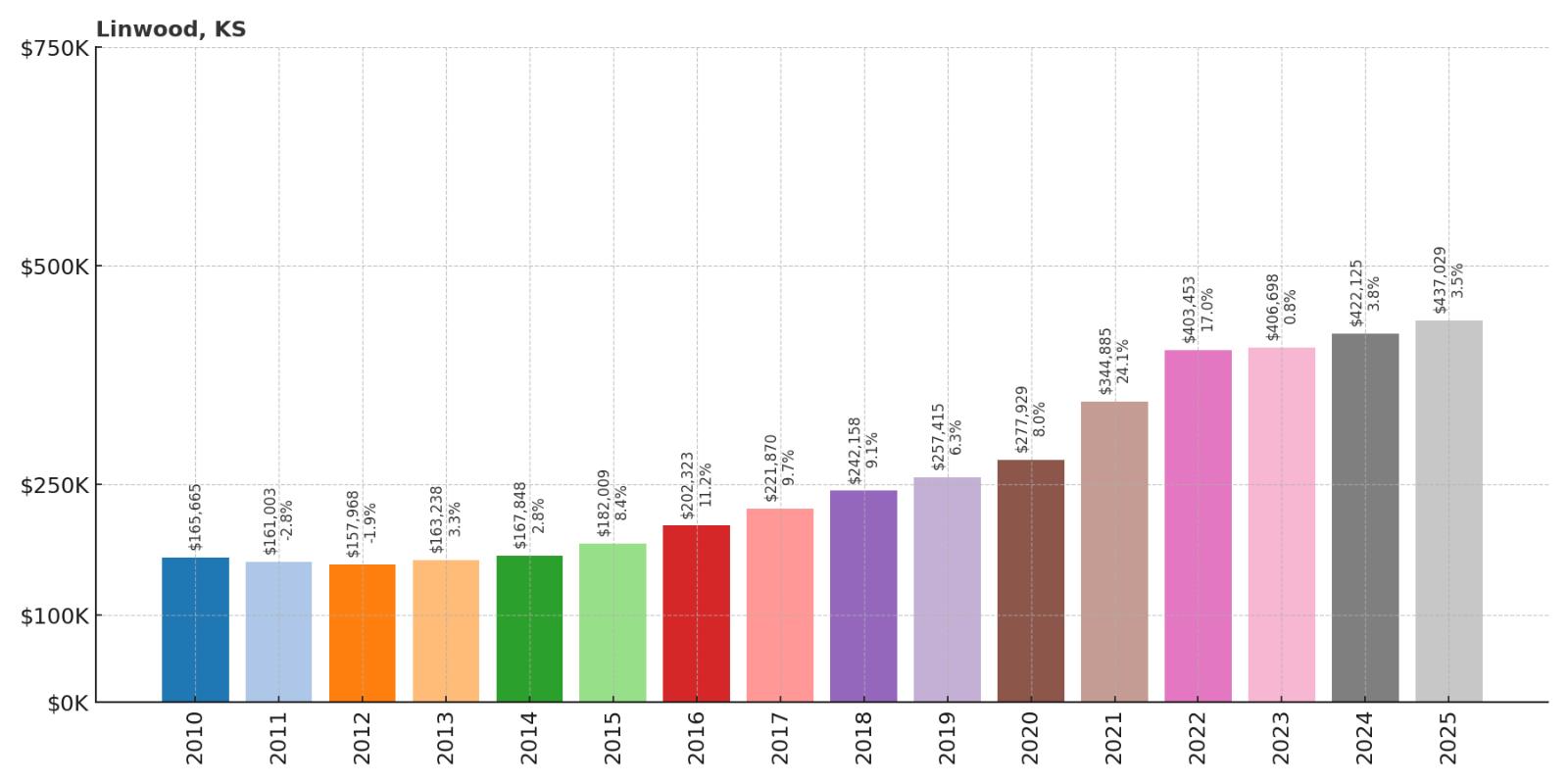
- 2010: $165,665
- 2011: $161,003
- 2012: $157,968
- 2013: $163,238
- 2014: $167,848
- 2015: $182,009
- 2016: $202,323
- 2017: $221,870
- 2018: $242,158
- 2019: $257,415
- 2020: $277,929
- 2021: $344,885
- 2022: $403,453
- 2023: $406,698
- 2024: $422,125
- 2025: $437,029
Linwood shows exceptional growth with a 164% increase since 2010, reaching $437,029 in 2025. The Leavenworth County town experienced early declines but recovered strongly after 2014, with dramatic acceleration after 2020. This small community benefits from excellent schools and rural character while providing access to Kansas City employment.
Why Linwood?
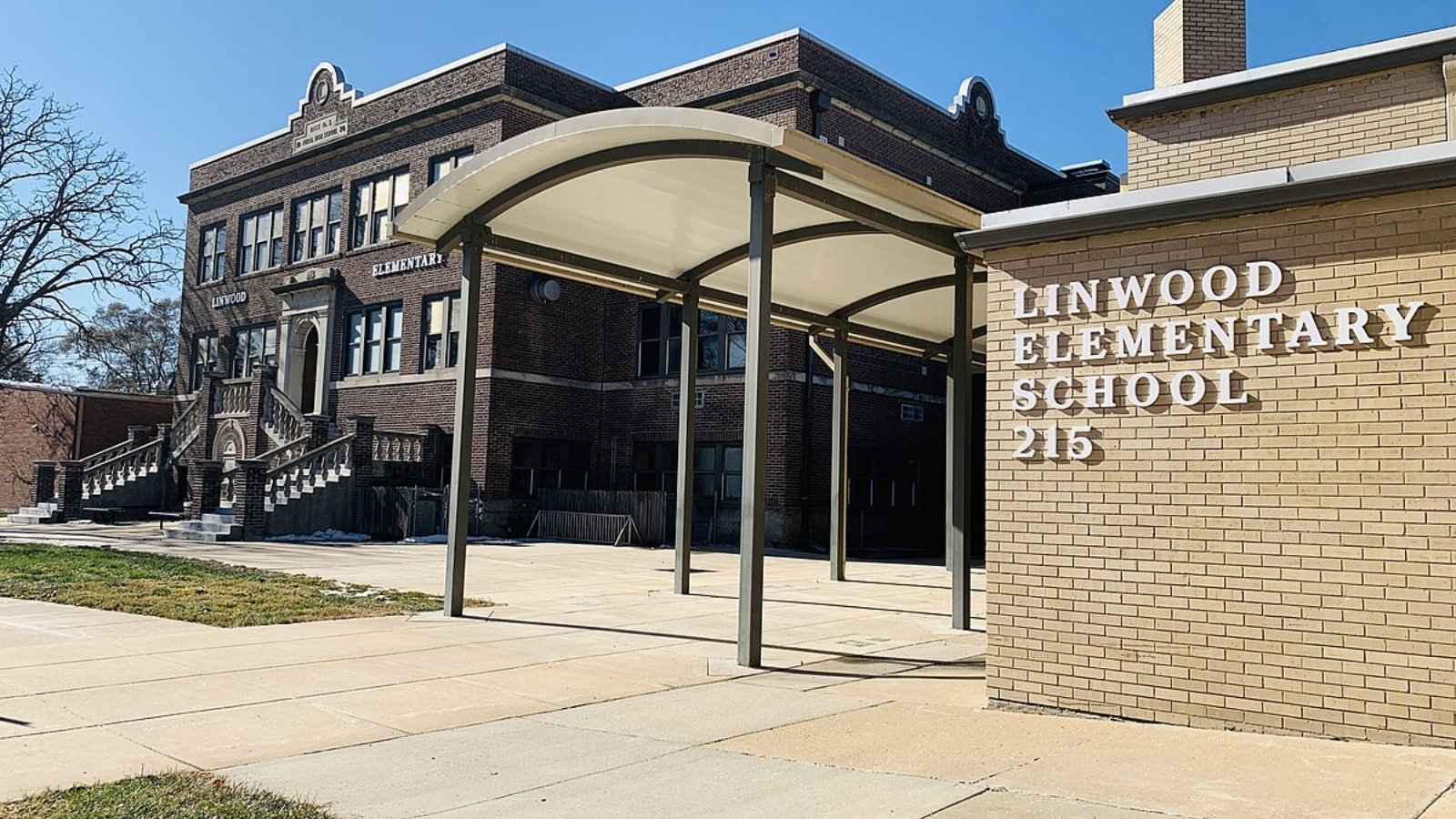
Why are people willing to pay so much to live here? What’s special about it?
Linwood appeals to families seeking excellent schools through the Basehor-Linwood district, rural tranquility, and community character within commuting distance of Kansas City. The town offers larger lots, newer housing developments, and agricultural surroundings that provide peaceful living environments. Residents value the small-town atmosphere and strong school system.
The area provides country living benefits while maintaining reasonable access to metropolitan employment and amenities. Linwood’s rural setting includes working farms, open spaces, and natural beauty that contrasts favorably with suburban density while offering modern conveniences and quality education.
How Linwood Rose to Prominence
Linwood was established in the late 1800s as a small farming community in Leavenworth County. The town remained primarily agricultural throughout most of its history, serving local farming operations and maintaining a close-knit rural community atmosphere. Early development centered on grain farming and livestock operations.
Recent growth reflects the expansion of Kansas City’s metropolitan area and families seeking rural alternatives to suburban living. Linwood’s agricultural character and excellent schools attracted buyers seeking larger properties and country lifestyle benefits. The town’s partnership with Basehor in the school district created educational excellence that drives housing demand.
3 Interesting Tidbits
- Agricultural Heritage – Linwood maintains strong ties to agriculture, with working farms and rural landscapes that preserve the area’s traditional character and economic base.
- Basehor-Linwood Schools – The shared school district provides excellent educational opportunities and athletic programs that serve as community gathering points and sources of civic pride.
- Rural Development – Linwood’s growth has been carefully managed to preserve rural character while accommodating new residential development and modern infrastructure needs.
11. Lenexa – 99% Home Price Increase Since 2010
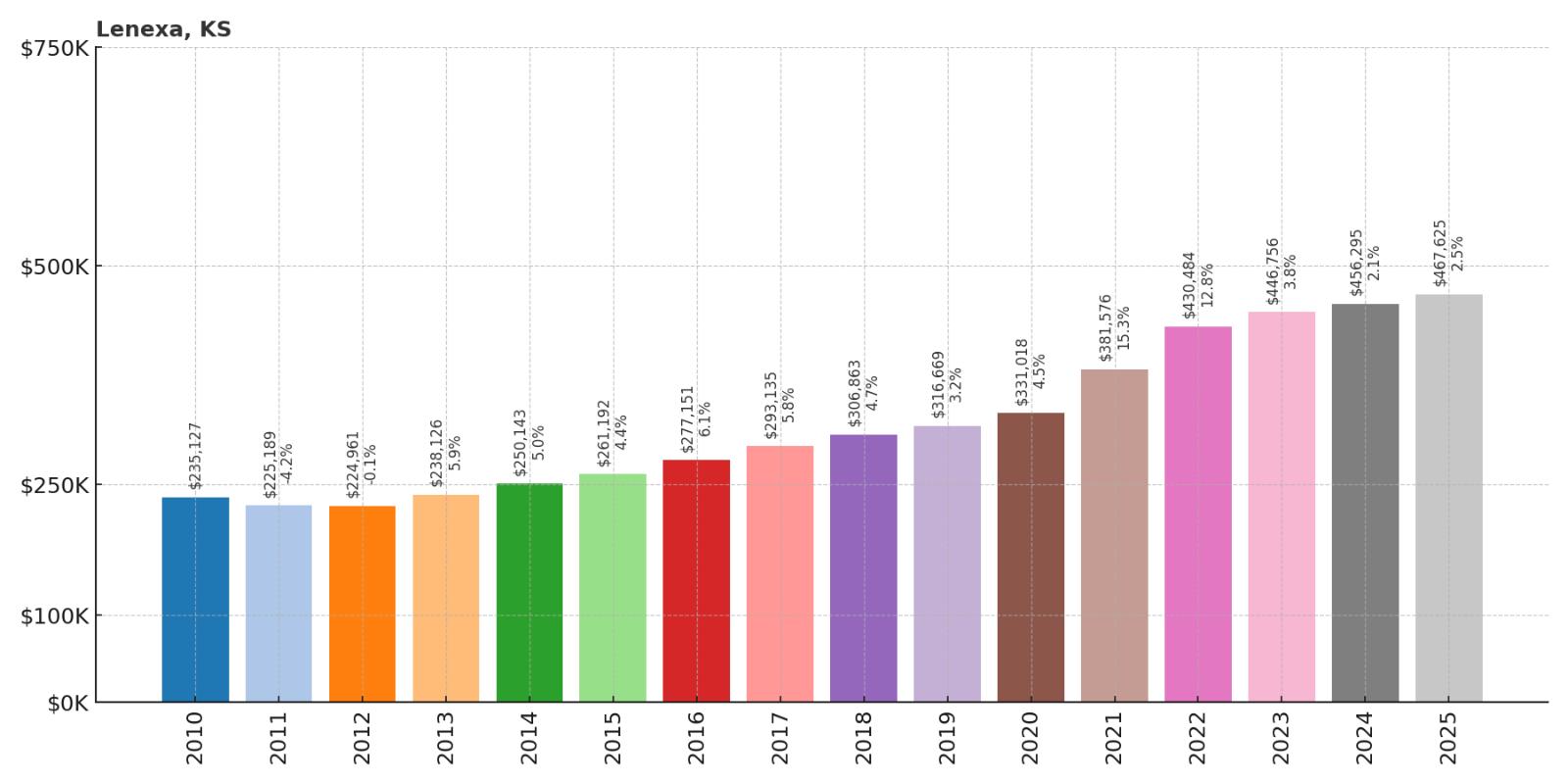
- 2010: $235,127
- 2011: $225,189
- 2012: $224,961
- 2013: $238,126
- 2014: $250,143
- 2015: $261,192
- 2016: $277,151
- 2017: $293,135
- 2018: $306,863
- 2019: $316,669
- 2020: $331,018
- 2021: $381,576
- 2022: $430,484
- 2023: $446,756
- 2024: $456,295
- 2025: $467,625
Lenexa demonstrates solid growth with a 99% increase since 2010, nearly doubling to reach $467,625 in 2025. The Johnson County city started from a higher base price and maintained steady appreciation throughout the period with notable acceleration after 2020. Lenexa offers excellent amenities, corporate employment, and strategic location.
Why Lenexa?

Why are people willing to pay so much to live here? What’s special about it?
Lenexa attracts families and professionals with top-rated schools, extensive parks and recreation facilities, and major corporate employers that provide local job opportunities. The city offers diverse housing options, excellent municipal services, and cultural amenities including performing arts venues. Residents appreciate the balance of suburban comfort with urban sophistication.
The area features comprehensive amenities including golf courses, shopping centers, and restaurants while maintaining family-friendly neighborhoods and community events. Lenexa’s strategic location provides easy access to Kansas City employment while offering suburban lifestyle benefits and quality municipal services.
How Lenexa Rose to Prominence
Lenexa was incorporated in 1907 and remained a small farming community until post-World War II suburban development. The city was named after a Shawnee chief’s wife and grew slowly as an agricultural center. Modern development began in the 1960s with residential subdivisions and commercial centers.
Major growth occurred with corporate relocations in the 1970s and 1980s, establishing Lenexa as both a residential and employment center. The city’s strategic planning attracted major businesses while maintaining high-quality residential areas. Lenexa became known for excellent schools, comprehensive amenities, and business-friendly policies that continue to drive growth.
3 Interesting Tidbits
- Corporate Hub – Lenexa hosts numerous corporate headquarters and business parks that provide local employment and contribute to economic stability and tax base.
- Sar-Ko-Par Trails Park – This 83-acre park offers trails, fishing, and recreational facilities that provide residents with extensive outdoor activity opportunities.
- Lenexa Public Market – The city’s public market and event space serves as a community gathering place and supports local vendors and cultural events.
10. Overland Park – 103% Home Price Increase Since 2010

- 2010: $230,747
- 2011: $221,700
- 2012: $223,920
- 2013: $239,533
- 2014: $251,181
- 2015: $264,335
- 2016: $279,425
- 2017: $295,680
- 2018: $311,301
- 2019: $319,418
- 2020: $332,328
- 2021: $383,386
- 2022: $429,308
- 2023: $448,299
- 2024: $461,901
- 2025: $469,289
Overland Park shows solid growth with a 103% increase since 2010, more than doubling to reach $469,289 in 2025. As Kansas’s second-largest city and Johnson County’s major urban center, Overland Park maintained steady appreciation with acceleration after 2020. The city offers comprehensive amenities and serves as a major employment hub.
Why Overland Park?
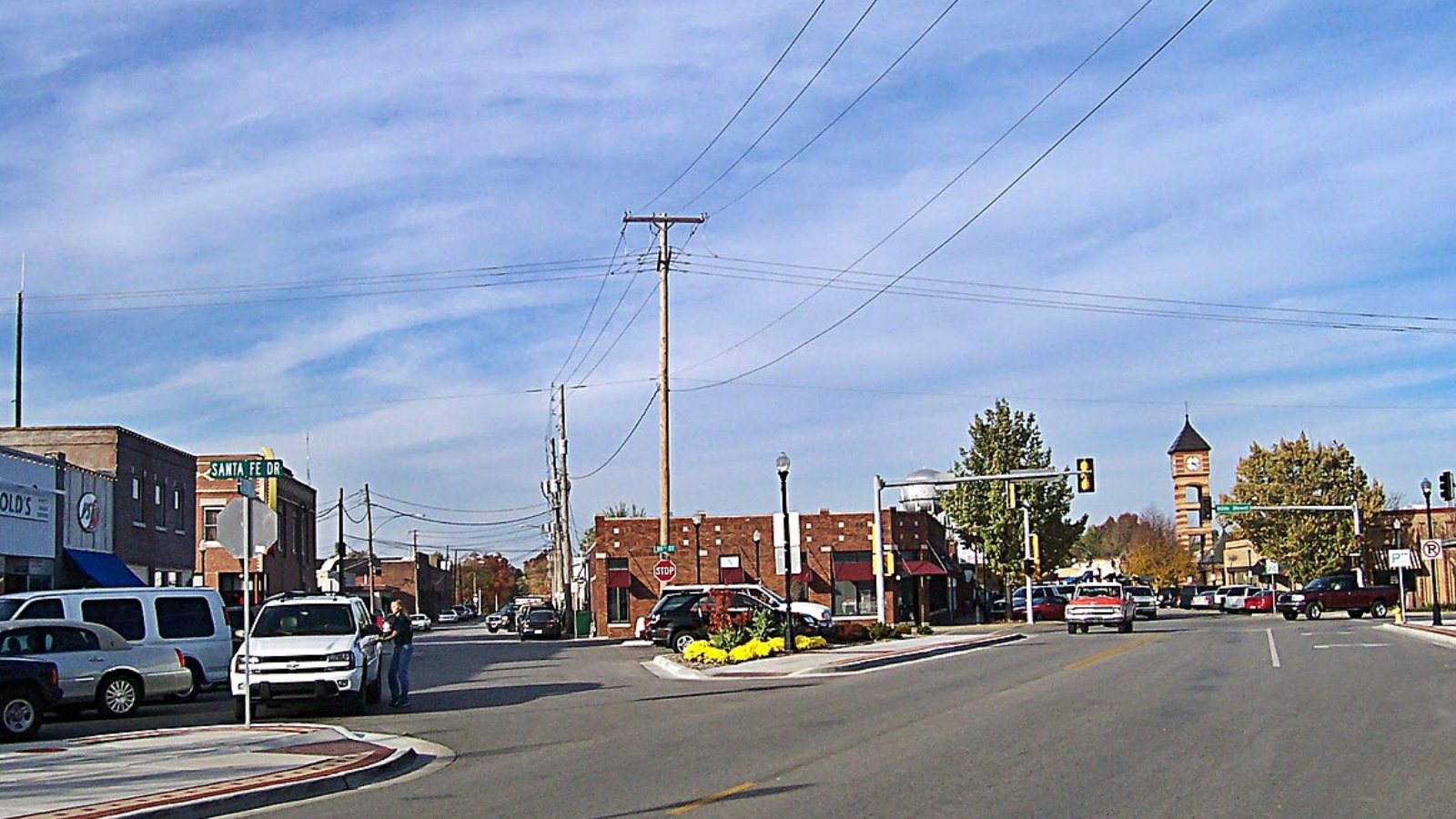
Why are people willing to pay so much to live here? What’s special about it?
Overland Park attracts residents with excellent schools, comprehensive municipal services, and diverse employment opportunities in corporate offices, healthcare, and professional services. The city offers extensive shopping, dining, and entertainment options while maintaining family-friendly neighborhoods and parks. Many residents work locally rather than commuting to Kansas City.
The area provides urban amenities with suburban character, including major shopping centers, cultural venues, and recreational facilities. Overland Park’s size and resources allow for comprehensive services and amenities while maintaining neighborhood-level community engagement and quality schools throughout the district.
How Overland Park Rose to Prominence
Overland Park was incorporated in 1960, growing from rural farmland to become Kansas’s second-largest city through planned suburban development. Early growth focused on residential subdivisions and shopping centers that served the expanding Kansas City metropolitan area. The city’s strategic planning emphasized quality development and municipal services.
Major growth occurred with corporate relocations and business development in the 1970s and 1980s. Overland Park became a regional employment center while maintaining residential appeal through excellent schools and comprehensive amenities. The city’s continued investment in infrastructure and economic development maintains its position as a premier suburban community.
3 Interesting Tidbids
- Corporate Center – Overland Park serves as headquarters for numerous Fortune 500 companies and major corporations, creating a diverse economic base and high-quality employment opportunities.
- Overland Park Arboretum – The 300-acre botanical garden provides residents and visitors with extensive trails, gardens, and educational programs in a beautiful natural setting.
- Convention Center – The Overland Park Convention Center hosts major events and conferences, contributing to the city’s economic development and regional prominence.
9. Prairie Village – 124% Home Price Increase Since 2010
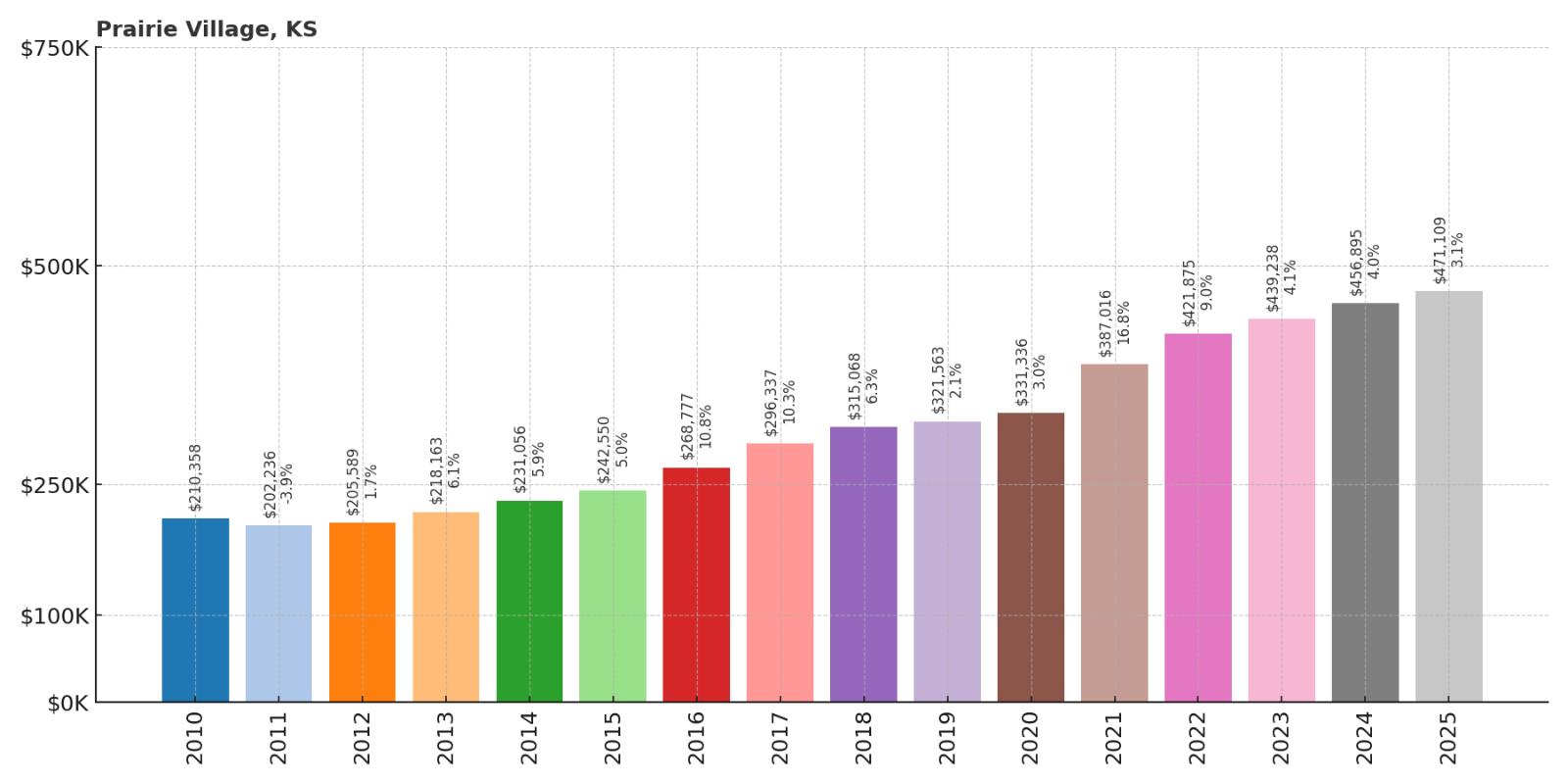
- 2010: $210,358
- 2011: $202,236
- 2012: $205,589
- 2013: $218,163
- 2014: $231,056
- 2015: $242,550
- 2016: $268,777
- 2017: $296,337
- 2018: $315,068
- 2019: $321,563
- 2020: $331,336
- 2021: $387,016
- 2022: $421,875
- 2023: $439,238
- 2024: $456,895
- 2025: $471,109
Prairie Village demonstrates strong growth with a 124% increase since 2010, more than doubling to reach $471,109 in 2025. The Johnson County city maintained steady appreciation with notable acceleration after 2016 and again after 2020. This established community offers mature neighborhoods and excellent location near major amenities.
Why Prairie Village?

Why are people willing to pay so much to live here? What’s special about it?
Prairie Village attracts families with excellent schools, mature tree-lined neighborhoods, and proximity to the Country Club Plaza shopping and entertainment district. The city offers a mix of architectural styles, established communities, and walkable neighborhoods with local shops and restaurants. Residents value the combination of suburban comfort and urban accessibility.
The area provides convenient access to Kansas City employment and cultural opportunities while maintaining suburban character and community amenities. Prairie Village’s central location and established infrastructure make it particularly attractive for professionals and families seeking established neighborhoods with modern conveniences.
How Prairie Village Rose to Prominence
Prairie Village was developed in the 1940s as part of J.C. Nichols’ Country Club District expansion into Johnson County. The planned community featured winding streets, architectural diversity, and neighborhood shopping centers that became models for suburban development. The city incorporated in 1951 to maintain local control over development and services.
Growth continued through the 1950s and 1960s with additional residential areas and the Village Shopping Center, one of the first suburban shopping centers in the region. Prairie Village’s strategic location between Kansas City and Johnson County employment centers, combined with quality schools and established neighborhoods, maintains strong residential demand.
3 Interesting Tidbits
- Village Shopping Center – One of the first suburban shopping centers in the region, the Village Shops continue to serve as a community focal point with local businesses and restaurants.
- Architectural Diversity – Prairie Village features diverse architectural styles including Colonial, Tudor, and Ranch homes that create neighborhood character and visual interest.
- R.A. Long Park – The city’s main park provides recreational facilities, walking trails, and community event space that serves as a neighborhood gathering place.
8. Eastborough – 82% Home Price Increase Since 2010
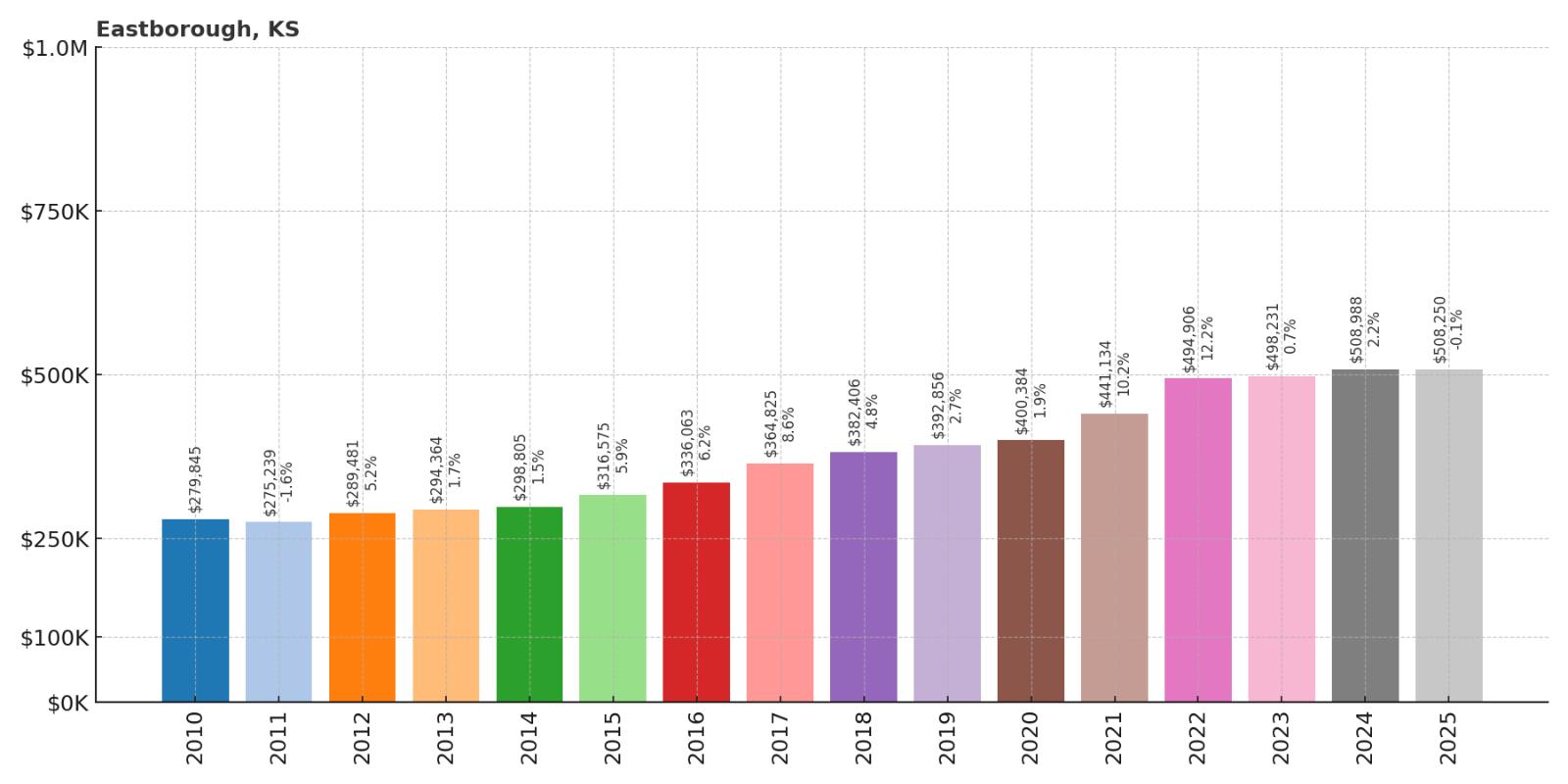
- 2010: $279,845
- 2011: $275,239
- 2012: $289,481
- 2013: $294,364
- 2014: $298,805
- 2015: $316,575
- 2016: $336,063
- 2017: $364,825
- 2018: $382,406
- 2019: $392,856
- 2020: $400,384
- 2021: $441,134
- 2022: $494,906
- 2023: $498,231
- 2024: $508,988
- 2025: $508,250
Eastborough shows solid growth with an 82% increase since 2010, reaching $508,250 in 2025. The Sedgwick County city started from a high base price and maintained steady appreciation throughout the period. This exclusive enclave within Wichita offers luxury living with prestige and comprehensive amenities.
Why Eastborough?
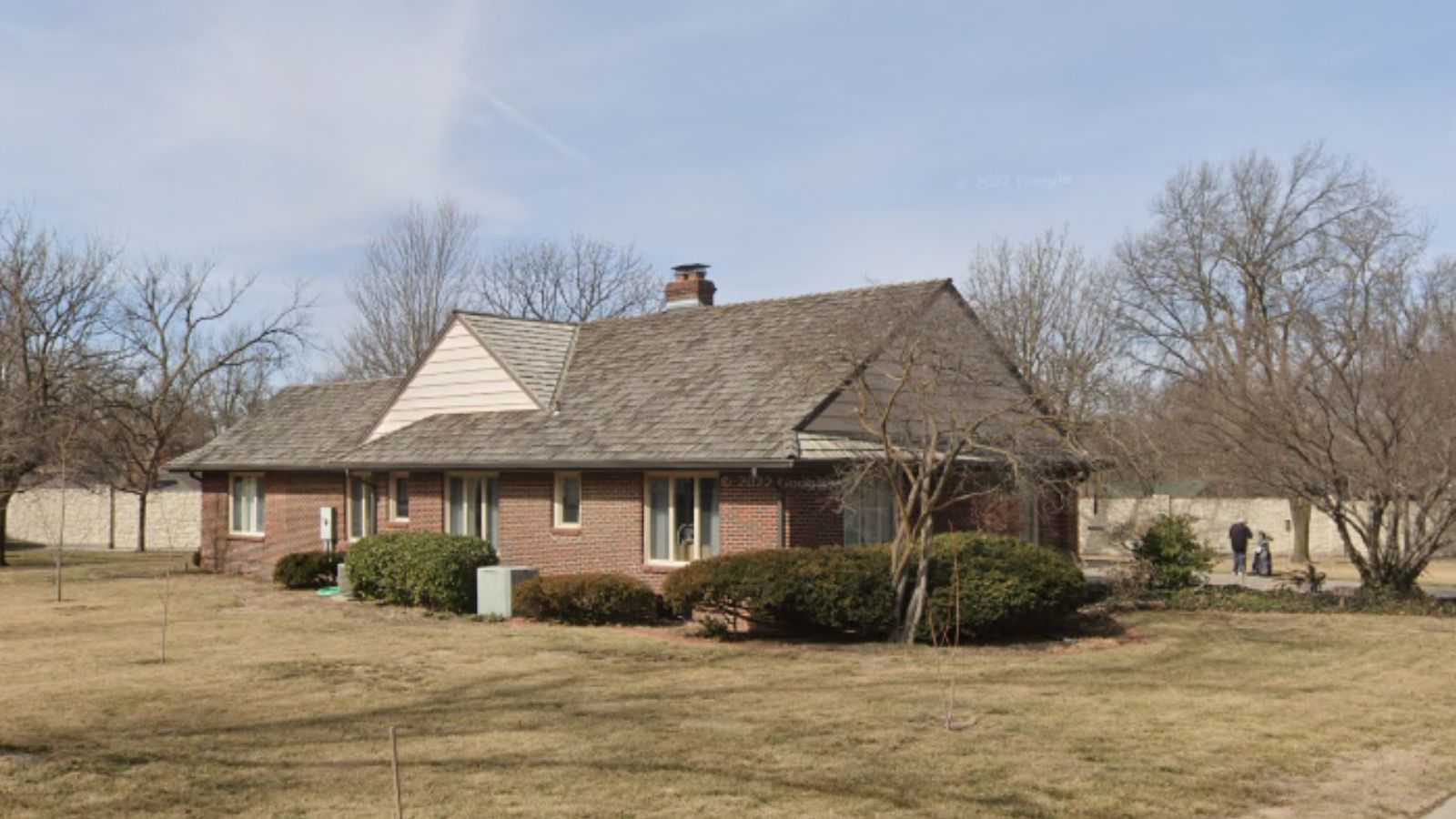
Why are people willing to pay so much to live here? What’s special about it?
Eastborough appeals to affluent families seeking luxury living within Wichita’s metropolitan area with exclusive neighborhoods, top-rated schools, and prestigious addresses. The small city offers custom homes, mature landscaping, and country club amenities while providing easy access to Wichita employment and cultural opportunities. Residents value the privacy and prestige of this exclusive community.
The area features large lots, architectural significance, and comprehensive municipal services that maintain property values and quality of life. Eastborough’s location within Wichita provides urban convenience while offering suburban tranquility and community exclusivity that attracts successful professionals and business leaders.
How Eastborough Rose to Prominence
Eastborough was incorporated in 1937 as an exclusive residential enclave within Wichita, designed to attract affluent families seeking luxury living with country club amenities. The community was planned around the Wichita Country Club and featured large lots, custom homes, and restrictive covenants that maintained high standards and property values.
The city’s development attracted business leaders, professionals, and wealthy families who wanted luxury living with Wichita convenience. Eastborough’s strategic location, exclusive character, and comprehensive municipal services created a prestigious community that continues to attract affluent residents and maintain premium property values throughout economic cycles.
3 Interesting Tidbits
- Wichita Country Club – The exclusive country club anchors the community and provides residents with golf, dining, and social facilities that enhance the area’s prestige and appeal.
- Municipal Services – Eastborough provides comprehensive municipal services including police, public works, and administration that maintain the community’s high standards and quality of life.
- Architectural Standards – The city maintains strict building codes and architectural guidelines that preserve the community’s luxury character and protect property values.
7. Fairway – 103% Home Price Increase Since 2010
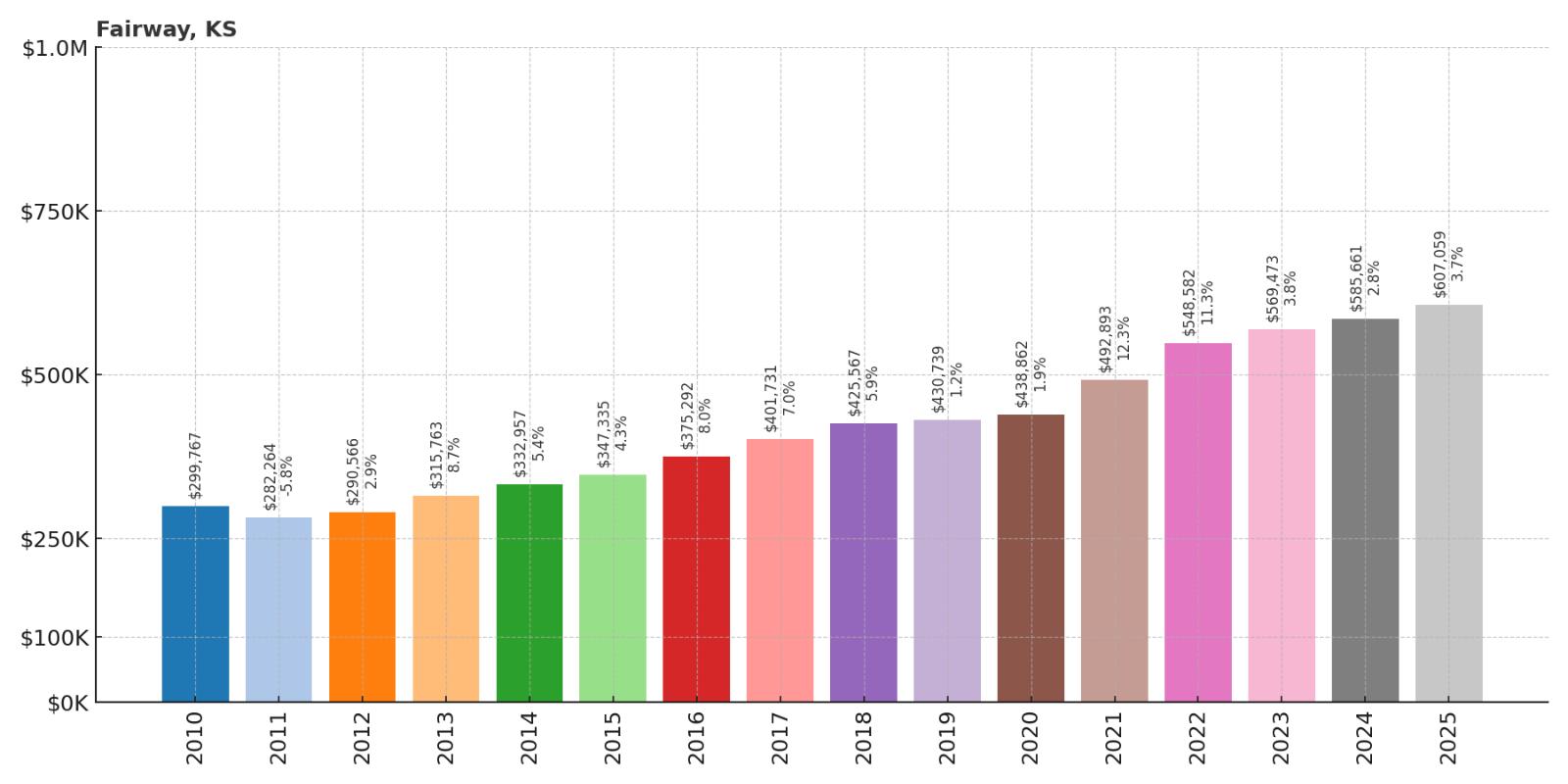
- 2010: $299,767
- 2011: $282,264
- 2012: $290,566
- 2013: $315,763
- 2014: $332,957
- 2015: $347,335
- 2016: $375,292
- 2017: $401,731
- 2018: $425,567
- 2019: $430,739
- 2020: $438,862
- 2021: $492,893
- 2022: $548,582
- 2023: $569,473
- 2024: $585,661
- 2025: $607,059
Fairway shows solid growth with a 103% increase since 2010, more than doubling to reach $607,059 in 2025. The Johnson County city started from a high base price and maintained steady appreciation throughout the period with acceleration after 2020. This exclusive community offers luxury living with prime location and prestigious amenities.
Why Fairway?
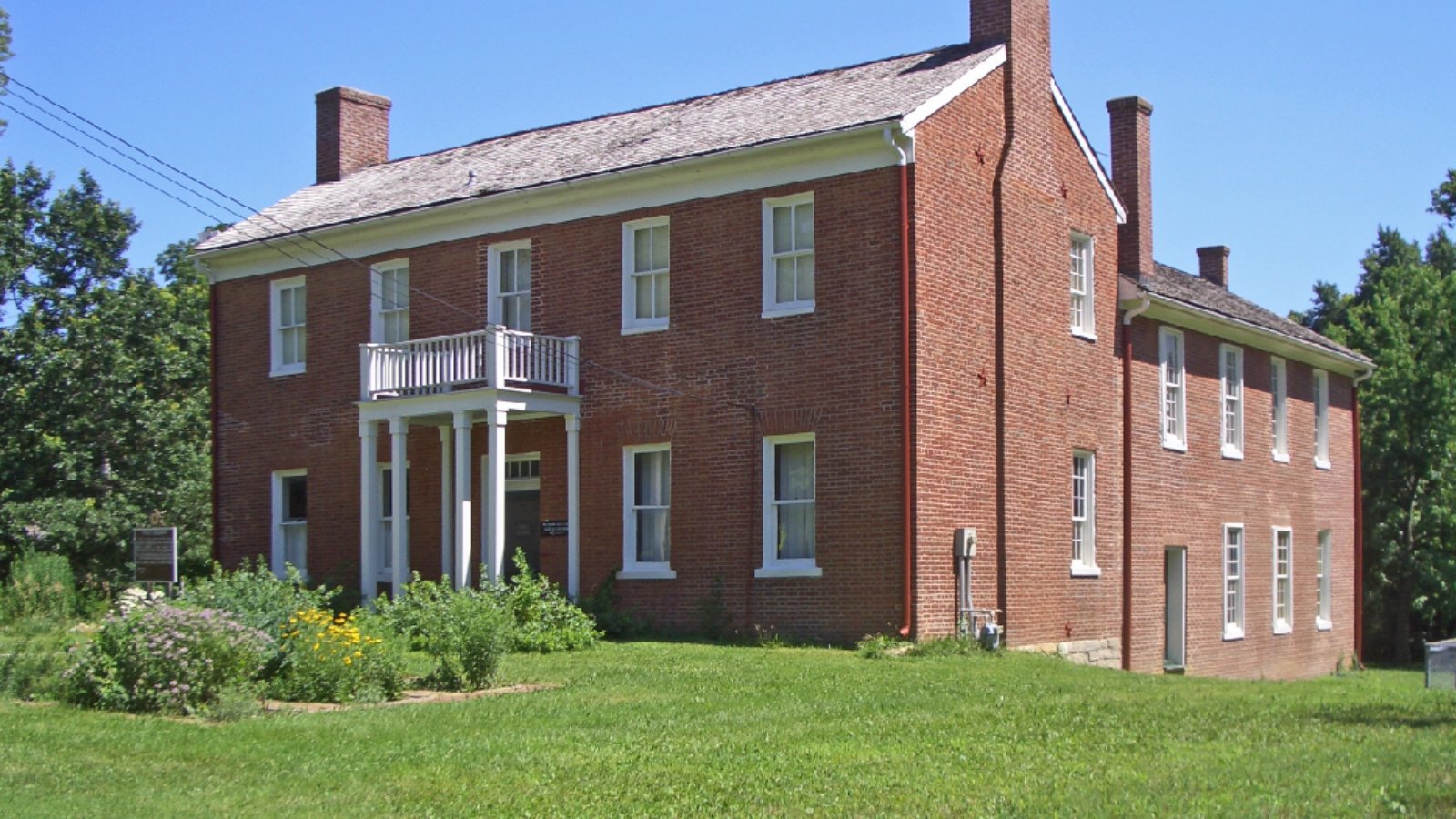
Why are people willing to pay so much to live here? What’s special about it?
Fairway attracts affluent families with its prestigious location adjacent to the Country Club Plaza, excellent schools, and exclusive residential character. The small city offers luxury homes, mature neighborhoods, and prime access to Kansas City’s premier shopping and entertainment district. Residents value the combination of suburban exclusivity with urban sophistication.
The area provides walking access to high-end shopping, dining, and cultural opportunities while maintaining residential tranquility and community character. Fairway’s strategic location and limited housing supply create premium property values supported by sustained demand from successful professionals and business leaders.
How Fairway Rose to Prominence
Fairway was developed in the 1920s as part of J.C. Nichols’ Country Club District, designed as an exclusive residential community adjacent to the Country Club Plaza. The city incorporated in 1949 to maintain local control and preserve its residential character. Early residents included business executives and professionals attracted by the prestigious location and luxury amenities.
The community’s reputation grew through careful planning, architectural standards, and proximity to Kansas City’s cultural and business centers. Fairway’s strategic location between the Country Club Plaza and Johnson County employment centers created sustained demand from affluent buyers. The city’s commitment to maintaining exclusivity and quality continues to support premium property values.
3 Interesting Tidbits
- Country Club Plaza Access – Fairway provides residents with walking access to Kansas City’s premier shopping, dining, and entertainment district, enhancing lifestyle and property values.
- Architectural Heritage – The city features diverse architectural styles including Tudor, Colonial, and Contemporary designs that create neighborhood character and visual appeal.
- Municipal Excellence – Fairway maintains exceptional municipal services and infrastructure that preserve the community’s luxury character and support high property values.
6. Westwood Hills – 99% Home Price Increase Since 2010

- 2010: $309,584
- 2011: $307,827
- 2012: $312,162
- 2013: $331,465
- 2014: $347,581
- 2015: $354,887
- 2016: $368,713
- 2017: $393,719
- 2018: $416,367
- 2019: $426,418
- 2020: $440,496
- 2021: $486,556
- 2022: $536,776
- 2023: $576,424
- 2024: $592,894
- 2025: $616,370
Westwood Hills demonstrates solid growth with a 99% increase since 2010, nearly doubling to reach $616,370 in 2025. The Johnson County city started from a high base price and maintained steady appreciation throughout the period with notable acceleration after 2020. This exclusive community offers luxury living with prestige and prime location.
Why Westwood Hills?
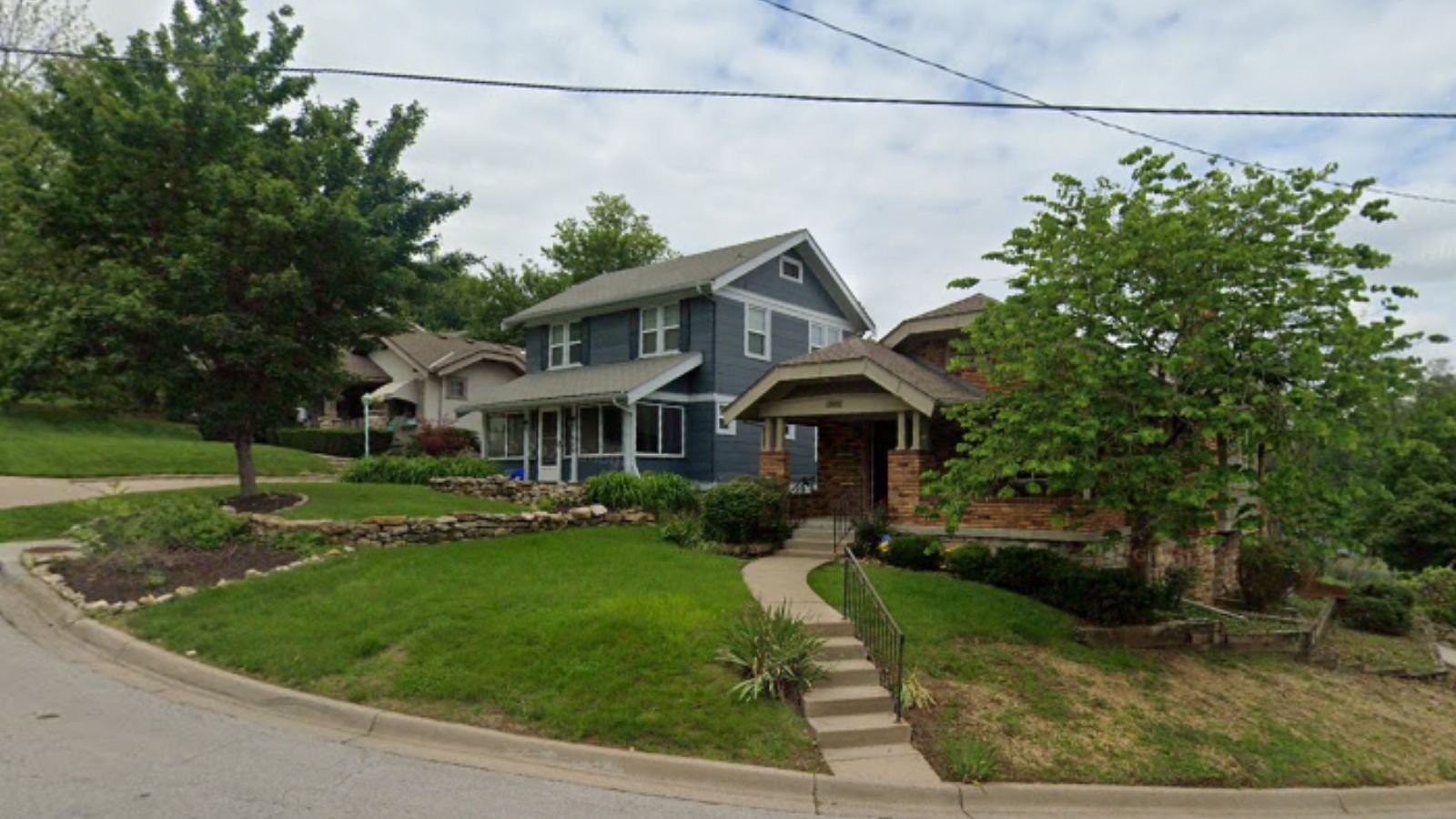
Why are people willing to pay so much to live here? What’s special about it?
Westwood Hills attracts affluent residents with exclusive neighborhoods, luxury homes, and strategic location near major employment centers and cultural amenities. The small city offers privacy, prestige, and top-rated schools while providing easy access to Kansas City opportunities. Residents value the combination of suburban tranquility with metropolitan convenience.
The area features custom homes, mature landscaping, and comprehensive municipal services that maintain property values and quality of life. Westwood Hills’ location and exclusive character create sustained demand from successful professionals seeking luxury residential environments with community prestige.
How Westwood Hills Rose to Prominence
Westwood Hills was developed in the 1940s as an upscale residential community in Johnson County, designed to attract affluent families seeking luxury suburban living near Kansas City. The city incorporated in 1949 to maintain local control over development and municipal services. Early development featured custom homes and large lots that established the community’s exclusive character.
Growth continued through strategic planning that preserved residential character while accommodating quality development. Westwood Hills’ reputation for excellence and strategic location attracted continued investment from affluent buyers throughout economic cycles. The city’s commitment to maintaining high standards and exclusive character continues to support premium property values.
3 Interesting Tidbits
- Tomahawk Ridge Park – The city’s main recreational facility provides residents with tennis courts, walking trails, and community gathering spaces in a beautifully maintained setting.
- Strategic Location – Westwood Hills’ position between Kansas City and Johnson County employment centers makes it highly desirable for affluent professionals and business leaders.
- Municipal Services – The city provides exceptional municipal services including police, public works, and administration that maintain community standards and property values.
5. Bucyrus – 142% Home Price Increase Since 2010
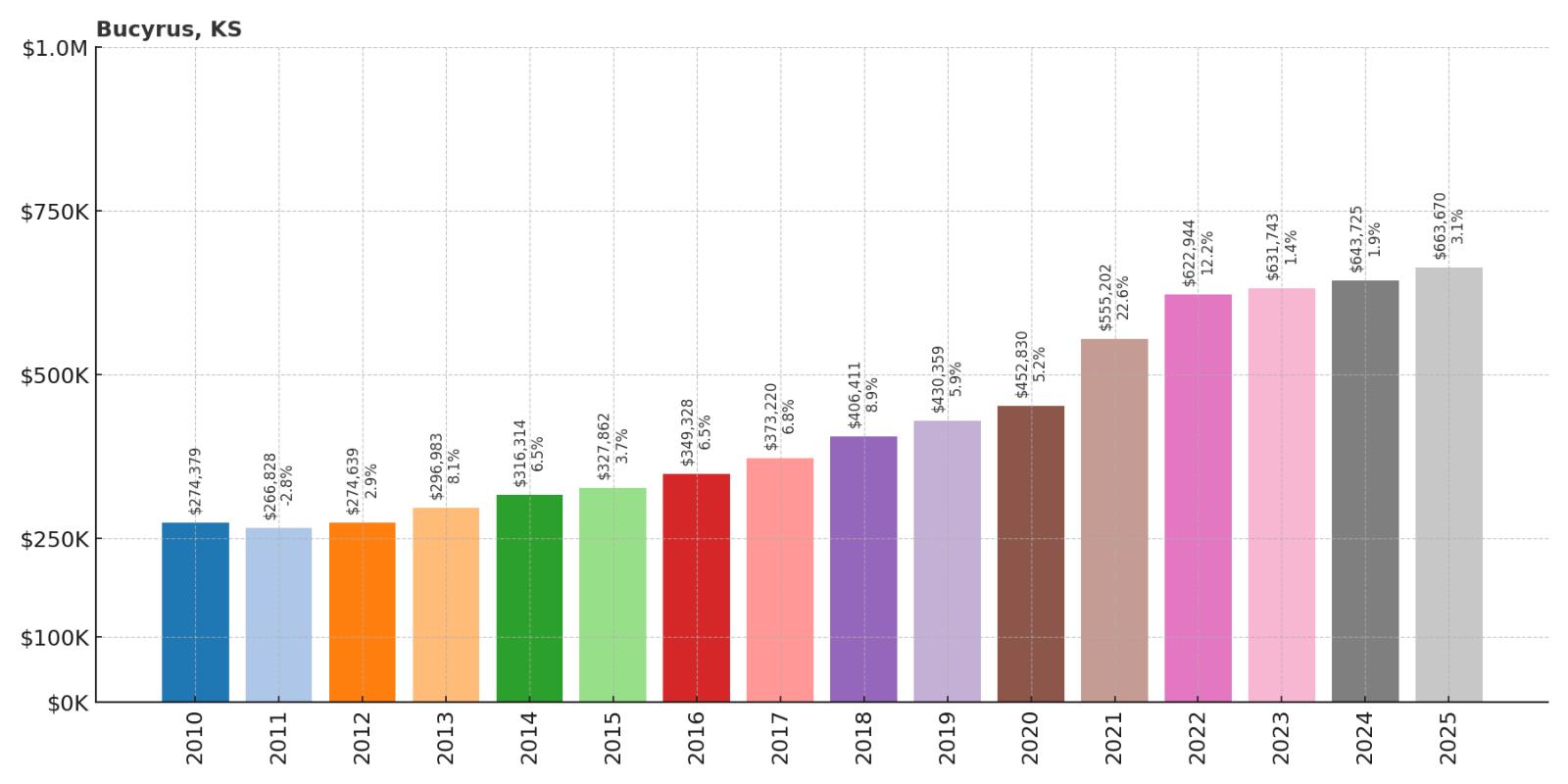
- 2010: $274,379
- 2011: $266,828
- 2012: $274,639
- 2013: $296,983
- 2014: $316,314
- 2015: $327,862
- 2016: $349,328
- 2017: $373,220
- 2018: $406,411
- 2019: $430,359
- 2020: $452,830
- 2021: $555,202
- 2022: $622,944
- 2023: $631,743
- 2024: $643,725
- 2025: $663,670
Bucyrus shows exceptional growth with a 142% increase since 2010, reaching $663,670 in 2025. The Miami County town maintained steady appreciation throughout the period with dramatic acceleration after 2020. This small community offers rural luxury with proximity to Kansas City employment and recreational opportunities.
Why Bucyrus?

Why are people willing to pay so much to live here? What’s special about it?
Bucyrus appeals to affluent buyers seeking rural luxury with large lots, custom homes, and agricultural landscapes while maintaining reasonable access to Kansas City employment. The small community offers privacy, natural beauty, and exclusivity that attracts successful professionals and business leaders. Residents value the combination of country living with metropolitan convenience.
The area provides opportunities for equestrian activities, outdoor recreation, and rural lifestyle benefits while maintaining modern amenities and infrastructure. Bucyrus’ location offers scenic beauty and tranquility that contrasts favorably with suburban density while providing access to urban employment and cultural opportunities.
How Bucyrus Rose to Prominence
Bucyrus was established in the mid-1800s as a small farming community in Miami County, named after Bucyrus, Ohio. The town remained primarily agricultural throughout most of its history, serving local farming operations and maintaining rural character. Early development centered on grain farming and livestock operations.
Recent growth reflects demand for rural luxury properties within commuting distance of Kansas City. Bucyrus’ agricultural character and large available lots attracted affluent buyers seeking country estates and custom homes. The area’s natural beauty and rural setting became premium amenities for successful professionals escaping urban congestion while maintaining metropolitan access.
3 Interesting Tidbits
- Hillsdale Lake Access – Bucyrus provides convenient access to Hillsdale Lake recreation, offering boating, fishing, and outdoor activities that enhance the area’s appeal to affluent buyers.
- Equestrian Properties – The area features numerous properties with stables, riding facilities, and pasture land that attract horse enthusiasts and rural lifestyle seekers.
- Agricultural Heritage – Bucyrus maintains connections to its farming roots while accommodating luxury residential development and rural estate properties.
4. Leawood – 89% Home Price Increase Since 2010
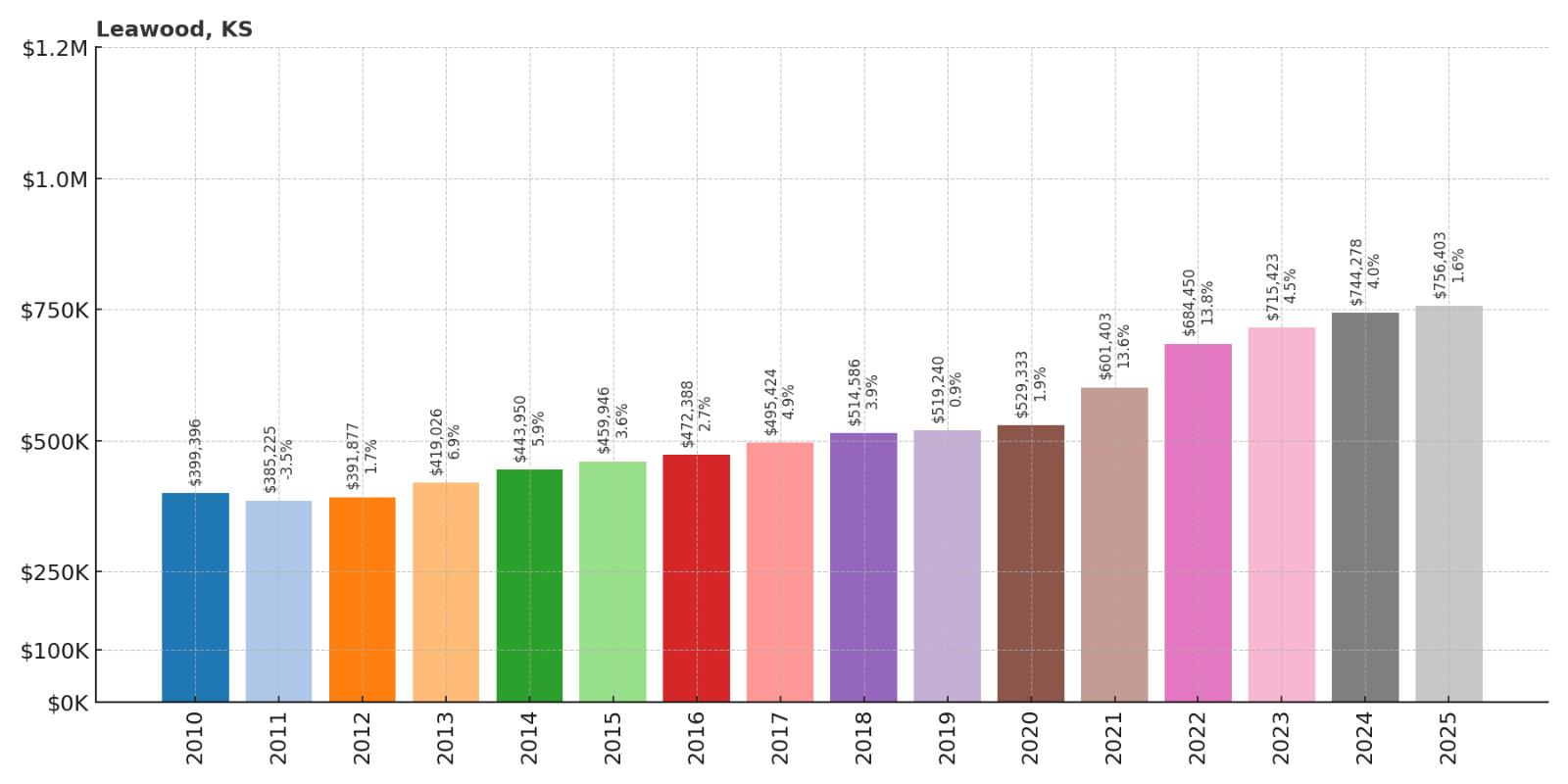
- 2010: $399,396
- 2011: $385,225
- 2012: $391,877
- 2013: $419,026
- 2014: $443,950
- 2015: $459,946
- 2016: $472,388
- 2017: $495,424
- 2018: $514,586
- 2019: $519,240
- 2020: $529,333
- 2021: $601,403
- 2022: $684,450
- 2023: $715,423
- 2024: $744,278
- 2025: $756,403
Leawood shows solid growth with an 89% increase since 2010, reaching $756,403 in 2025. The Johnson County city started from the highest base price among all communities and maintained steady appreciation throughout the period. As one of Kansas’s most exclusive communities, Leawood offers comprehensive luxury amenities and prestigious addresses.
Why Leawood?
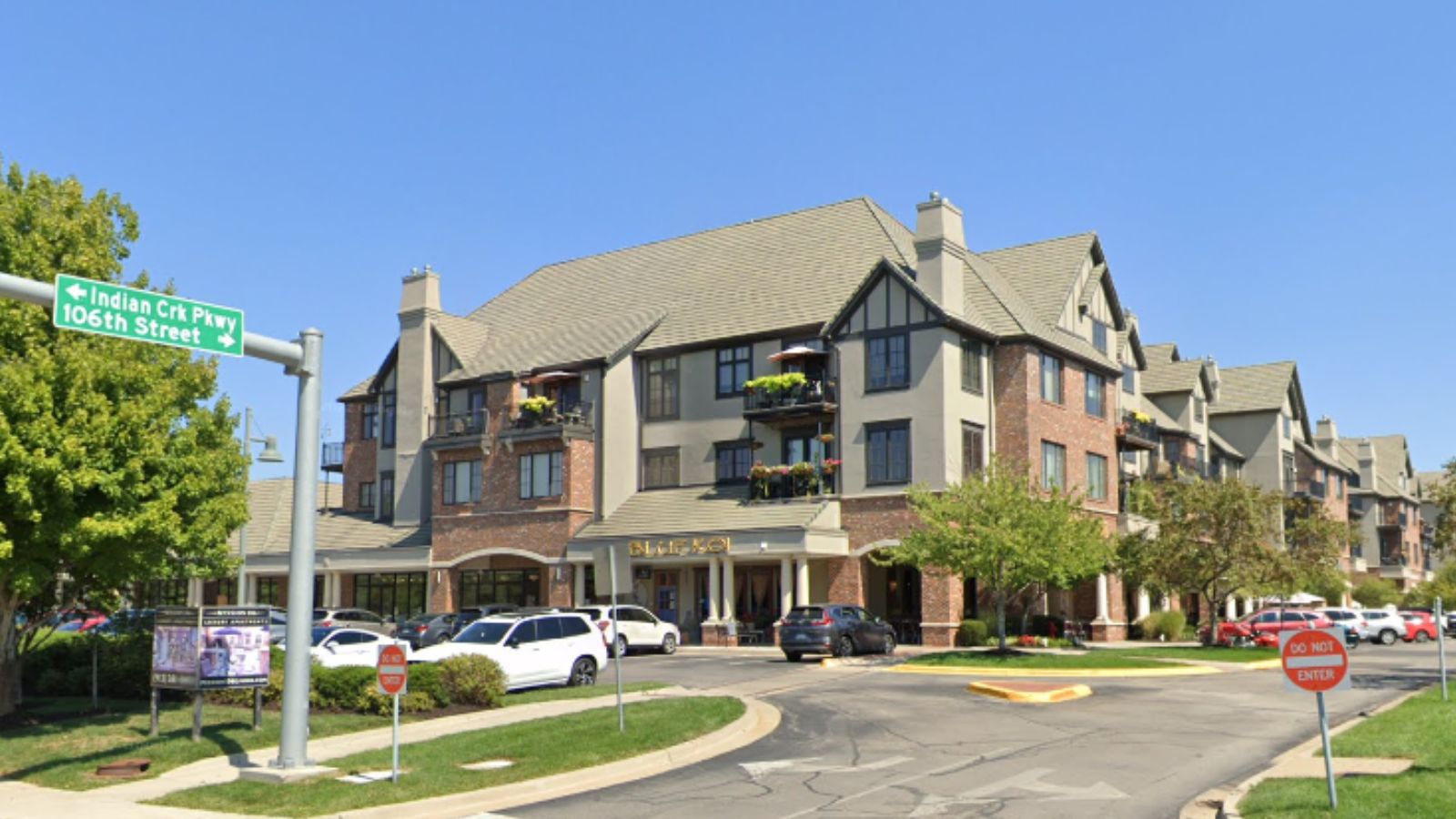
Why are people willing to pay so much to live here? What’s special about it?
Leawood attracts affluent families with top-rated schools, luxury amenities, and prestigious addresses that provide social status and investment value. The city offers comprehensive municipal services, extensive parks and recreation facilities, and upscale shopping and dining options. Residents value the combination of luxury living with family-friendly community amenities and excellent educational opportunities.
The area features custom homes, golf course communities, and exclusive neighborhoods that maintain property values through architectural standards and comprehensive municipal services. Leawood’s reputation for excellence and strategic location create sustained demand from successful professionals, business leaders, and affluent families throughout the region.
How Leawood Rose to Prominence
Leawood was incorporated in 1948 as suburban development expanded into southern Johnson County, designed from the beginning as an upscale residential community. Early development featured large lots, custom homes, and country club amenities that attracted affluent Kansas City area families. The city’s strategic planning emphasized quality and exclusivity from its founding.
Growth accelerated with the development of Town Center Plaza and additional luxury residential areas in the 1980s and 1990s. Leawood’s investment in schools, parks, and municipal services created comprehensive amenities that attracted continued affluent migration. The city’s reputation for excellence in education, public safety, and quality of life maintains strong residential demand and premium property values.
3 Interesting Tidbits
- Town Center Plaza – Leawood’s upscale shopping center provides residents with luxury retail, dining, and entertainment options that enhance lifestyle and property values.
- Ironhorse Golf Club – The prestigious country club and golf course community represents the pinnacle of luxury living and recreational amenities in the area.
- Educational Excellence – Leawood’s location in the Blue Valley School District provides access to some of Kansas’s highest-rated public schools, attracting affluent families prioritizing education.
3. Mission Woods – 83% Home Price Increase Since 2012
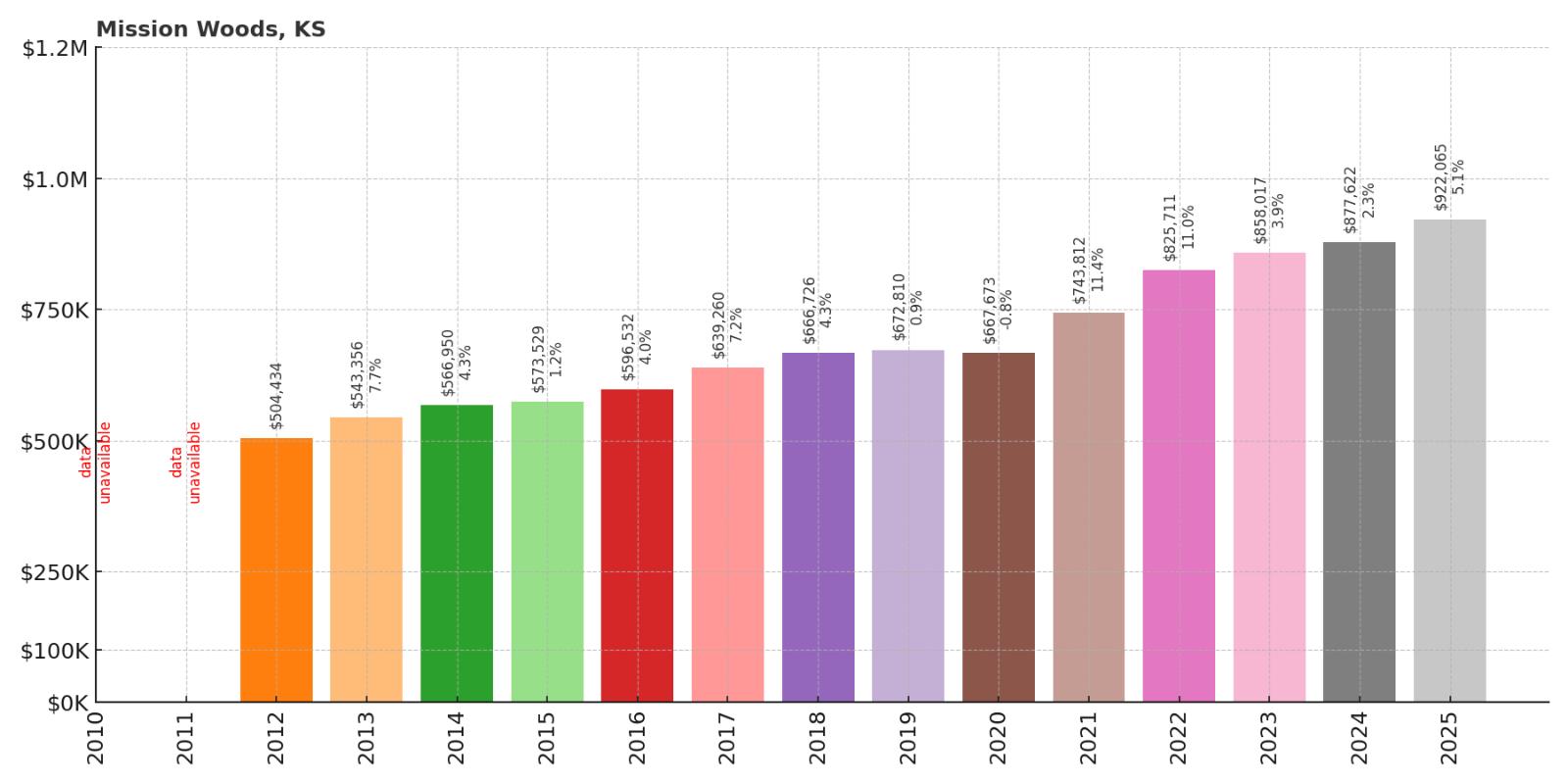
- 2010: N/A
- 2011: N/A
- 2012: $504,434
- 2013: $543,356
- 2014: $566,950
- 2015: $573,529
- 2016: $596,532
- 2017: $639,260
- 2018: $666,726
- 2019: $672,810
- 2020: $667,673
- 2021: $743,812
- 2022: $825,711
- 2023: $858,017
- 2024: $877,622
- 2025: $922,065
Mission Woods shows strong growth with an 83% increase since 2012, reaching $922,065 in 2025. The Johnson County city started from a very high base price and maintained steady appreciation with notable acceleration after 2020. This exclusive enclave offers luxury living with prime location and comprehensive amenities.
Why Mission Woods?
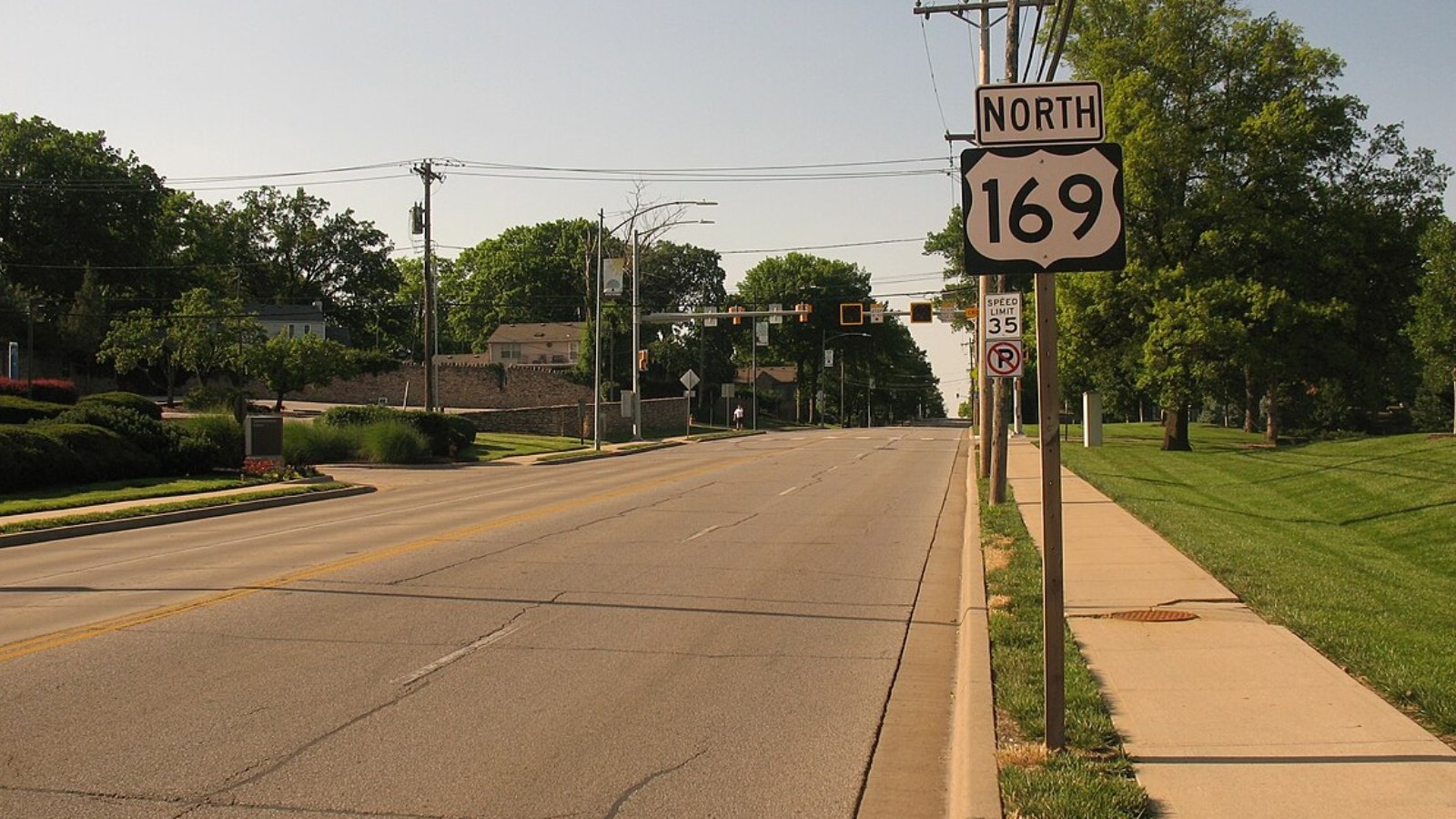
Why are people willing to pay so much to live here? What’s special about it?
Mission Woods attracts ultra-affluent residents with its exclusive character, luxury homes, and prestigious Johnson County location near major employment and cultural centers. The small city offers privacy, architectural significance, and top-rated schools while providing easy access to Kansas City opportunities. Residents value the combination of suburban exclusivity with metropolitan convenience and social prestige.
The area features custom estates, mature landscaping, and comprehensive municipal services that maintain property values and community character. Mission Woods’ limited housing supply and exclusive reputation create sustained demand from successful business leaders, professionals, and affluent families seeking the ultimate in luxury residential living.
How Mission Woods Rose to Prominence
Mission Woods was developed in the 1920s as part of J.C. Nichols’ Country Club District expansion, designed as one of the most exclusive residential enclaves in the Kansas City metropolitan area. The community incorporated in 1949 to maintain strict development standards and preserve its luxury character. Early residents included prominent business leaders and wealthy families attracted by the prestige and exclusivity.
The city’s development emphasized architectural quality, large lots, and comprehensive amenities that established Mission Woods as a premier luxury community. Strategic location near major employment centers and cultural amenities, combined with restrictive development policies, created sustained demand from the region’s most affluent residents. The community’s reputation for excellence continues to attract successful professionals and business leaders.
3 Interesting Tidbits
- Country Club District Heritage – Mission Woods was designed as part of J.C. Nichols’ master-planned Country Club District, representing the pinnacle of early 20th-century suburban luxury planning.
- Architectural Significance – The city features numerous architect-designed homes and estates that represent various luxury styles and contribute to the community’s prestigious character.
- Municipal Services – Mission Woods provides exceptional municipal services including police, public works, and administration that maintain the community’s exclusive standards and property values.
2. Lake Quivira – 73% Home Price Increase Since 2010
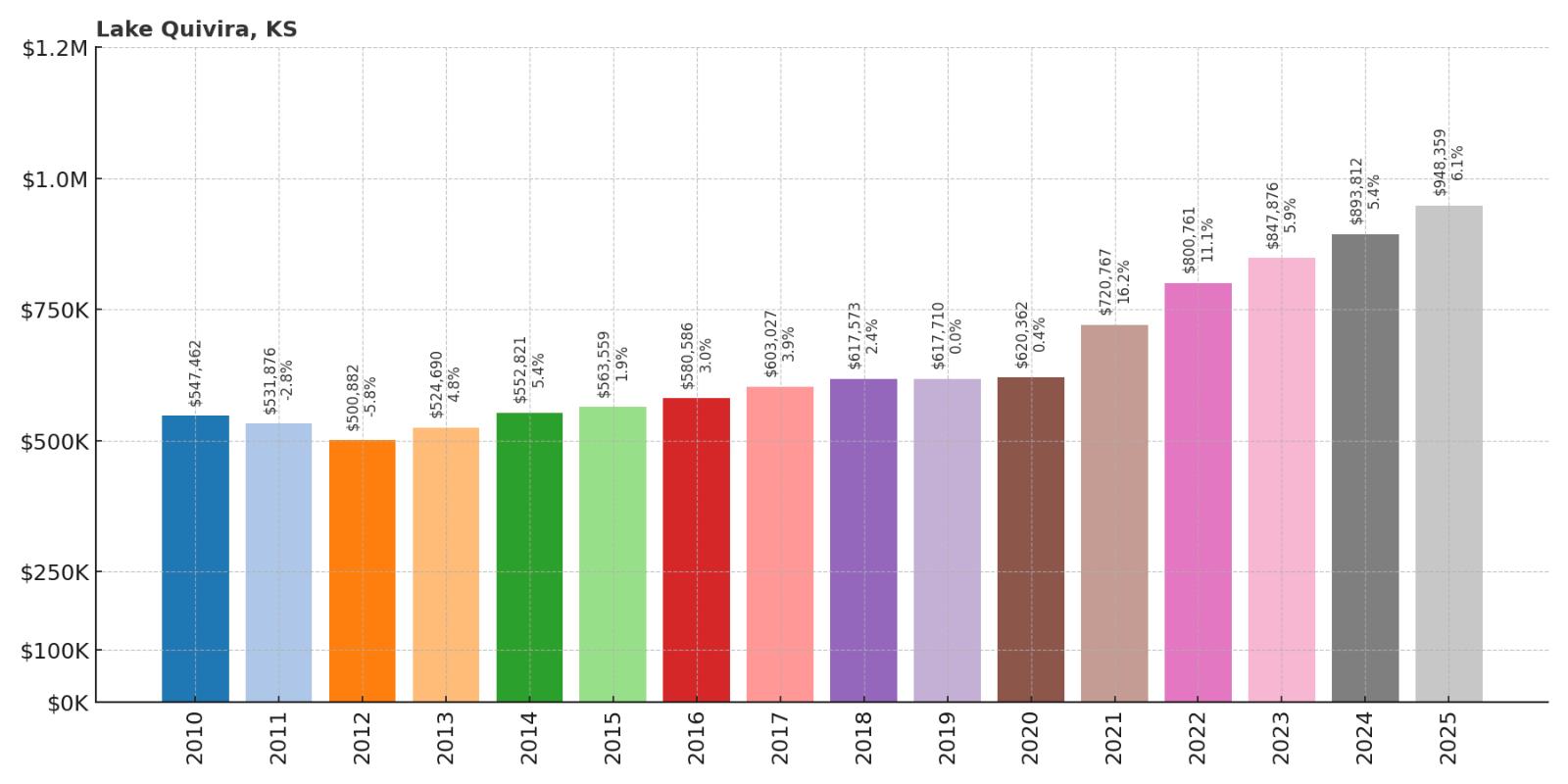
- 2010: $547,462
- 2011: $531,876
- 2012: $500,882
- 2013: $524,690
- 2014: $552,821
- 2015: $563,559
- 2016: $580,586
- 2017: $603,027
- 2018: $617,573
- 2019: $617,710
- 2020: $620,362
- 2021: $720,767
- 2022: $800,761
- 2023: $847,876
- 2024: $893,812
- 2025: $948,359
Lake Quivira shows solid growth with a 73% increase since 2010, reaching $948,359 in 2025. The Johnson County gated community started from a very high base price and maintained steady appreciation with notable acceleration after 2020. This exclusive lakefront community offers resort-style living with comprehensive amenities and natural beauty.
Why Lake Quivira?
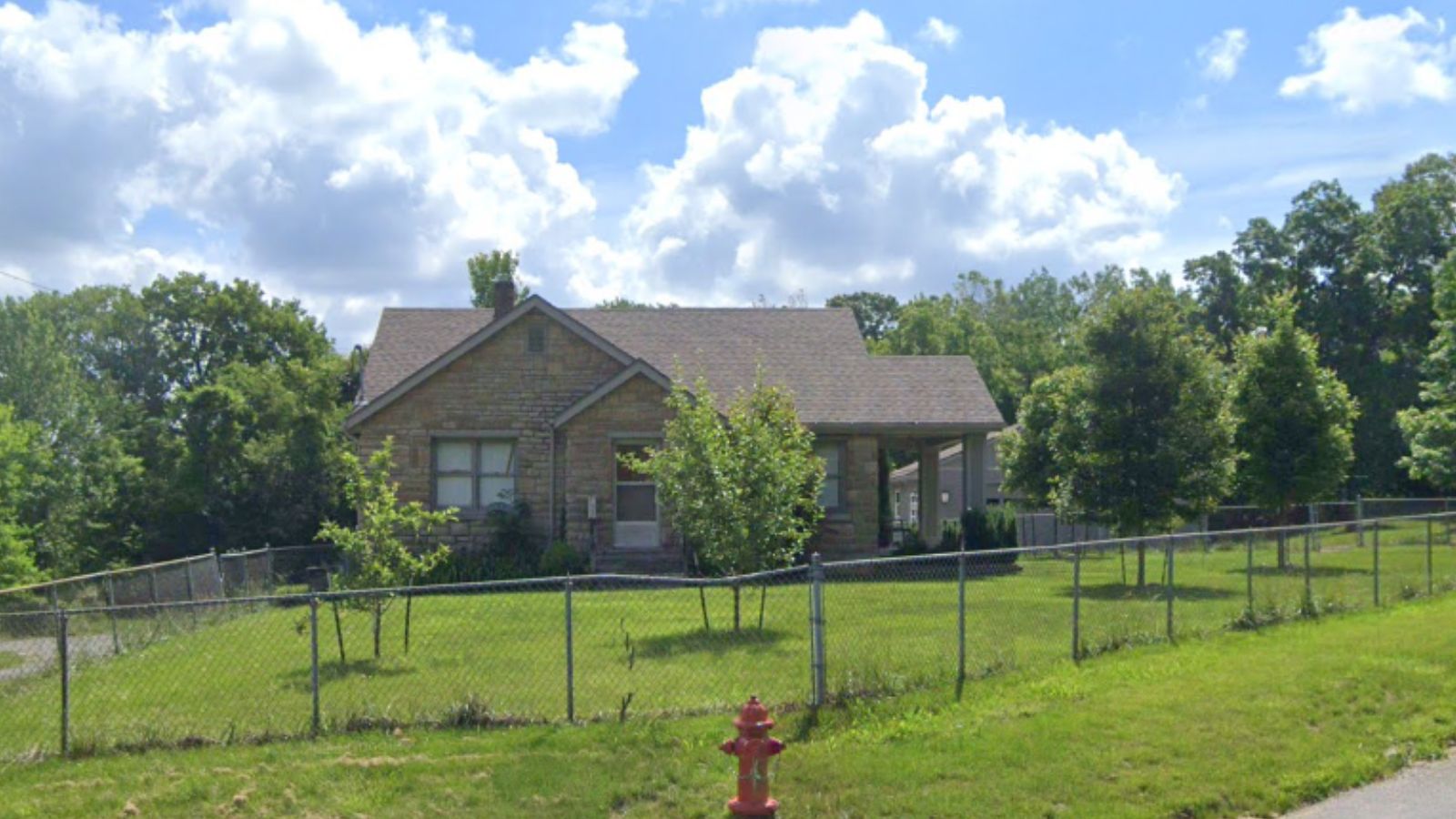
Why are people willing to pay so much to live here? What’s special about it?
Lake Quivira attracts affluent residents seeking exclusive lakefront living with resort-style amenities including a private 300-acre lake, country club, and gated community security. The area offers custom homes, waterfront properties, and comprehensive recreational facilities including golf, boating, and swimming. Residents value the combination of natural beauty, privacy, and luxury amenities within reasonable distance of Kansas City employment.
The gated community provides 24-hour security, private beach access, and exclusive recreational facilities that create a resort lifestyle year-round. Lake Quivira’s limited membership and housing supply maintain exclusivity and property values while offering residents access to boating, fishing, and water sports in a pristine natural setting.
How Lake Quivira Rose to Prominence
Lake Quivira was developed in the 1930s as an exclusive recreational and residential community centered around a private lake created by damming existing waterways. The development was designed as a weekend retreat for wealthy Kansas City area families, featuring custom homes, a country club, and comprehensive recreational amenities. The gated community model provided security and exclusivity from its founding.
Growth evolved from seasonal recreation to year-round luxury living as transportation improved and affluent families sought exclusive residential alternatives. Lake Quivira’s unique combination of lakefront living, country club amenities, and gated security created sustained demand from successful professionals and business leaders. The community’s limited size and exclusive character continue to support premium property values.
3 Interesting Tidbits
- Private Lake – The 300-acre private lake provides residents with exclusive access to boating, fishing, swimming, and water sports in a pristine natural setting maintained by the community.
- Lake Quivira Country Club – The private country club offers golf, dining, and social facilities that serve as the community’s recreational and social center for residents and their guests.
- Gated Security – The community’s 24-hour gated security provides residents with privacy, safety, and exclusivity that enhance both lifestyle and property values.
1. Mission Hills – 88% Home Price Increase Since 2010

- 2010: $834,416
- 2011: $803,527
- 2012: $826,144
- 2013: $885,483
- 2014: $931,424
- 2015: $941,594
- 2016: $980,755
- 2017: $1,004,604
- 2018: $1,032,425
- 2019: $1,032,865
- 2020: $1,021,377
- 2021: $1,175,741
- 2022: $1,369,530
- 2023: $1,441,374
- 2024: $1,464,648
- 2025: $1,570,558
Mission Hills demonstrates solid growth with an 88% increase since 2010, reaching $1,570,558 in 2025. The Johnson County city started from the highest base price of any community on this list and maintained steady appreciation throughout the period. As Kansas’s most expensive residential area, Mission Hills represents the pinnacle of luxury living and social prestige.
Why Mission Hills?
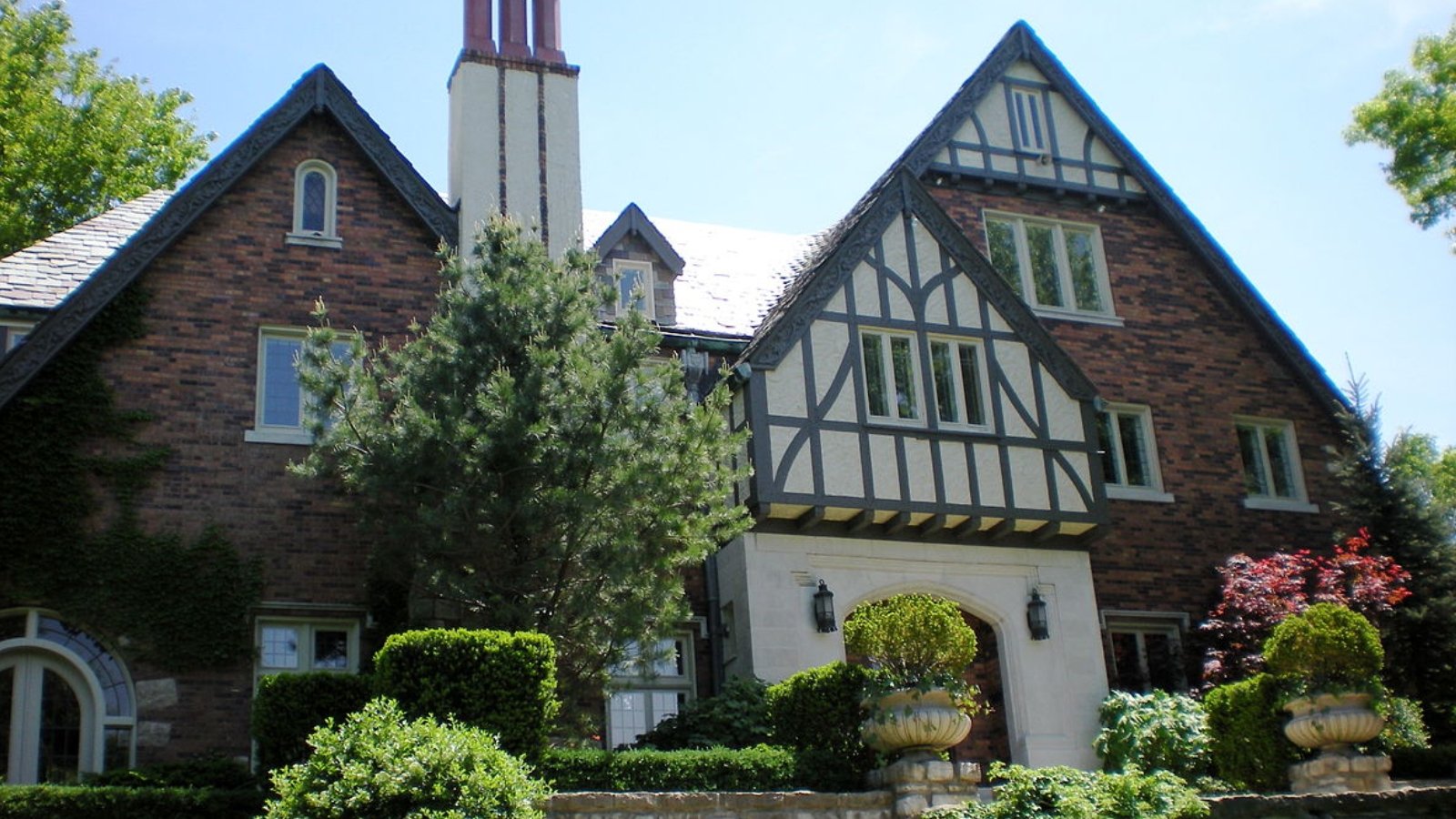
Why are people willing to pay so much to live here? What’s special about it?
Mission Hills attracts the region’s most affluent residents with its unparalleled prestige, architectural significance, and exclusive character as Kansas’s premier luxury community. The area features elegant homes ranging from $1 million to over $7 million, with architectural styles including Tudors, French Country, Colonial, Spanish Revival, and ranch-style houses, and is known as one of the wealthiest suburbs in the area. Residents value the combination of historical significance, social status, and proximity to major employment and cultural centers.
The community offers access to three of the most exclusive country clubs in Kansas City: Indian Hills, Mission Hills, and the official Kansas City Country Club, adding to the appeal for residents seeking an active, socially engaged lifestyle. Mission Hills’ limited housing supply, restrictive development standards, and century-long reputation for excellence create sustained demand from successful business leaders, professionals, and affluent families throughout the region.
How Mission Hills Rose to Prominence
Mission Hills was developed by J.C. Nichols in Johnson County, Kansas, in the 1920s as part of his extensive Country Club District plan, with the area originally settled by an Indian mission in the 1830s—hence its eventual name. In 1924, architect S. Herbert Hare constructed the city’s two most famous landmarks: the reflective pool at the intersection of Ensley Lane, Overhill Road, and Mission Drive and the Verona Columns, which are on the city’s official seal.
Once a vacation spot for Ernest Hemingway (he wrote A Farewell to Arms in the Mission Hills neighborhood in 1928), this community became an idyllic retreat from the bustling city center of Kansas City. The development established Mission Hills as the region’s most prestigious residential address through architectural excellence, comprehensive planning, and exclusive amenities. The community’s century-long reputation for luxury and social prominence continues to attract the region’s most successful residents and maintain the highest property values in Kansas.
3 Interesting Tidbits
- Ernest Hemingway Connection – The famous author wrote “A Farewell to Arms” while living in Mission Hills in 1928, adding literary significance to the community’s cultural heritage.
- Verona Columns – These distinguished landmarks constructed in 1924 by architect S. Herbert Hare are featured on the city’s official seal and serve as iconic symbols of the community’s architectural heritage.
- Country Club Capital – Mission Hills is home to the Kansas City Country Club, the third-oldest country club west of the Mississippi River, and is even home to five-time British Open Champion Tom Watson, who learned his skills at the Kansas City Country Club.

